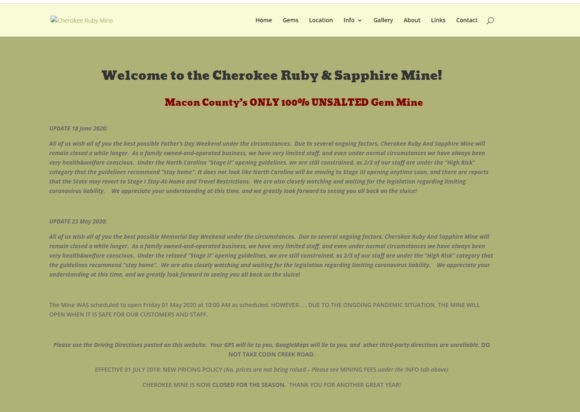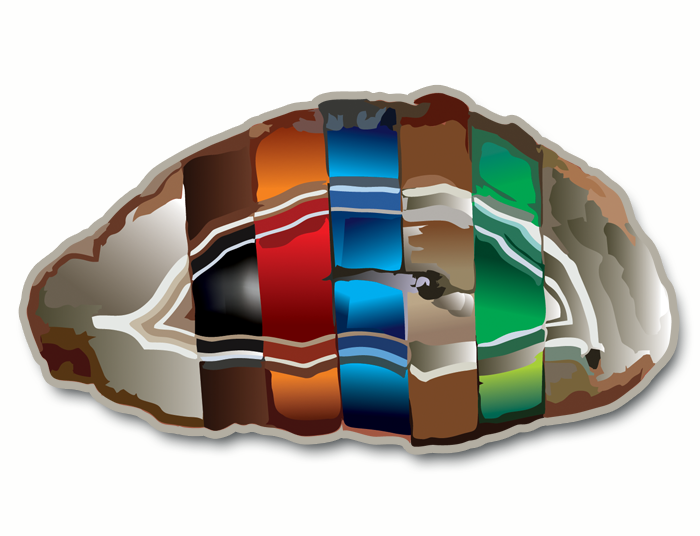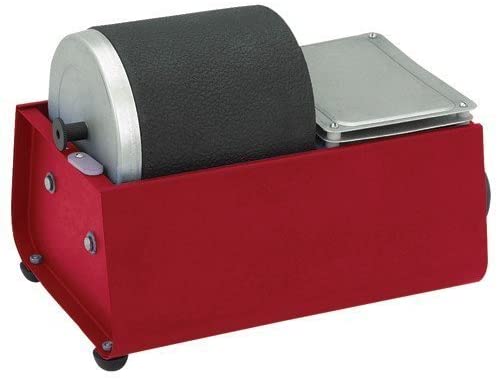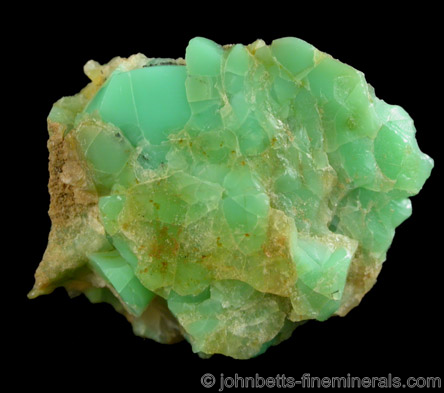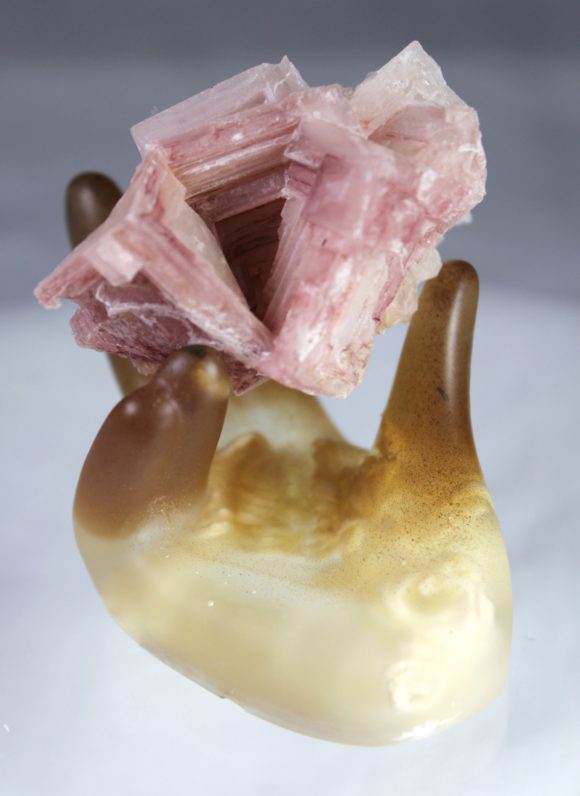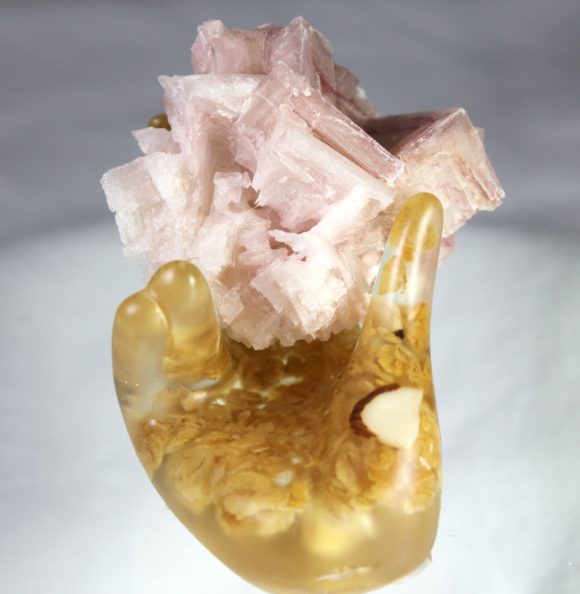The post Tea Time in the Mineral Industry appeared first on Where to Find Rocks.
]]>Hot Juicy Gossip!
One of my favorite quotes has always been “Hell is Other People”. You could find it inscribed on buttons, bumper stickers, t-shirts, of course, now it has gone the way of the “Kilroy was here”. For the younger audience, I’m just waxing nostalgic. Of course, after many years of being alive and consuming Sartre’s play NO EXIT, I understand the quote was much more than that basic quote. The story of four people locked in a room with no exit, which turns out to be hell (sorry for the spoiler), the quote is better extended. “Hell is Other People’s Opinion of You”. Much worse, much more self reflective. Possibly something that only comes with age and insight into one’s self. Are people allowed to change? Or must we always look at them with the view we once established?
During my 20+ years in this industry I got to meet a veritable “Who’s Who” in the club of mineral dealers. Mostly lovely people, enjoying this fine hobby. Some of them retired school teachers and professors, some ex-geologists, mixed in with some plain ol’ capitalist merchants. Indeed, there is always the train of gossip that swirls around, but you CERTAINLY, well, ok, RARELY, found anyone in the hallways of hotel shows, or in the middle of arena just shouting obscenities and showering the show with bad tidings. If there was, or when, those sellers would not find themselves in the graces of the general buying public. Then, the internet came along. The dark, evil internet. Nobody has really painted as beautifully dark a picture of the internet as Bo Burnam.
A certain protest group on the internet that was anonymous in nature liked to say “None of us are as awful as all of us”. Truly, the disconnection from the real world has fueled this mean nature that comes part and parcel with the internet and the dealings online. Name calling, rudeness, casting aspersions, airing private drama, not only in words, no no, full on LIVE videos filmed in the moment of heat!
There is a whole group of internet dealers who sell minerals via live video who literally create a Cult of Personality, where customers and fans follow them as pseudo celebrities. These parasocial relationships are fueled by the drama, the group hate and the nature of “who knows what they will say or do” that keeps them coming back for more. Boss bitch, mean girl crew. I understand it personally. I would much rather the mean nasty girls LIKE me, rather than use me as a target for their cruelty. In fact, having the mean girl umbrella over you gives you the chance to lash out, to abuse a target, all the while, the umbrella cheers and prods with you. Even better, they might console you if the target dares to strike back. Bullies come in all sizes and flavors. What flavor do you choose for your life? Are you full of spite and hatred, or do you find that off putting and flavorless?
In the past year I have taken part in many live sales, witnessed dozens of 3rd party sellers and worked for a couple that is so toxic, it is beyond words. In the end, it boils down to one simple fact. Be cruel, be wildly mean, cast aspersions, punch down. Share your ups and downs, your baby momma drama, your cruel intentions and you’ll have a HUGE following. Cast that off, be pleasant, be kind, be fun and informative, stay below 100 viewers. On the internet, being a bully is money. The algorithm loves and promotes it. The internet is an awful place now. Human nature is cruelty. Might is right, as long as you support it.
Many years ago, from 2008-2014 I made my living giving lectures and writing about minerals. I traveled around the Southern California area, flew away to the east coast to give lectures and so on. With over a dozen lectures on things like Palos Verdes Barite, Agates of the Western USA, Rockhounding 101 and such, the talk that put butts into seats was my talk on Fakes and Forgeries.
Here is that lecture, in fact, redone in 2023 for a new life on the internet. I had joined a group of sellers on a private facebook group and they were asking for lectures. I presented this lecture, on fakes and forgeries and the person running that group told me that it was the most watched and most rewatched videos of the lecture series.
Why? Why is it always that lecture that gets so many viewers? It is all about the DIRT! The Gossip! The juicy 2 minute hate that we get to throw at the scam rocks. We get to come together and let bully Justin cast aspersions and accusations at the rocks.
Yes, sadly it is 2023 and hate is paramount on the internet. The floodgates are open. We are, collectively, a rubbernecker’s delight.
The poet Jello Biafra once said something that rings true to this situation
We don’t destroy society in a day
Until we change ourselves first
From the inside out
We can start by not lying so much
And treating other people like dirt
It’s easy not to base our lives
On how much we can scam
And you know
It feels good to lift that monkey off our backs
There is so much going on behind the scenes with the people who enwrap you into this chaotic world of hate sales. If they can devote a half hour feed talking absolute horror about someone else, or putting others down, either other sellers or their own suppliers, what do you think they say about you behind the scenes? Do you really think they think of their customers as anything but suckers? Maybe stanning for trolls isn’t the hot thing. Or the right thing. Or the ethical thing. Maybe that support helps to spread more discontent and ill will into the world. Does this world need that?
Hell is other people’s opinions of you. Those who live a life of hate, greed and mistreatment of others, as a society, we should give them hell. Maybe they will change, let’s let people change. However, if you run into a live seller of minerals who is being cruel, promoting drama, exposing deeply personal and unfavorable public life, maybe you might want to hold your support for that seller. There are dozens upon dozens of pleasant, happy, joyful, educational sellers out there who need your support. Your money speaks. Make your voice strong and positive. Be a part of the solution.
Of course, these are just my personal thoughts on the issue. I’ve seen too much of this behavior being rewarded. I understand the desire. I simply hope that one or two people read this and become aware of these issues. We all want to be good people, I imagine, at least most of us do. Let’s support good people, if we can.
Related posts:
The post Tea Time in the Mineral Industry appeared first on Where to Find Rocks.
]]>The post Collecting Ribbon Barite around Quartzsite Arizona appeared first on Where to Find Rocks.
]]>This network of shafts and inclines can be 100% avoided, but the colorful chunks of Barite, Quartz, Hematite and Fluorite sure can hop into your bag!
We will show you a map to a great big deposit of ribbon barite you can collect, if you are in the Quartzsite, Parker, Bouse or Wickenburg Arizona area, but first, lets learn a little bit about Barite.
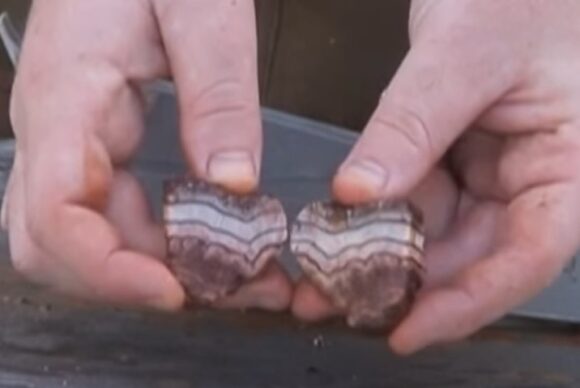
This is a sample of the typical barite found at the Plomosa Road Barite Ridge deposit.
Barite, also known as baryte (for those of the English persuasion), is a mineral composed of barium sulfate (BaSO4). It is a dense, white or colorless mineral with a Mohs hardness of 3-3.5, which means it is relatively soft. Barite occurs in a variety of forms, including tabular, prismatic, and fibrous, and it may have a wide range of colors depending on impurities present in the mineral, such as blue, brown, gray, or red.
Barite is found in a variety of geological environments, including sedimentary rocks, hydrothermal veins, and as gangue mineral in metallic ores. The largest deposits of barite are found in China, India, and the United States. Other significant deposits can be found in countries such as Morocco, Turkey, Canada, and Mexico.
Barite has many uses, primarily in the oil and gas industry as a weighting agent in drilling muds. It is also used as a filler in the manufacture of paints, rubber, and plastics, as well as a component in the production of paper and ceramics. Barite is also used as a flux in glassmaking and as a radiation shielding material in medical and scientific applications.
Barite is generally considered to be non-toxic, but it can be harmful if ingested or inhaled in large quantities. Therefore, proper handling and disposal procedures should be followed when working with this mineral.
Barite is an interesting and versatile mineral that has many characteristics that make it a great addition to any mineral collection. Here are some reasons why barite is a good mineral to collect:
Firstly, barite crystals have a unique and striking appearance. They can come in a variety of colors, including clear, white, yellow, blue, and pink, and can have a variety of crystal habits, including tabular, prismatic, and fibrous. This means that barite crystals can be both beautiful and diverse in appearance, making them an excellent mineral to collect for aesthetic purposes.
Secondly, barite is a widespread mineral found in many geological environments, which means it can be relatively easy to acquire specimens for your collection. The largest deposits of barite are found in China, India, and the United States, and there are many other significant deposits around the world. This means that collectors have the opportunity to obtain specimens from a variety of locations, adding to the diversity of their collection.
Thirdly, barite has many uses in industry and science, which means it can be an interesting and informative mineral to collect. Barite is used in the oil and gas industry as a weighting agent in drilling muds, and as a flux in glassmaking. It is also used as a radiation shielding material in medical and scientific applications. Knowing about these applications and the properties of barite can add to the educational value of a mineral collection.
Overall, barite’s unique appearance, widespread distribution, and versatile uses make it a great mineral to collect.
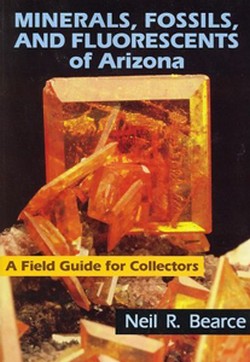 |
Minerals, Fossils, and Fluorescents of Arizona by Neil R. Bearce This book sets the standard for field guides everywhere. Amazing, full of great locations! A MUST own for Arizona field collectors, or those living in nearby states! |
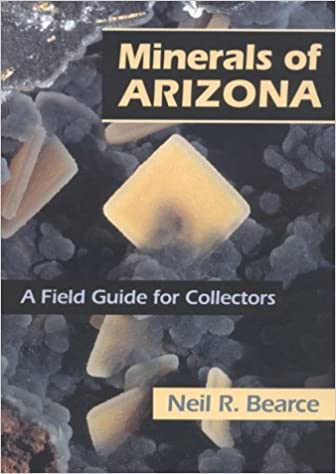 |
Minerals of Arizona: A Field Guide for Collectors by Neil R. Bearce This is the first guide, of the two shown here. good idea to grab both |
Now, you can find your very own Barite from lots of places in the world, but for this fun banded material, you’ll be going to hop onto Plomosa Road just north of Quartzsite and drive 12.2 miles to reach the gravel road to the northwest. Hop off the paved road and turn onto it, then turn left into the wash. You can explore all around that ridge that protrudes out of the wash. It runs for just about 2000 feet.
Years ago a video was made of this location, showing you the area. The audio was done by Rick Kennedy of Earth’s Treasures, in case you were wondering who’s sexy vocals those were.
Related posts:
The post Collecting Ribbon Barite around Quartzsite Arizona appeared first on Where to Find Rocks.
]]>The post Quartz Crystal Locality – Lehighton, PA appeared first on Where to Find Rocks.
]]>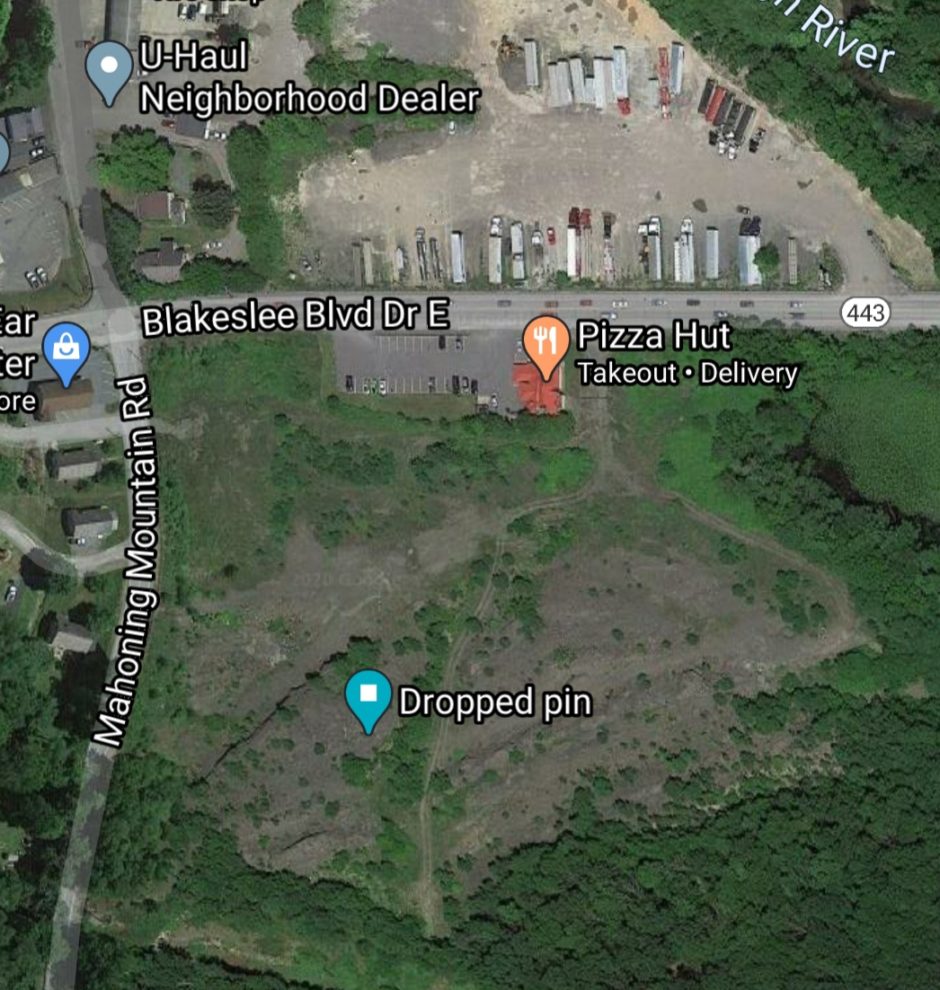
Dropped pin showing the area where quartz crystals can be found.
Getting There: This location is located behind the Pizza Hut on SR 443 in Lehighton. Access is uncertain but it is not posted and I was not bothered for the two hours I spent there. Park at the Pizza Hut and walk through the grass to the location. There is a lower level and a higher level, both with quartz. The lower level is better for working veins in the rock while the higher is where you can ground score small crystals and plates.
Supplies: Crack Hammer, Flat Chisel, Wedges, Prybar, Wrapping Material, Water.
Geology and Collecting: This locality is hosted in the Devonian age Marcellus formation, a black shale. Quartz formed in hydrothermal veins that shoot through the shale. Fossils are rare at this site, but they are common nearby. This shale has good cleavage and breaks nicely with a chisel.
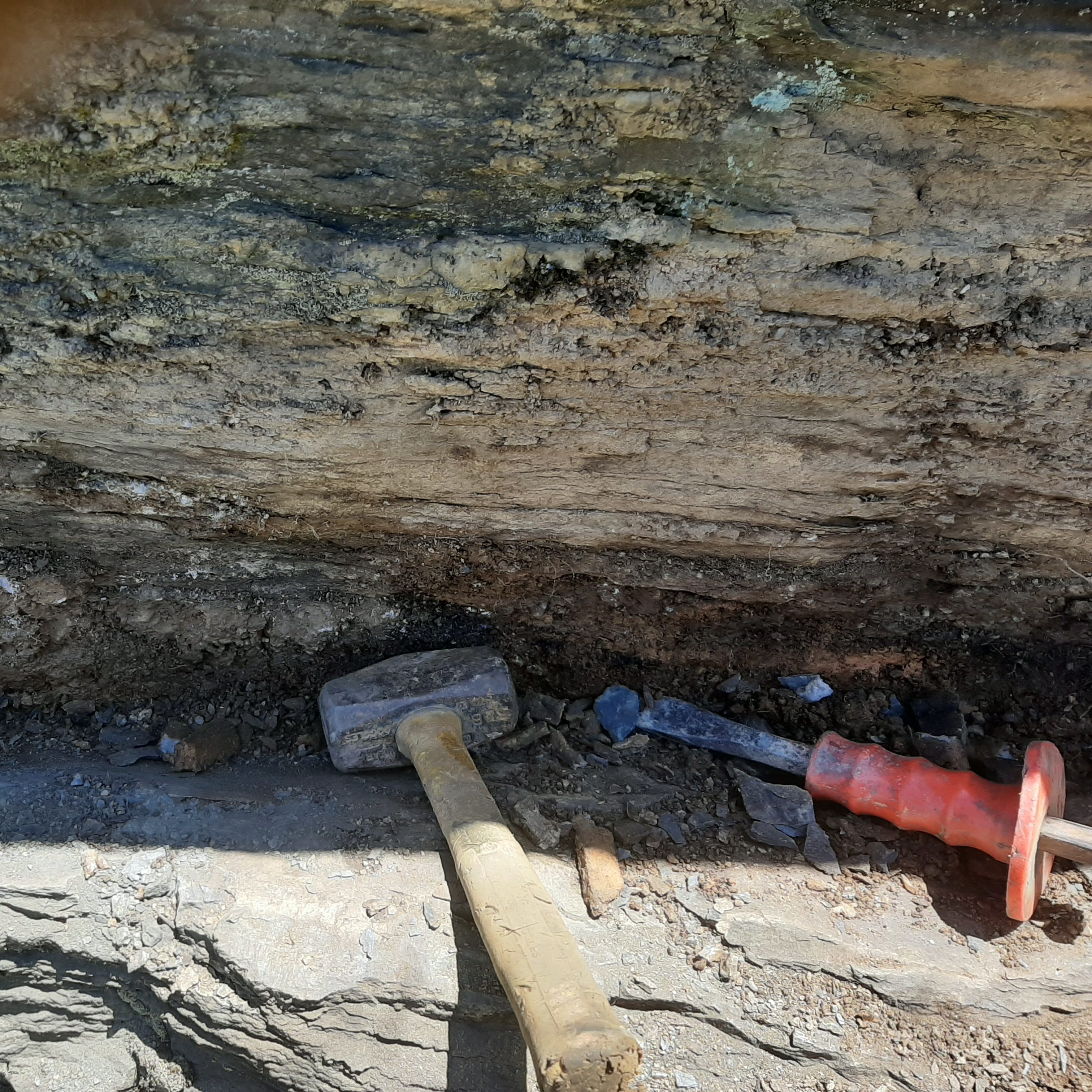
Chasing a quartz crystal vein into the rock.
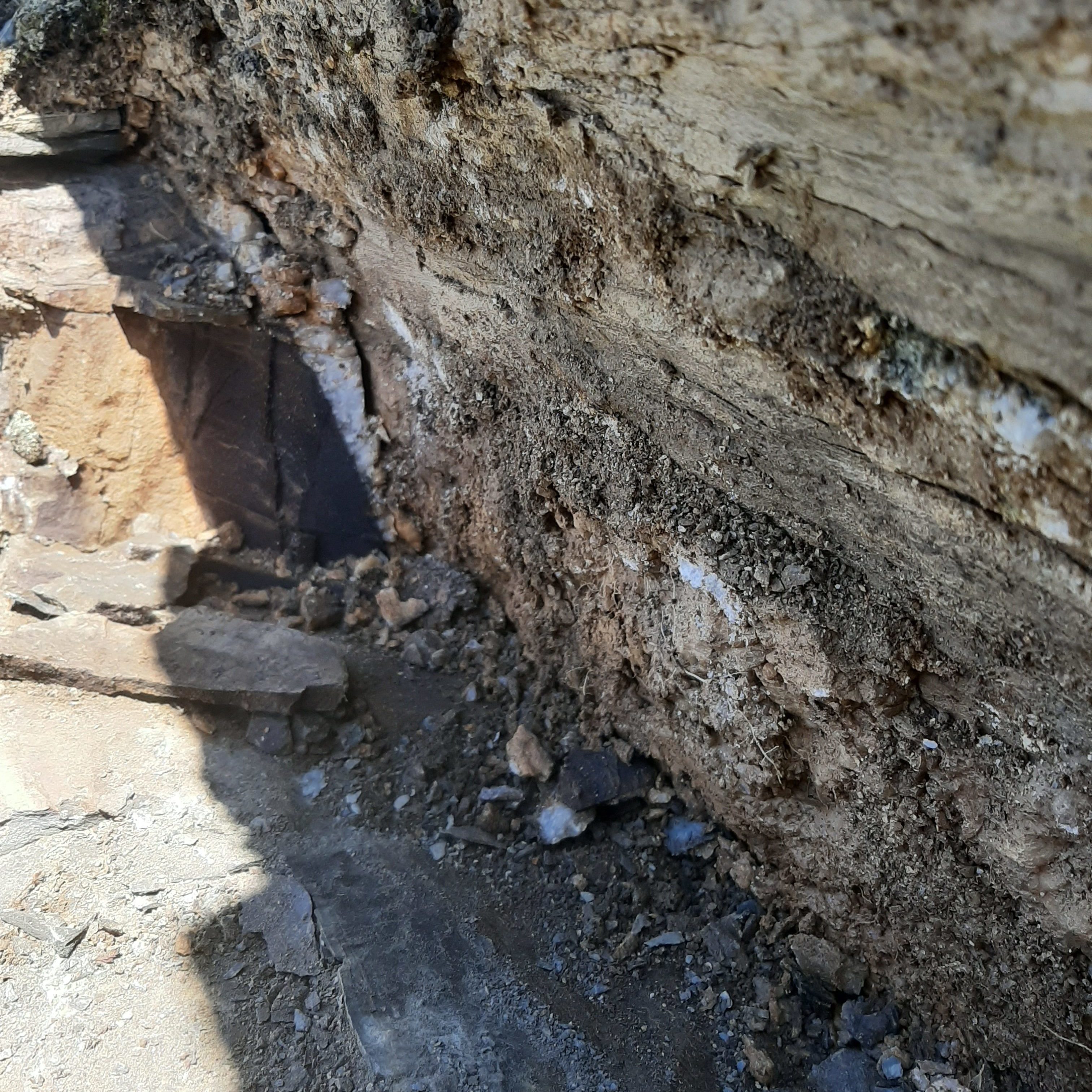
Notice the white bits of quartz stuck in brown mud.
I managed to locate a quartz vein on the cliff face in the lower level of the quarry. These veins won’t look bright white, but are often filled with a little brown sticky pocket mud which covers the crystals making them hard to see. Follow the scraps of quartz stuck to the wall down to where it leads into the rock. Use a flat chisel and prybar to remove the shale surrounding the vein. The quartz crystals won’t look all bright and sparkly until you wash them off later.
Crystals at this locality are typically not large, but they are abundant. I did find one crystal slightly over an inch, but 95% of them are under one half inch long. They are colorless, often quite clear and have a very typical quartz form. I have not seen any inclusions or found any quartz with color at this location.
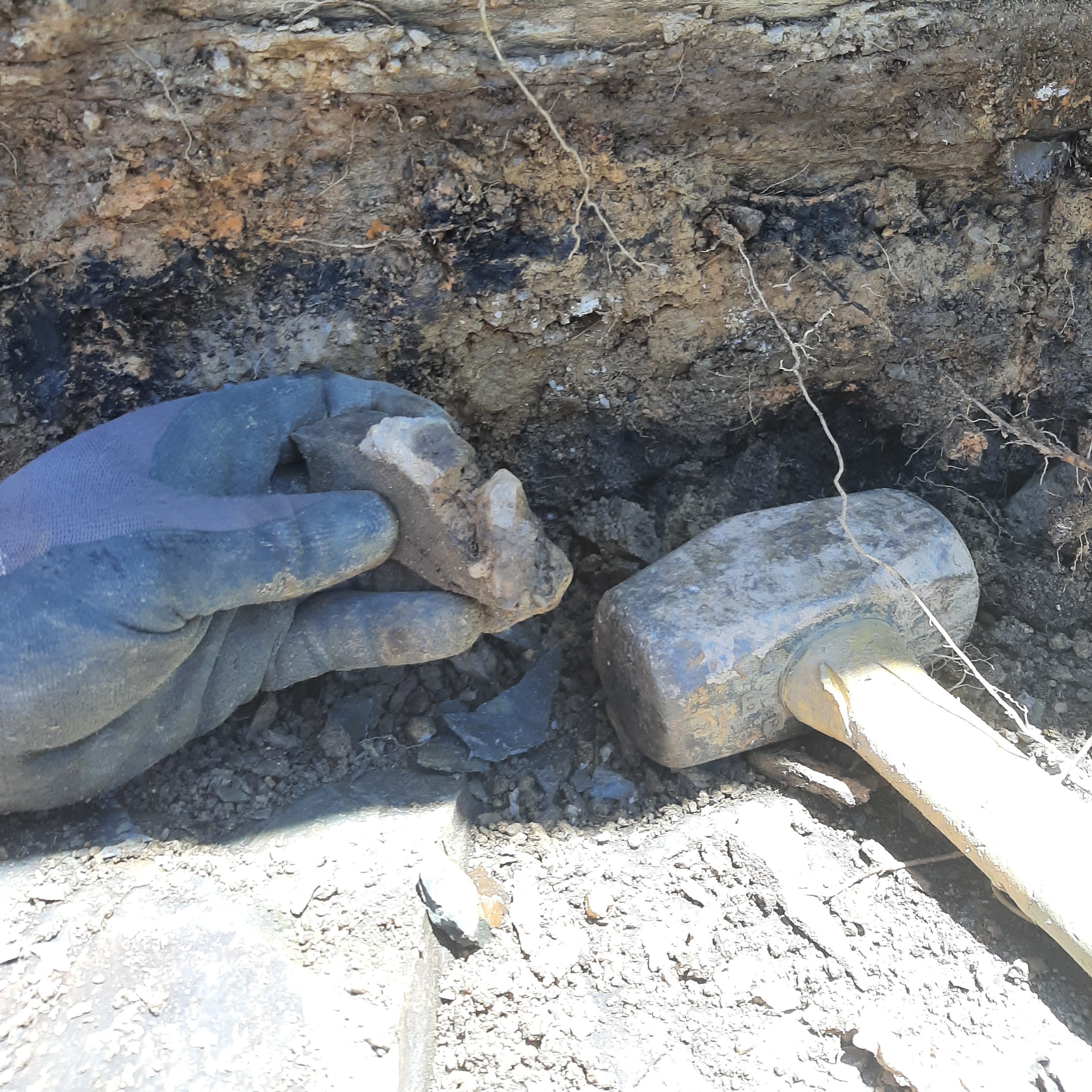
A large crystal from a vein in the front, lower portion of the locality right after extraction.
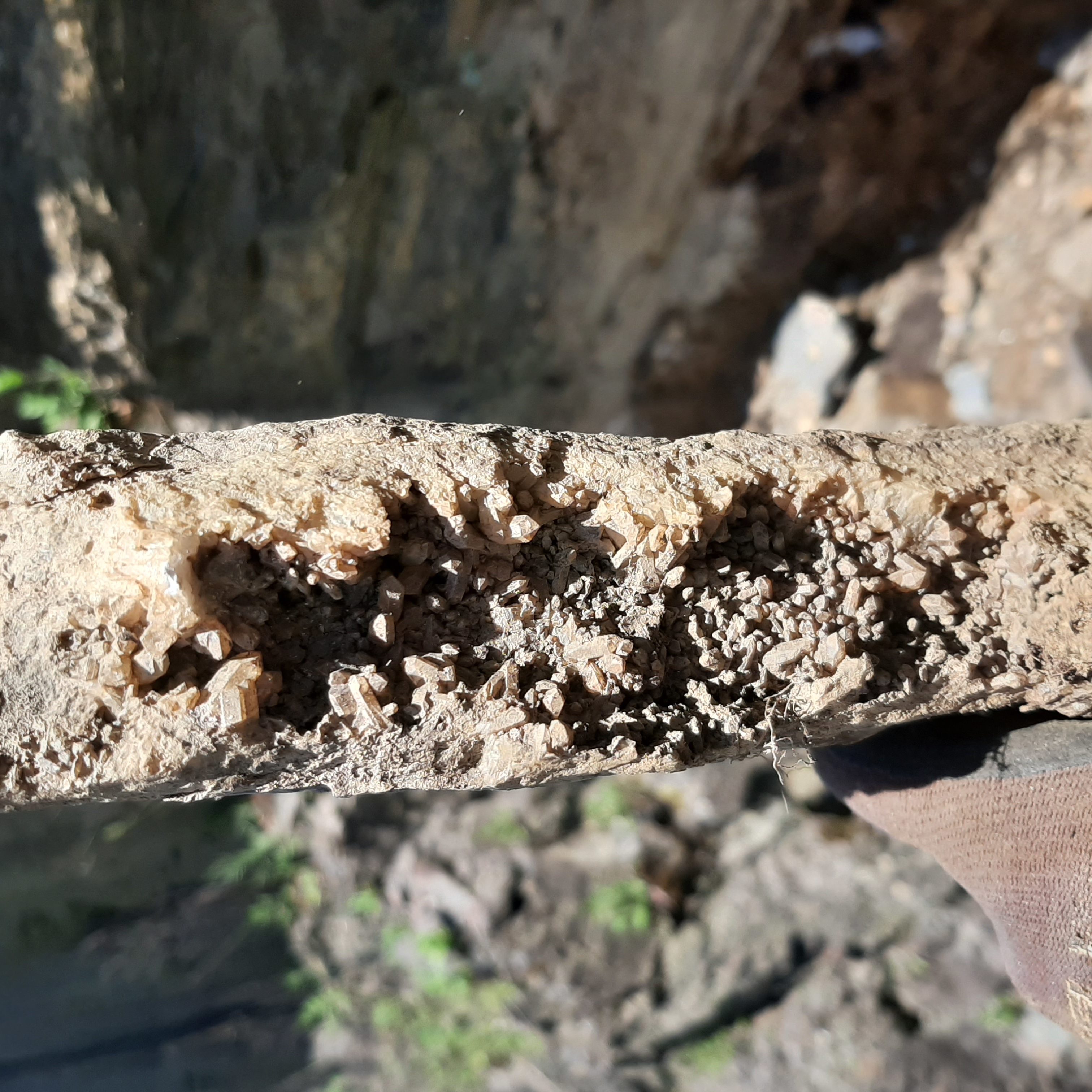
A quartz cluster after extraction.
Conclusion: This is a great, low key spot for beginners looking to find their own quartz crystals. Not only is it close to the car and very easy to get to, it provides an opportunity to either work the hard rock or chill out and groundscore. For the more advanced collector, there is definitely potential for some larger, higher quality quartz in the area. Perhaps if a lot of effort was put into this site, something could open up. I have also found other quartz veins nearby. Who knows what’s really out there. Maybe something fantastic!
Article By: Jeremy Zolan – Instagram @Leaverite_Tycoon
Related posts:
The post Quartz Crystal Locality – Lehighton, PA appeared first on Where to Find Rocks.
]]>The post Ebooks for Rockhounds – Information at Your Fingertips appeared first on Where to Find Rocks.
]]>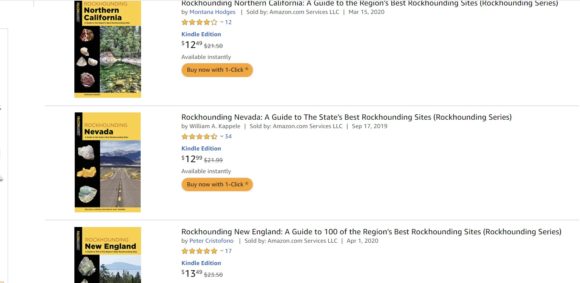
Check out all the ebook field guides listed for sale on Amazon!
As you can see, there are some great choices for guides on Amazon. Just by searching “rockhounding” in the Kindle ebooks section of Amazon, I got 55 results, most of them being informative guides to collecting sites and prospecting methods. Imagine how much information you can have at your fingertips! Mineral collecting books tend to be really affordable, I had a hard time finding one that cost $20 or more. Although the feel of a paper text is nice, you can’t beat the price and field-usefulness of these ebooks.
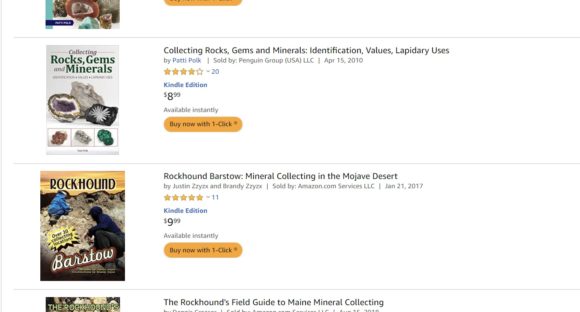
Searching “mineral collecting” brings up less field guides, but still a lot of them. Notice a trend? Seems like digital versions of field guides are getting popular! Take advantage of this.
Searching “mineral collecting” brings up one of the best recent field guide for collecting minerals in Southern California — Rockhound Barstow: Mineral Collecting in the Mojave Desert by Justin and Brandy Zzyzx. This great guide to collecting a wide variety of material gives you tons of sites that are currently open to the general public where you can find mineral specimens and lapidary material! If you had read some field guides, they will provide directions and info on sites, but note that they are closed to collecting. This great guide gives you places in SoCal you can actually visit and dig.
Another thing to mention, are PDF files of old texts and surveys available for free online. Museums, universities, personal websites of collectors, and state and national government geological surveys are some places where you may find many old texts that have been digitized for your convenience. Looking at these types of resources is a good way to find old localities. These types of texts often include sites that the newer guides do not, and while they require a bit more fishing around in terms of actually finding them and acquiring permission, the rediscovery of an old site might produce some amazing results.
Here is an example: https://www.des.nh.gov/organization/commissioner/gsu/documents/nh-mines1960.pdf
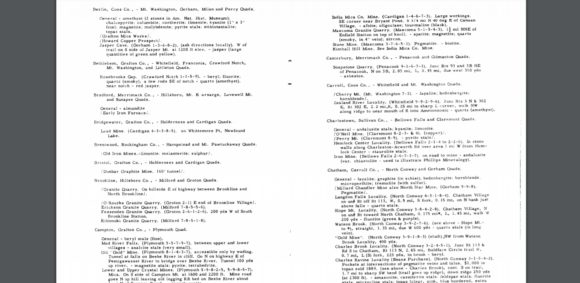
Screenshot of the PDF of this classic guide.
This classic guide by Philip Morrill, published in 1960 is notoriously difficult to find in print but known among NH collectors for the unique, often forgotten localities described within it. This book is something you probably wouldn’t want to bring into the field with you because it would be hard to get another copy. Now you can have the info in your digital library and bring it with you without trashing your copy
Ebooks and PDFs are a powerful tool for the collector looking to get themselves into new areas or sites. The advantages modern collectors have over previous generations due to the amount of technology and convenience available have allowed for a lot of new discoveries and rediscoveries of old localities. If you haven’t been using these resources and are itching to find a new place to hunt, then it’s time to step on board the digital library revolution!
Related posts:
The post Ebooks for Rockhounds – Information at Your Fingertips appeared first on Where to Find Rocks.
]]>The post Collect World Class Fluorite at the Walworth Quarry Open House in New York appeared first on Where to Find Rocks.
]]>This quarry dig is my personal favorite out of the two offered. Although the dolostone rock is extremely hard to break, fluorite and other highly collectable minerals are very abundant in this quarry. I would say it would be difficult to not find any fluorite. Sometimes it is so incredibly clear, that it can be hard to spot. Your eyes have to get used to searching for it, but once they do you will spot them all over the place.There are definitely enough to go around. This is an amazing trip I highly recommend to anyone in the Northeast who wants to find crystals.
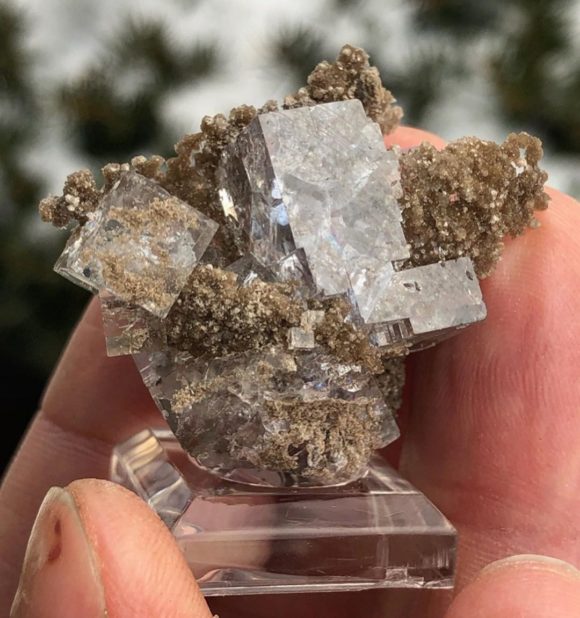
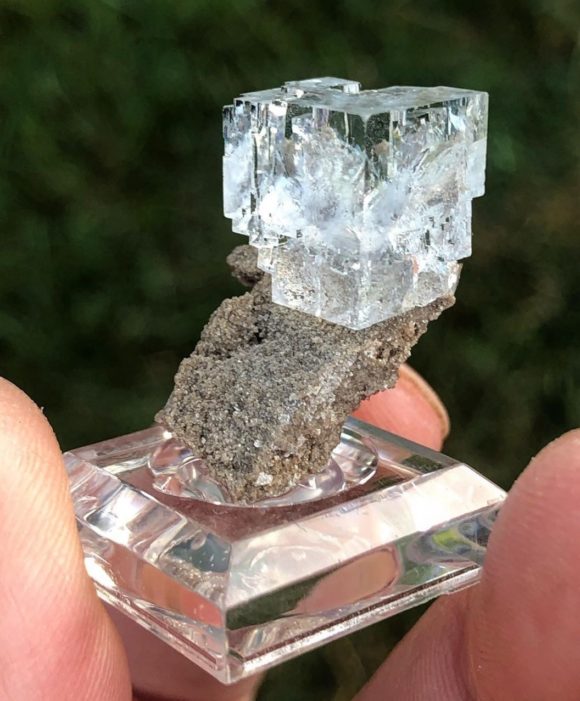
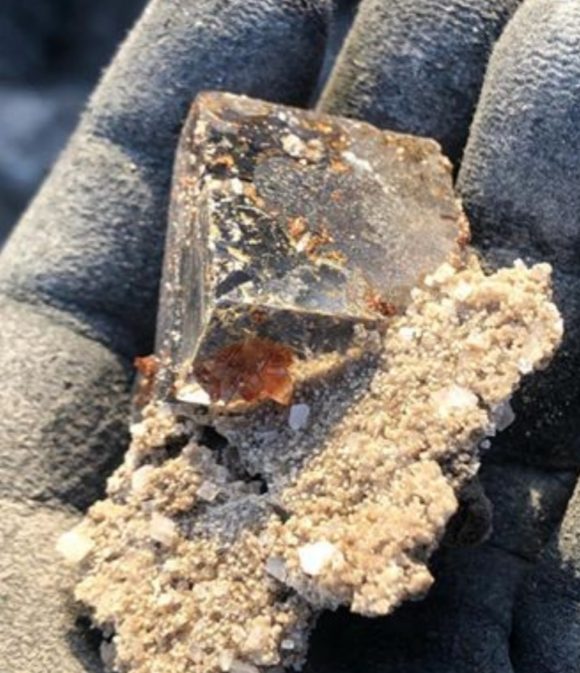
Amazing fluorites found by the writer’s collecting partner Alexander Kim at previous Walworth open houses (Check him out on Instagram: @dirty_minerals).
Many other beautiful minerals are found at this quarry, the most notable being gorgeous golden sphalerites. Sometimes there will be droplets of tar like petroleum coating specimens. The petroleum can be removed with a organic solvent, but I think sometimes it really is aesthetically complimentary.
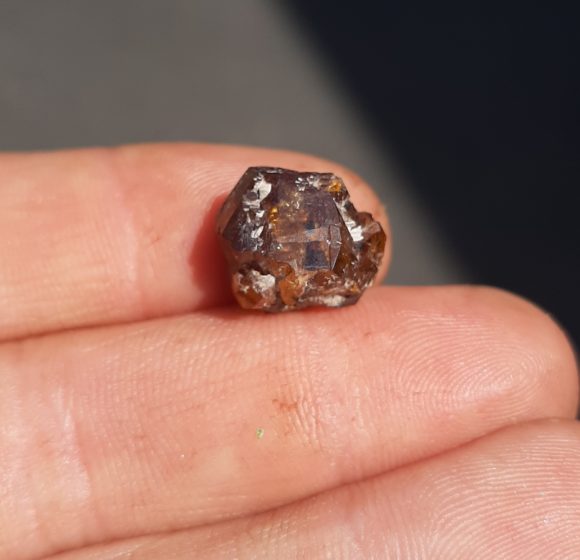
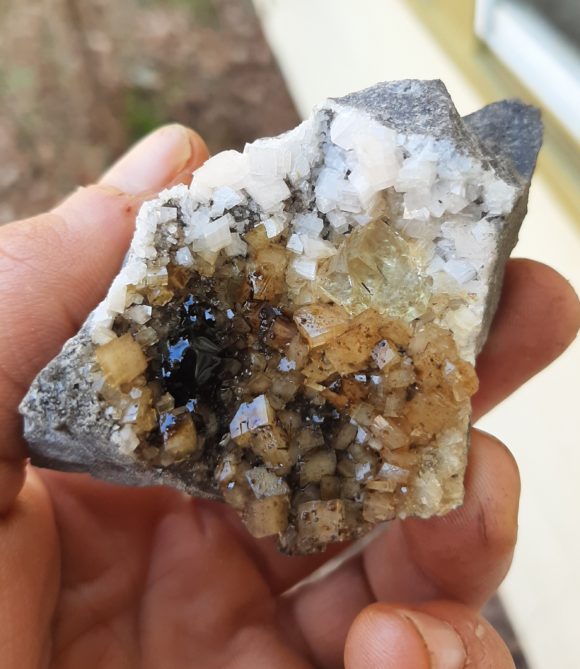
Two specimens found by the author: 1) A floater golden sphalerite crystal that was rolling around freely in a pocket with a few others that were attached to the walls. 2) A peculiar fluorite with an elongated hair like pyrite inclusion, complimented by a big shiny droplet of petroleum coating the dolostone.
Geology and Collecting: The Walworth Quarry works a stromatolite bearing Silurian dolostone. The mineralization occurs in a layer close to the surface of the bedrock in the high bench of the quarry. Like with the formation of Herkimer diamonds, the stromatolites provided space and protection for crystals to form in vugs.
The mineralogy of the locality is fairly simple with the only collectible minerals present in abundance being fluorite, dolomite, calcite, sphalerite, celestine, and gypsum var. selenite.
Before you Visit: The quarry does not have an official page for the open house, but usually it takes place on the second weekend of October. Arrive at the quarry early- 6:45 AM to register for the dig. Hard Hat and protective gear required for this location. Check local Northeast mineral club pages for more info.
Show up to the quarry to register for the dig at 6:45AM. Once registered, the rules will be explained and you will be lead to the site. The dig ends at noon. This rock works similarly to the dolostone to the east in which Herkimer diamonds are mined, meaning it is extremely hard. Bring a crack hammer, chisels, wedges, and a sledgehammer. Use flat chisels or wedges to work the cracks in rocks. Power tools are welcome at this quarry.
The best technique for splitting large boulders is feathering and wedging using a hammer drill to drill holes for wedges. A gas rock saw is also an extremely useful tool for extracting difficult specimens by slicing them out of the rock.
PPE is required on this dig. Bring a hard hat, steel toed boots, safety goggles, and gloves. The former three are a requirement. Remember also to bring plenty of water as well as snacks. There are restrooms on site but it is far away, near the entrance.
Special Thanks to The Dolomite Group for allowing the special privilege of mineral collecting in their quarries.
Sources:
https://www.mindat.org/loc-18146.html
http://fredmhaynes.com/2016/10/14/walworth-quarry-open-house/
Related posts:
The post Collect World Class Fluorite at the Walworth Quarry Open House in New York appeared first on Where to Find Rocks.
]]>The post Beryl and Pegmatite Minerals at the Simpson Quarry, South Glastonbury, CT appeared first on Where to Find Rocks.
]]>Large, sharp blue aquamarine beryls have been found both in the dumps and in solid pegmatite at this location. A variety of other minerals can be found at this site as well, including some rare species.
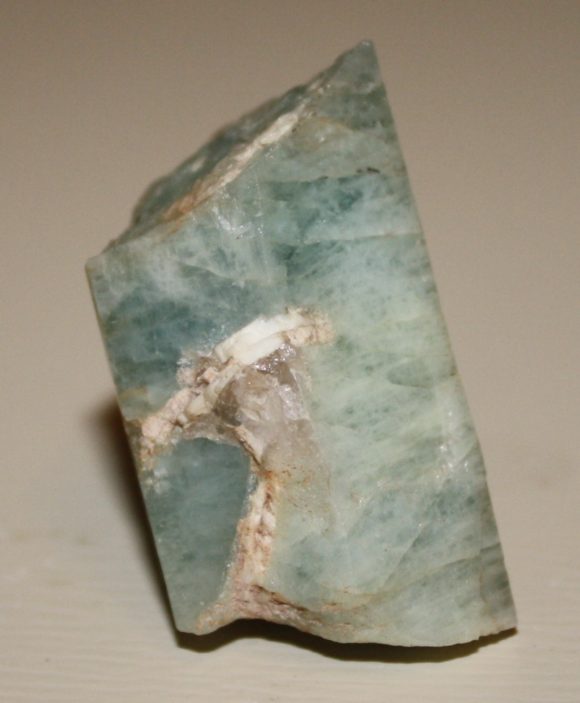
37mm tall beryl dug in 2009 by CT field collector Adam Berluti
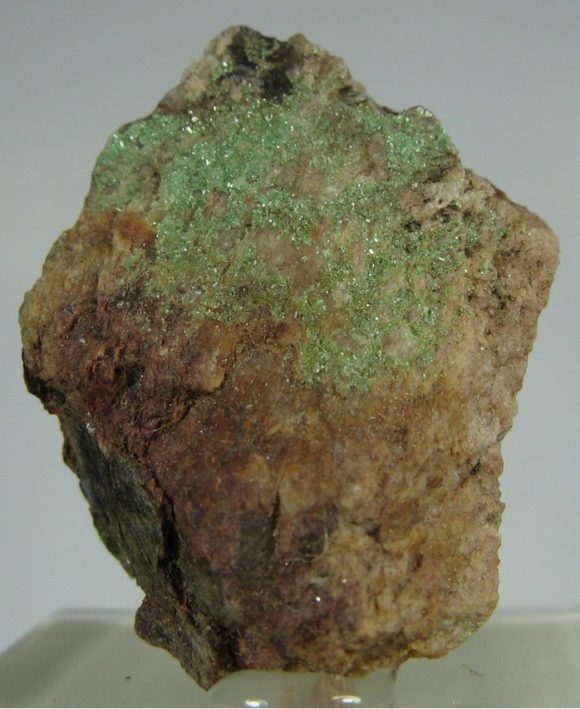
2cm tall specimen covered with minute green Torbernite crystals. Roger Sedgwick collection. (Source: https://www.mindat.org/photo-494986.html)
This is one of the first sites many collectors in CT visit, and it is not hard to find something worth bringing home. The collecting status of this location is unclear (and with all sites featured on this website, you are responsible for obtaining permission and checking current property ownership), and as of early 2021 it remains unposted and is still frequented by diggers in the area.
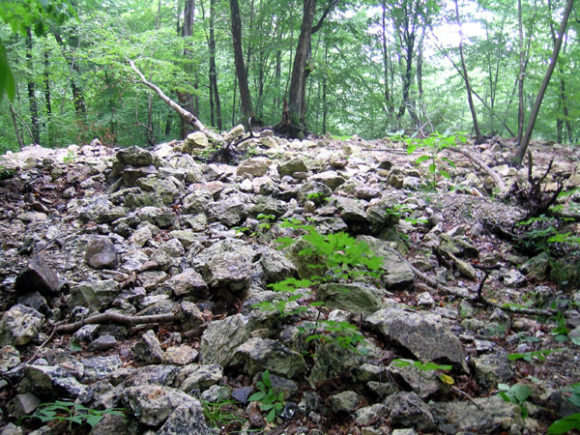
Quarry dumps at the Simpson. Dig through these dumps to find nice aquamarine beryl crystals as well as many other pegmatite minerals like almandine garnet, schorl, torbernite, and columbite. (Source: https://www.mindat.org/photo-123808.html. Image copyright 2004 Peter Cristofono)
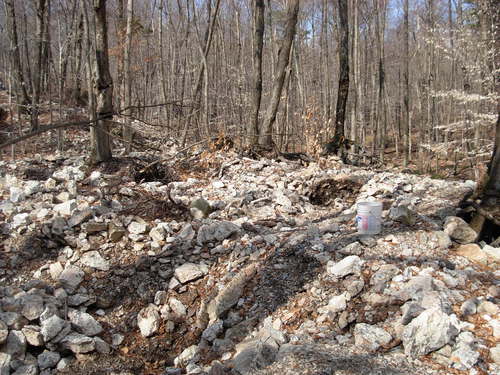
Quarry dumps with foliage down. Taken April 2nd 2011 by Matthew Kimball. (Source: https://www.mindat.org/photo-390478.html)
Getting there: This mine is easy to get to. Park at the end of Michele Drive in Portland, CT. You will see a small path through the woods to your left. Follow the path until you see the very obvious big quarry dumps approximately where the pin in the photo is. You will have to cross some swampy areas. The location is approximately a quarter of a mile northeast from where you park. A word of caution, the collecting status of the location is not officially known. Many people dig here though it may be private property. The locality has been frequented by collectors on a near daily basis for decades.
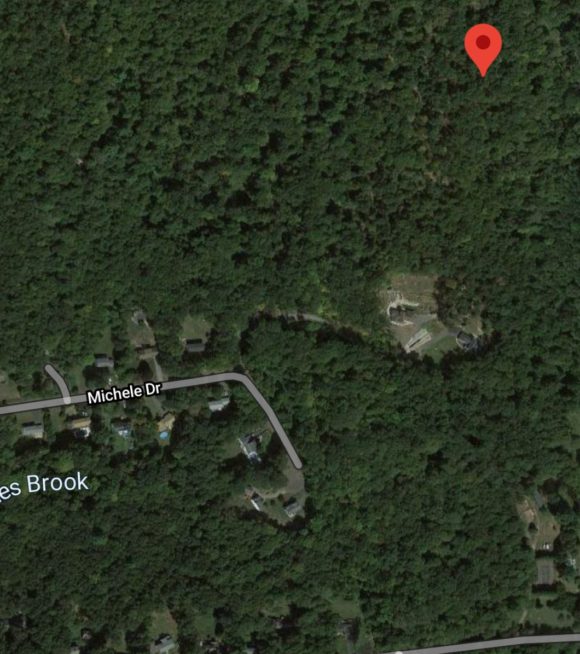
Location of the Simpson Quarry, and location of beryl crystals.
Collecting: There are two main approaches to digging this spot- dump digging and hard rock mining. At minimum you will want to bring a shovel, crack hammer and chisels to the location but other tools that may be useful are hand rakes, a sledgehammer, sifters, small bags, and a UV light. Many rare minerals are found at this site, some of which, autunite and hyalite, are highly fluorescent. The mosquitoes get terrible at this spot in the summer, be prepared with lots of bug spray. Pegmatite is an extremely hard rock and will take persistence to break. The mica and quartz can be extremely sharp so wearing gloves is a good idea. Do not get discouraged if you have a difficult time working the hard rock. Digging pegmatite takes immense skill and practice. It is something that experienced New England diggers take years to hone.
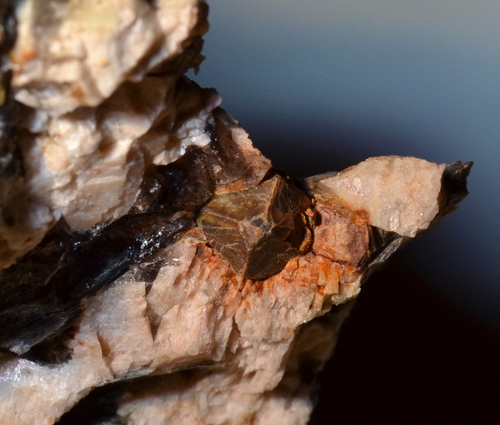
A large 6mm microlite dug at Simpson by Andrew Kruegel. A unique feature about this pegmatite is the abundance of this rare tantalum mineral. This example shows the typical form and color. A loupe can help you spot these more easily. (Source: https://www.mindat.org/photo-525514.html)
Geology and Mineralogy: This locality is very similar to the other Paleozoic pegmatite in CT. It is linear in shape and not very pocket rich. This pegmatite also contains a great deal of heavier rare elements. Collectors often visit this site only interested in beryl, but perhaps more notable to the mineralogist is the abundant microlite found in sugary albite. Microlite contains the rare element Tantalum. These microlite occur in brown modified octahedral crystals. If you are interested in them, familiarize yourself with them on mindat.org. Microlite is often somewhat radioactive and will produce a radiation halo, which is a good way to spot them.
Sources:
https://www.mindat.org/loc-29587.html
Related posts:
The post Beryl and Pegmatite Minerals at the Simpson Quarry, South Glastonbury, CT appeared first on Where to Find Rocks.
]]>The post Sea Cliff Zeolites at Oceanside, Tillamook County, Oregon – A Zeolite Tutorial appeared first on Where to Find Rocks.
]]>It just goes to show, deposits of minerals in basalt rock deposits are well worth searching out in your local area. Consider the volcanic basalts of Oregon/Washington. Beautiful examples of rare and exotic minerals were once only known from these basalts, including, shockingly to some collectors, Cavansite!
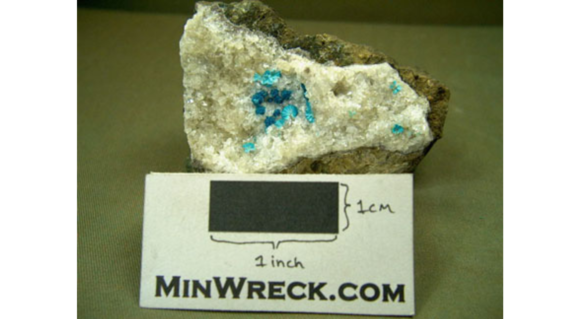
Specimen of Cavansite from the first place it was found, in Oregon. Zeolite deposits found in volcanic deposits are well worth inspecting for rockhounding possibilities!
Found in volcanic lava that has interacted with water, zeolites are beautiful minerals which are found in a huge diversity of different appearances. They are known to form where enormous volcanic events have occurred in the ancient past when lava flows into a body of water.
The lava instantly chills, creating a unique bubbly, rounded texture called pillow basalt where within spaces between the rounded “pillows” grow delicate crystals of zeolites as steam chemically leaches the basalts and forms new minerals.
Steam may rise through the molten lava as well, where the rock may solidify before it escapes. This type of rock is called a vesicular basalt. Many minerals tend to form in the “bubbles” or vesicles in this type of rock.
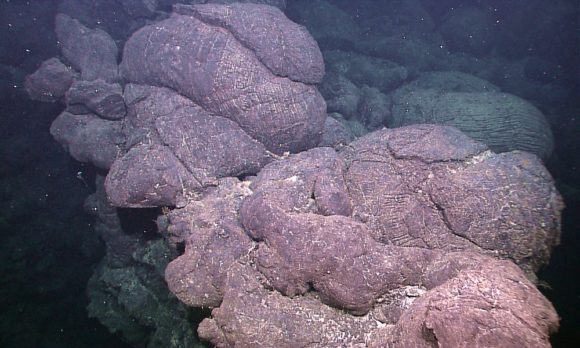
A recently formed pillow basalt at the Galapagos Rift versus an ancient pillow basalt in the Bonin Islands, Japan. Zeolite minerals are found between the “lobes” of the lava.
A vesicular basalt boulder. The holes are known as vesicles and represent where rising gasses got trapped in the rock. Minerals often form in these vesicles.)
The Cape Lookout area is the remains of a volcanic island that emerged in the Miocene period, about 16 million years ago. Cracks in the earth formed, releasing lava into the sea which cooled on contact with the water, forming pillow basalts and bubbly vesicular basalts which further altered to form zeolite minerals in the pores.
Many rare zeolites are found here, not the ones you would typically see in the large, flashy specimens from India many collectors love, but equally as beautiful if you can appreciate tiny things. Minerals you may encounter are erionite, mordenite, clinoptilolite, and dachiardite. Often these are found with calcite and clay minerals, the latter can give specimens some nice color and visual depth.
Specimens from this area are typically small, but absolutely stunning especially under magnification. A good, readily available microscope to view your microminerals with is the Dino-Lite, which you can attach to your computer via USB.
On this page, our focus is on two collecting sites you can visit, though exploring the beach may yield many more discoveries. Keep an eye out for sprays and nodules of zeolite minerals in the rock, much of which occurs in vesicular basalt, which looks like Swiss cheese.
The first area is Short Beach. There should be a stairway near a creek where you can access the rocky beach below. Here you will find boulders of vesicular basalt that you can break up to yield minerals in the vesicles.
Bring a pocket lens or loupe with you so you can more easily see minerals in the vesicles. They will be somewhat obvious, appearing as white puffballs and sprays, but some may be more hidden.
There is said to be better collecting even still at Tunnel Beach, down the road to the south.
North of the tunnel, you will see pillow basalt cliffs. Formed as lava was ejected into the sea, these cliffs and the surrounding boulders are rich in zeolites and offer some of the best collecting in the area. Use the tunnel to access the beach.
Minerals: These localities are heaven especially to the micro-mount collector. Some beautiful photos of material from the surrounding area are on Mindat (these are copyrighted and we don’t care to hotlink, just click the links for some great photos).
Embed:
https://www.mindat.org/photo-750805.html
Caption: Found by Rudy Tschernich, famous PNW zeolite collector. 14 mm FOV Golden erionite hemispheres on a white backdrop, looking like a fried egg with a broken yolk
https://www.mindat.org/photo-750632.html
Tiny, bushlike mordenite in a tiny vesicle from Tunnel Beach. Found by Rudy Tschernich
https://www.mindat.org/photo-257230.html
About a 1 inch wide plate of green gray clinoptilolite on mordenite from Short Beach, collected by Bill Tompkins
https://www.mindat.org/photo-751603.html
Tiny, about 2.5mm vesicle of delicate golden erionite sprays. Found by Rudy Tschernich
Collecting Zeolites: To do the best job you can collecting these delicate specimens, you will need to be prepared to break the hard basalt rock. Use a heavy crack hammer and a chisel to smash the boulders open, revealing fresh material. Zeolites are extremely delicate and the freshest, nicest ones will be found unexposed inside the rocks.
As said above, loupe or hand lens will help you see what’s going on inside the tiny vesicles a lot better. Some of the most beautiful specimens from this location are extremely tiny so you may miss them without a lens.
Remember to wrap your specimens very carefully. Many of these specimens are extremely delicate to the point that even blowing on them may damage them. Do not wash anything very velvety, hairy, or puffy or even moisture can mat and destroy the crystals.
You will have to time your collecting with the tides at these locations. Be aware of the tides and weather conditions before you go to the beach and collect.
More Info:
https://www.mindat.org/loc-210854.html
https://www.mindat.org/loc-205422.html
https://www.netartsbaytoday.org/html/zeolites_of_oceanside.html
And, if the Cavansite deposit sends your imagination wild, check out this article:
https://www.mindat.org/article.php/964/Field+Trip+to+Cavansite+Type+Locaility
Related posts:
The post Sea Cliff Zeolites at Oceanside, Tillamook County, Oregon – A Zeolite Tutorial appeared first on Where to Find Rocks.
]]>The post Digging Native Ruby and Sapphire at the Cherokee Mine in North Carolina – Pay to Dig appeared first on Where to Find Rocks.
]]>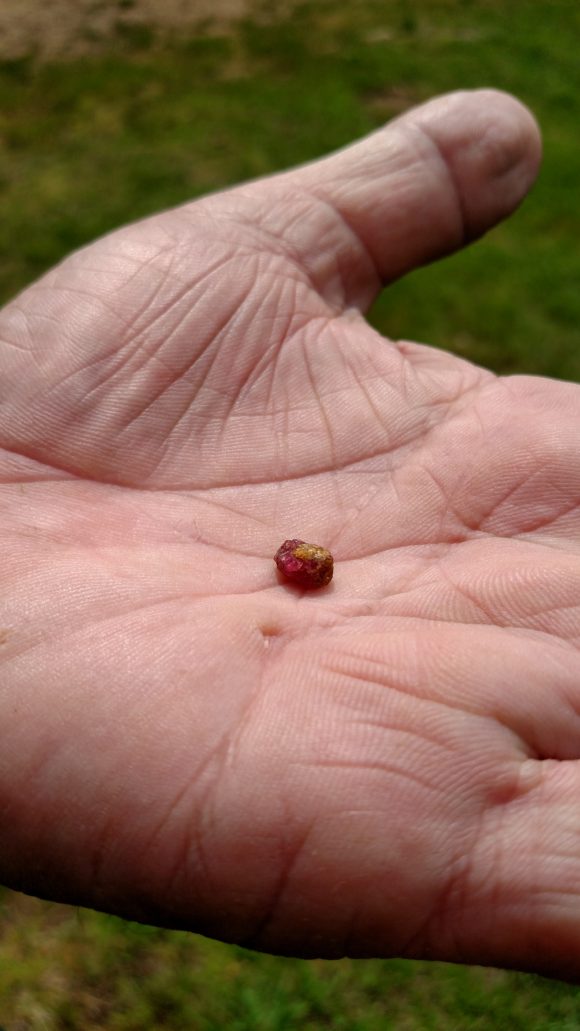
A beautiful red ruby straight from the Cherokee Mine.
Digging your own precious native gemstone may sound too good to be true to a lot of folks. Many of the sluice mines in the Southeast “salt” their material, meaning they enrich it with stones from all over the world and this can be disappointing when you expected to find something right from the ground beneath your feet. The Cherokee Mine in Macon County, North Carolina offers awesome ruby and sapphire sluicing from 100% local, unsalted material right from their mine!
Though ruby, sapphire, and corundum in general are the focus, other minerals namely red rhodolite garnet, blue-white kyanite, and metallic red brown rutile can be found with them too. This material is alluvial, meaning these crystals weathered out of metamorphic rock and tumbled around for thousands of years until they arrived at the mine, so given this, the ore is in the form of soil that contains the weathered-out gemstones. It is up to you to screen through the material and identify what is a gem, and what isn’t… but the kind staff is more than willing to help you!
While at the time this is published, Feburary 2021, the mine is closed for winter and the Covid Pandemic, however, we are all looking forward to a re-opening of this location, hopefully, in summer 2021, if life works out well.
Check out Bryan Major digging at the Cherokee Mine video below to get an idea of what the experience there is like!
The Cherokee Mine is a fee dig site, meaning you pay to dig their material, but they supply a lot of the equipment you need to go through the gravel!
From their website:
$20.00/Per Person – Includes One (1) Pre-Filled Bucket of our 100% Unsalted Gem Ore. ( * See below for explanation of this change)
Age 5 and under: Free Admission with an accompanying paid miner (no mining screen or bucket of gem ore provided – Li’l Miners get to “assist” an older accompanying miner).
Only paid miners are permitted to sit on the flume line, other than Li’l Miners as noted above. Other non-mining members of a group are welcome to enjoy our picnic area and lawnchairs.
Do not take Coon Creek Road.Group Rate (20 people or more): $5.00 discount Per Person
Includes One (1) Pre-Filled Buckets of our 100% Unsalted Gem Ore.
Active U.S. Military and U.S. Military Veterans: $5.00 Admission Discount
(Military ID Card is Required Upon Admission)
One discount per customer. Discounts cannot be combined, conjoined, transferred, conferred, or multiplied.
$5.00 per additional bucket of our 100% Unsalted Gem Ore.
CASH ONLY.Open May through October
Monday-Saturday: 9am to 4pm*
Sunday: Noon to 5pm*
*Weather Permitting
At the mine, you will be shown specimens of the gemstones so you know what to look for before they let you loose. Then they will provide you with a bucket of material to bring to the flume. The flume is a channel of running water used to clean the dirt off your gemstones, which you screen in it and carefully examine to sort the gems from the leaverites. They provide the screen.
Keep in mind that some of the gemstones might be extremely tiny or obscured by surface coatings. You might want to bring a magnifying device, tweezers, and plastic bags so you can extract tiny finds and save them in a place you won’t lose them. Mining can be tough on the hands so you might want gloves too. Bring sunscreen, water, bug spray, and food. Be prepared!
Directions:
For BEST results, FIRST please enter address of “4433 Bryson City Road” THEN enter address of “2586 Ruby Mine Road, Franklin NC 28734”. Any directions which state “Take Coon Creek Road” or “Flowers Gap Road” are INCORRECT! That will force you to turn back and start over.
4433 Bryson City Road is the intersection of Sanderstown Road and Bryson City Road (also known as Route 28). From that point you will proceed north to Cowee Creek Road, which is just after the Cowee Baptist Church, where you bear right. At the next intersection (1-1/2 miles), keep right at the “COWEE VALLEY” sign and the mine will be 2-1/2 miles on the left.
DO NOT TAKE COON CREEK ROAD or FLOWERS GAP ROAD.
DO NOT TAKE COON CREEK ROAD or FLOWERS GAP ROAD.
DO NOT TAKE COON CREEK ROAD or FLOWERS GAP ROAD.
DO NOT TAKE COON CREEK ROAD or FLOWERS GAP ROAD.ADDITIONALLY: It has been brought to our attention that the evil GPS will also try and lead you astray from the paths of righteous gem hunting, and try to tell you to turn onto RUBY KNOLL LANE, or onto GEMSTONE LANE.
IGNORE YOUR GPS IF THIS HAPPENS. Please stay on Ruby Mine Road until you reach the Cherokee Mine. Modern Technology is wonderful – especially when it works properly
See their website if you need more info.
Fluorescence of Ruby:
Ruby glows when exposed to green or blue laser light or UV light. It will fluoresce a brilliant, easy to notice orange color when exposed to the light. Keeping a laser pointer or pocket LED UV light can help you determine if you have a true ruby if you think you’ve found one. Take a look at this video where a green laser pointer is used to differentiate a natural ruby from a fake one:
The natural ruby on the right gives off a blinding orangey fluorescence. The rubies in your screen will do this too. It is due to the presence of chromium in the rubies and the ability for that element’s electrons to get excited and emit photons when they are exposed to the upper parts of the visible light spectra and the UV. These inexpensive LWUV lights are perfect for spotting the bright red glow of a ruby crystal.
It is a good idea to buy a cheap green laser pointer or a tiny UV light to bring with you to this mine.
UV lights used to be expensive, but the prices have dramatically come down. Look at this great deal on Amazon for some pocket UV LED flashlights. This would be a great thing to bring to this mine.
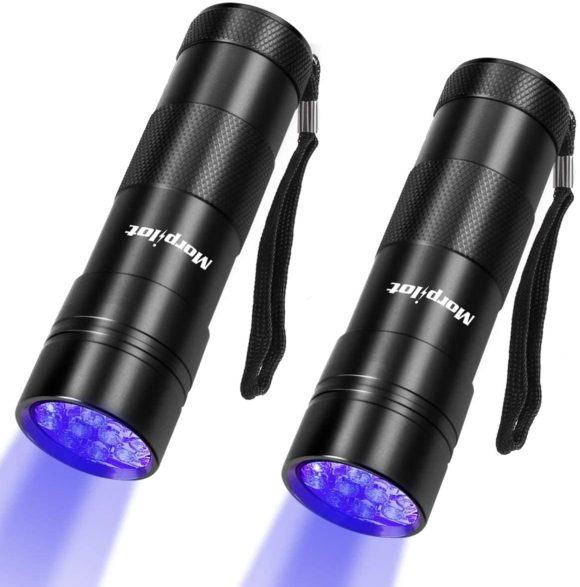
The Cherokee Mine offers some of the fines, unsalted alluvial gem mining in the US. If you live in North Carolina or planning on travelling there, this is one of the finest places you can visit for gemstone flume mining. Few mines offer ore of high enough quality to catch the interest of locals if they didn’t salt it. For just $20.00 and a fee of $5.00 per extra bucket of ore, this is a great deal for the rockhound, gemstone, or lapidary enthusiast.
Related posts:
The post Digging Native Ruby and Sapphire at the Cherokee Mine in North Carolina – Pay to Dig appeared first on Where to Find Rocks.
]]>The post Holiday Gift Guide: What to Get for the Rockhound in Your Life appeared first on Where to Find Rocks.
]]>Disclaimer: Every rockhound is going to be a little bit different, but here are some ideas for you to consider. Once you’ve spotted the perfect item, we suggest a Google shopping search to find the exact model that will work for you. We can make some recommendations of items that have worked well for us, but take a look around and shop smart!
1. Rocks.
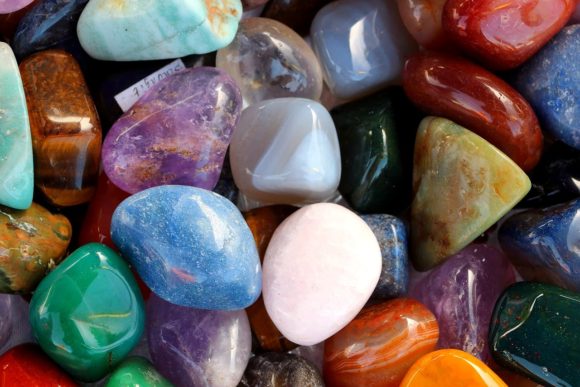
Rocks! (Or maybe more properly in this case: Minerals!)
Obviously. Because what rockhound doesn’t want more rocks? But let’s be honest, some of you might not have any idea WHICH rocks your rockhound will love. We have good news! Many mineral dealers, lapidary companies, and others in the mineral trade DO offer holiday gift cards and holiday promotions! Take the trouble out of choosing a rock and let your loved one choose their own!
Yeah, yeah, we know that gift cards kind of get a bad reputation. But from a true rockhound, the idea that I can go into a dealer’s inventory and pick out something I LOVE is definitely exciting in a way that a gift card to the local fashion boutique will never be.
So how do you find the right company to go through?
First, decide what kind of material you think your rockhound will love – some love mineral specimens, others love gemstones, and others love just rough lapidary material! Find a company that deals in the material you’re looking for.
Next, find a company that has a great reputation. Checking out Facebook and other reviews is a great way to establish whether a company has a good reputation amongst its customers. If you know that your Rockhound has had good relationships with a company in the past, go with that one! (And if there’s a small-time company in your area, think about sharing the love by shopping local!)
Finally, if the company you’ve found doesn’t have a posted notice about gift cards or holiday promotions – ASK THEM! Shoot them an e-mail or a message to their Facebook page – chances are, whoever receives your message will be happy to work with you!
2. Tools.
Every rockhound needs tools. Similar to a rockhound’s choice in rocks, a rockhounds choice in tools might be a little difficult to pin down. We’ve got a few ideas for you though, so take a look at some of these items to see if any of these seem like they fit your rockhound!
The Rock Scoop
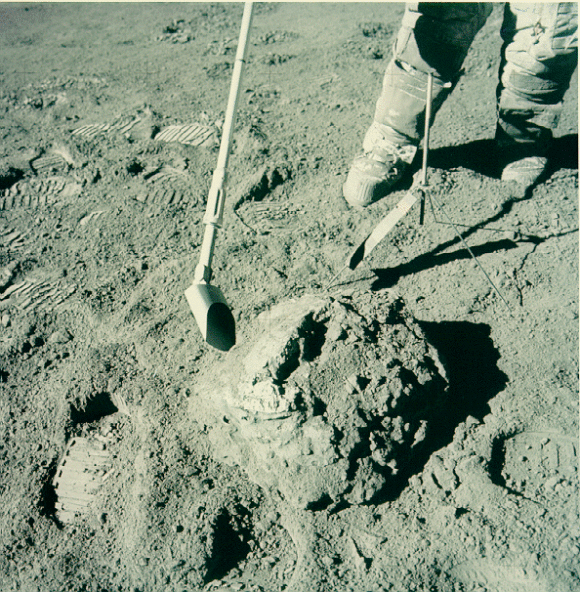
A rock scoop in use by the Apollo astronauts to collect lunar samples! Because the suits worn by astronauts made bending over nearly impossible, the rock scoop allowed them to collect rock and soil samples for return to Earth.
Though your rockhound might not be likely to be collecting on the moon, this is a proven tool. A favorite amongst those who do a lot of beach combing, the rock scoop is a handy gadget that lets you scoooooop up your treasures without bending over. This saves your rockhound on back and knee strain! Of course, this tool works well in places other than beaches too (you know, like the moon!)! We wouldn’t recommend this for the rockhound that likes to hammer on rocks, but for the collector who likes to walk along and pick up treasures, this is perfect! (It can also double as a walking stick!)
There are a lot of different models of this tool out there. Some feature a scoop with holes to let smaller debris fall through. Some are collapsible for easy transport.
The Rock Hammer
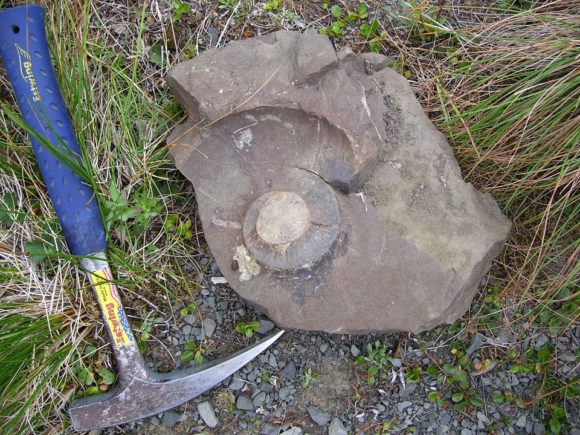
The Rock Hammer – the most essential tool of the Rockhound!
Now, for those of you who have a rockhound who likes to do some damage on your hands, there is no tool more critical than the rock hammer. And even if your rockhound already has a rock hammer, check it! These tools wear out over time, so a new hammer is never a bad thing!
There are a lot of choices in this department, but make one important distinction: NEVER think that a regular hardware store hammer is the right tool. It’s not. Be sure that whatever product you choose is labeled as a rock hammer or a geologists’ hammer. (This author has had great experiences with the tools made by Estwing, but there are certainly other choices out there.)
Note: if you need a stocking stuffer to go along with your gifts, some eye protection is always a great idea when using these tools. Throw in some safety glasses!
The Geo/Paleo Pick
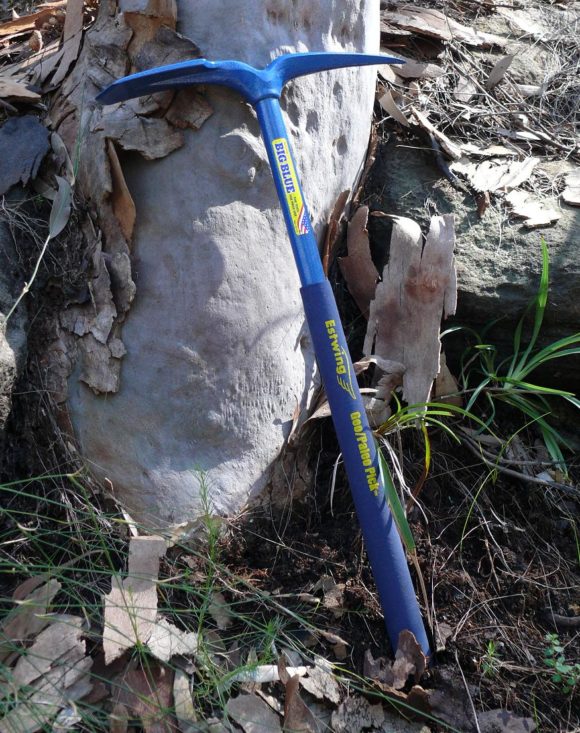
The Geo/Paleo Pick – perfect for a competition over who’s pick is the biggest…
Now, some of you might have a rockhound who’s mastered the rock hammer and needs something bigger. That’s where the Geo/Paleo Pick comes in. This tool features a longer handle for maximum power in the swing. It also has two tips: one pick-end for, you know, picking. The other end is broader and flatter and makes a great tool for scraping away debris.
There aren’t many choices available for this tool, so Estwing is a solid choice.
The Gad Bar:
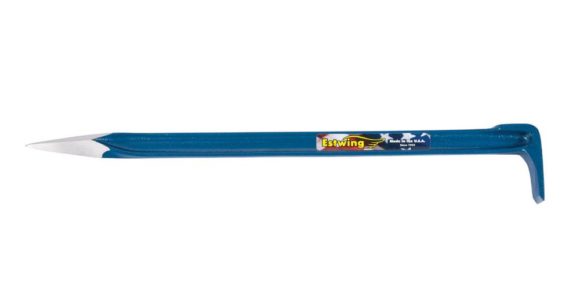
The Gad Bar – for poking and prying.
The gad bar is a tool with a little more subtlety than the hammers and picks, but it is incredibly useful. This is the rockhounds version of the pry bar. There’s a pointy end for sticking into crevices, and a chisel shaped end for wedging into cracks. This tool is great for working in areas where you don’t have the space to make big swings with a tool, or in situations where all you need is a little leverage. (Note: this is the author’s favorite field collecting tool.)
3. Information
One of the most important things you can gift a rockhound is the gift of information! Here are a few different resources you can tap to help your rockhound get more educated!
Field Guides
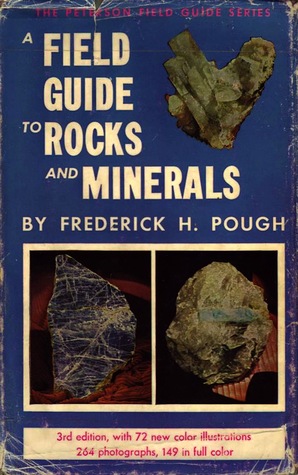
Fred Pough’s classic Field Guide to Rocks and Minerals
Field guides come in all shapes and sizes. Some will cover topics related to field identification of rocks and minerals. There are lots of options in this department! Pough’s Field Guide to Rocks and Minerals has long been a favorite of rockhounds. The author also recommends Sorrell’s Golden Guide to Field Identification of Rocks and Minerals.
Others tackle the subject on a more regional level and will give your rockhound ideas about new places to go and what can be found there. Check out our section on Field Guides for more regional guides.
Magazine Subscriptions
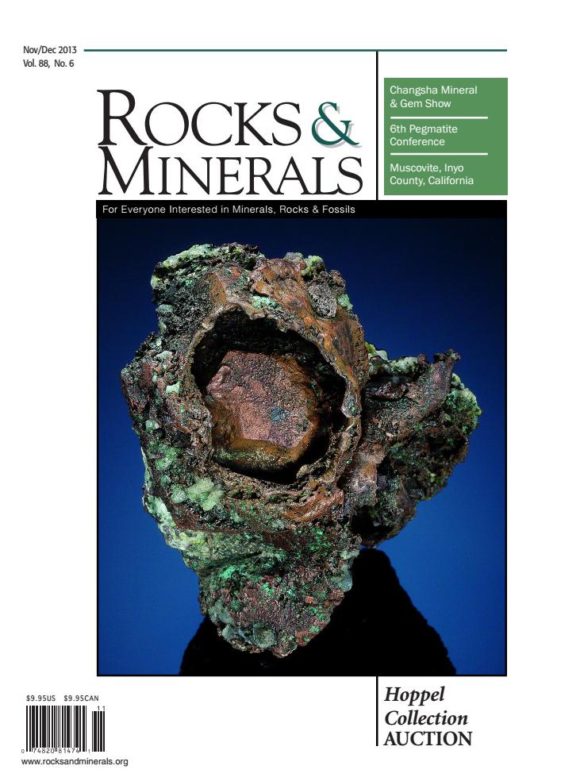
Rocks & Minerals Magazine
Books are a great gift, but several rockhound magazines are also available. Of course, the major perk to a magazine subscription is that you get new information delivered monthly or bimonthly! Several well established magazines are out there, including Rocks & Minerals magazine (offers a wide variety of topics at different levels, though primarily directed towards mineral specimens), Rock & Gem magazine (suited more for those interested in lapidary hobbies), the Mineralogical Record (specializes in mineral specimens) and the Lapidary Journal Jewelry Artist (specializes in lapidary and jewelry). Magazines are a great way to keep your rockhound regularly inspired by new information.
4. Technology
As we move into increasingly advanced times, technology is one of the greatest tools we have accessible. Just because your rockhound is concerned with ancient, dirty rocks doesn’t mean they can’t be aided by technology!
The Dino-Lite Digital Microscope
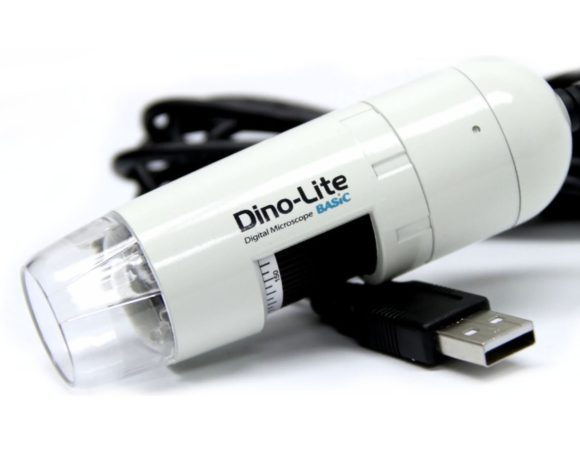
The Dino-Lite Digital Microscope – for looking at small things.
The Dino-Lite Digital Microscope offers a series of microscope options, from handheld USB models to eye-pieces designed to convert traditional microscopes. These tools allow your rockhound to examine the small things! Microcrystals to wood grains in petrified wood, this is a tool that has a wide variety of applications that will allow your rockhound to nerd out at the highest of magnifications.
The Ultrasonic Cleaner
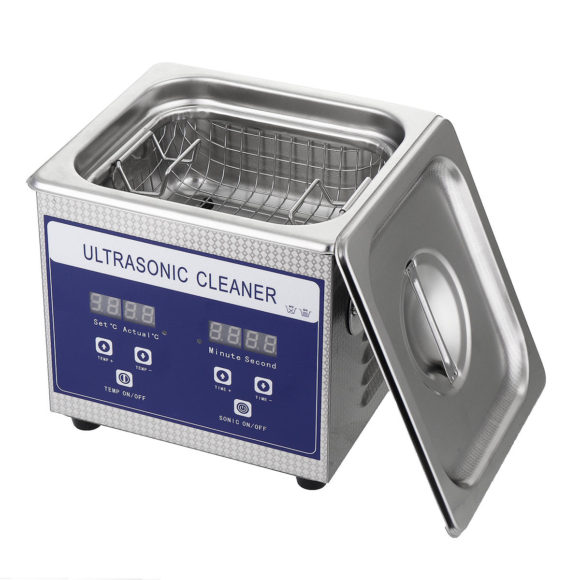
The Ultrasonic Cleaner – reduce the wear and tear on your household supply of toothbrushes!
Ultrasonic cleaners are a device used to submerge an object in liquid, which is then vibrated with high-frequency sound waves. These waves act to scrub the object of grimes, and hit all the surfaces of an object including pores and cavities. Ultrasonic cleaners are often used for cleaning machining parts or jewelry, but they also work wonders on rocks! Take away the burden of hours of tedious scrubbing by investing in one of these machines! (Disclaimer: do not put your water soluble minerals in here unless you want them so clean that they’ve disappeared entirely.)
Handheld GPS Units
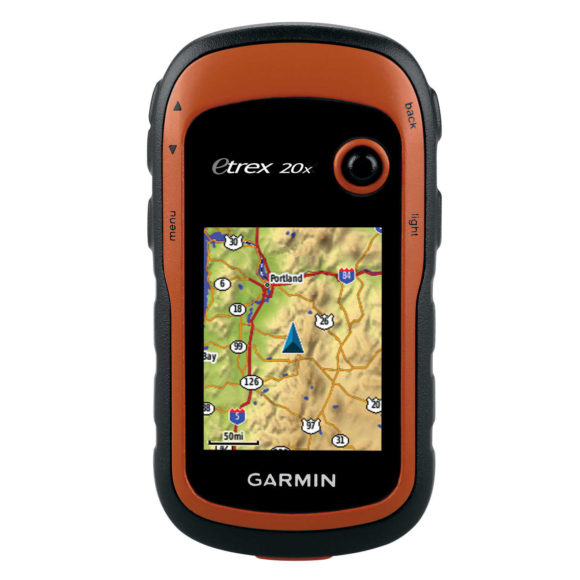
Handheld GPS Units – help your rockhound know where they are and where they’re going!
For those of you who have a rockhound who loves being out in the field, one of the greatest resources you can give them is GPS! Handheld GPS devices can be used to navigate to a new digging spot, or mark an existing one for easy navigation later! Many GPS units feature topographic maps and land status maps, which give your rockhound even more information about where they are and what they can and cannot do while they’re there.
Rock Trimmers
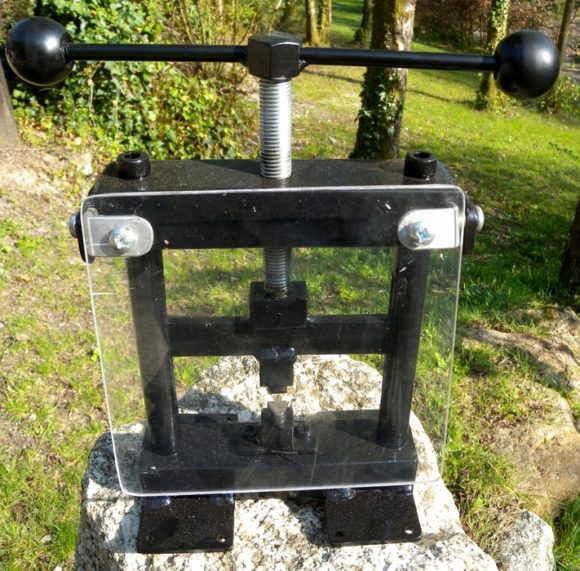
Rock Trimmers – for precision splitting of rocks!
Rock trimmers are perfect for the rockhound who carries home boulders for a small vug of crystals on one side. These tools can be tricky to find, but a variety of models are available – from small and simple, hand-crank units, to large, hydraulic-powered units. All rock trimmers work off the same concept: a rock is placed between two chisel-tipped points and pressure is used to pinch the rock and split it. This method of splitting is not without risk to specimens (sometimes it is going to split where you don’t want it to), but it offers far more control over beating on your rock with a hammer and results in a more natural finish to a specimen than a saw cut. These units can also be adapted to be used in the field, which saves your rockhound the trouble of lugging that boulder home in the first place.
Bonus Section: Stocking Stuffers!
They say it’s the little things that count – so here are some smaller, but very useful items you can throw into your rockhound’s stocking!
Headlamps

Headlamps – for hands free lighting!
Headlamps are an invaluable tool – whether your rockhound is out in the field or trying to organize a dimly lit garage, lighting is always helpful! Headlamps allow your rockhound to have their hands free while still providing plenty of light. These are available in many different brightnesses and light modes.
Chisels
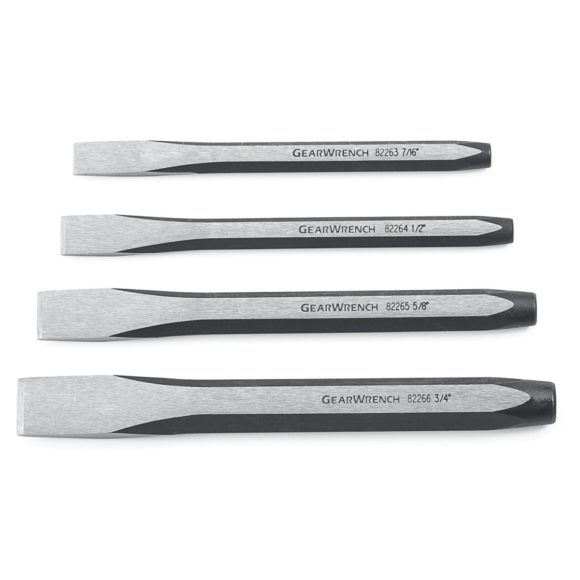
Chisels – necessary, but always disappearing…
Chisels are another indispensable tool for your rockhound. Chances are they have some – chances are that they’ve also lost some! These are easy to misplace, but the good news is they’re easy to replace too! Be sure that you are looking at “cold chisels” when shopping for your rockhound – wood chisels, etc., are not the right tool. Chisels come in a variety of sizes and lengths, and every one of them is necessary for a different situation!
There are an abundance of great gifts for your rockhound – please drop us a note if you’ve got an idea that we missed!
The post Holiday Gift Guide: What to Get for the Rockhound in Your Life appeared first on Where to Find Rocks.
]]>The post Irradiating Minerals – Hot Information For Some Cool Rocks appeared first on Where to Find Rocks.
]]>There are few ways to get a quick resulting change in a mineral that exposing it to high doses of radiation. In nature, this would happen over years and years of time. But with modern technology, some irradiation projects can literally be accomplished over night.

You’re getting my Aluminum Ions all Fired Up!!
I once talked to a collector of quartzes and natural glasses who got a night job working with someone who worked with an x-ray machine in a hospital. Now, I am not condoning abusing your job or misusing equipment, but his tenacity spoke of his strong desire to learn and see what was actually possible by way of radiation exposure.
The affect of light in revealing various minerals in certain formations was first suggested over half a century ago.
The affects of irradiation upon silica gel can effect various impurities or minerals within the substance. Many minerals have been observed to follow the same trends of silica gel. Brazilian agates and quartz both turn smokey when subjected to overnight irradiation because they both contain aluminium impurities in them.
The most reactive and sensitive to radiation is crystalline quartz. The ability to inject or introduce certain impurities into a substance truly alters the ability to manipulate color, and variance in a substance.
There are four main kinds of impurities that might be found in certain silicon agents.
A monovalent cationic impurity atom
A monovalent anion
Half an oxygen vacancy
A positive hole
The type of color that is revealed through irradiation depends upon what pre-existing defects that might already be present in the substance.
The study and knowledge required to be able to understand and even predict that types of minerals that can be introduced in the creation process of a mineral or quartz in order to have the desired resulting color is a remarkably intricate application.
These attempts at human intervention in the creation process of minerals should not be considered a forgery or an affront upon the abilities of nature, but rather a compliment of the abilities of nature to be able to create a more precise and more beautiful specimen.
I have always adhered to the belief that any of these experiments and achievements that are used to bring attention to and appreciation for rocks and minerals can only be viewed as a good thing.
When we are tempted to be put off by or offended by man’s desire to interfere or to arbitrate in the processes of nature we should see these attempt at imitate nature should be considered the purest form of compliment!
Treatment of Spodumene (Kunzite/Hiddenite)
Hiddenite is unaffected by irradiation but are made slightly lighter under UV; yellow or yellow-green are unchanged under Ra, or, if anything, made slightly lighter.
Studies have shown that X-rays make hiddenites slightly darker, whereas radium rays take on a slightly lighter color.
It has also been observed that hiddenites, when heated in oxygen, become pale gray but greener when heated in reducing atmospheres.
Kunzites, under X-ray turn green, fading quickly under light, and even more quickly when heated to 200° – 250° C (392° – 482° F); they have been observed to go green under UV, and from colorless to green under X-rays.
Under radium,Californiakunzite changes from variably from pink to colorless to green, and finally, blue, when heated or exposed to sunlight, before returning to pink – although darker than previous.
Kunzites when pink bleached at 500° C (932° F) and exposed to radium turned green, however when heated to 200° C (392° F) or exposed to sunlight, the pink returned.
The last pink did not bleach at all after heating for 24 hrs. at 250° C (482° F).
Related posts:
The post Irradiating Minerals – Hot Information For Some Cool Rocks appeared first on Where to Find Rocks.
]]>The post Tucson Gem and Mineral Show 2021 Canceled Due to Coronavirus Pandemic appeared first on Where to Find Rocks.
]]>October 26, 2020 Dear TGMS Members; In 1955, the Tucson Gem and Mineral Society (TGMS) put on the first Tucson Gem and Mineral Show® in a grade-school cafeteria. From such humble beginnings sprang what is now collectively called the Tucson Gem, Mineral & Fossil Showcase, which occupies over 50 venues around town from mid-January through mid-February. [In case you’ve missed it in all the hoopla surrounding the commercial shows, our Show, the Main Show, takes place in the Tucson Convention Center.] The Tucson Showcase is by far the world’s largest gathering of gem, mineral, fossil, meteorite and related earth science collectors, dealers and museum scientists. The Arizona Department of Tourism estimates it annually brings about $130 million dollars to the Tucson economy making it our biggest tourism-related event. TGMS takes parental pride in the economic/commercial juggernaut the Showcase has become, but we remain a local, volunteer-based, non-profit, Earth-Science education-focused group open to all comers. [Please visit www.tgms.org for more info.] Our Show is TGMS’s annual gift to Tucson…it is the only show by and for Tucsonans and we are extremely grateful for the support we have always received from our community. We hoped and planned for the best during these difficult days of COVID-19 but find events have conspired to force us to the painful decision to take 2021 off and focus on bringing things back at a higher level in 2022! As members of the Tucson community, we feel we should explain the reasoning behind this decision while emphasizing our full support for the remainder of the 2021 Tucson Showcase in whatever form it takes.
Most importantly, TGMS does not want to be responsible for a single COVID-19 fatality or serious illness. Our Show is run by volunteers and many of us are in high-risk demographics…as are many of our participants and attendees. Consulting closely with the Pima County Health Department, the Mayor and City Manager’s offices and the good folks who run the TCC, it is clear that applying the mandated COVID-19 protocols to reduce risk would mean drastically restricted attendance and curtailment of many of our programs. Second, our Show is much different from the rest of the Showcase. We are the public show with a unique combination of exhibits, school children visits, educational programs, scientific networking and family outreach. We annually create a world-class museum that magically disappears forever after just four days. Our equally enthralling “gift shop” includes a cadre of superb retail gem, mineral, fossil, meteorite, book and jewelry dealers, who complement the exhibits. This unique combination sets the TGMS Show apart from all the other shows in town.
Third, we expect that our Show dazzles everyone with displays of exquisite minerals, gems, jewelry and fossils brought by the worldwide Mineral and Gem Community. Restrictive COVID-19 travel policies mean many of our major domestic, and most of our international museum exhibitors and friends either won’t or can’t travel here. This effectively eliminates both our exhibits and educational programs. COVID-19 related risks clearly make it impossible for TGMS to put on anything more than a shadow of our accustomed vibrant event. So, we’ve decided that it makes more sense to conserve our resources and apply them towards a Blockbuster 2022 Tucson Gem and Mineral Show®. We promise to pull out all the stops to bring you an unparalleled group of eye-popping fluorescent mineral exhibits, colorful minerals and gems from around the world, and some special surprises to shake everyone out of their post-Covid lethargy!!! See you in 2022!
Les Presmyk: TGMS President
Peter Megaw: TGMS Show Co-Chair
Richard Gottfried: TGMS Show Co-Chair
Patricia McClain: Executive Manager
So, with that, yes, one of our companies is REALLY sad not to be vending at Tucson, now our home city.
If you want some colorful minerals trapped in resin, come check out Parallel Power Products
Related posts:
The post Tucson Gem and Mineral Show 2021 Canceled Due to Coronavirus Pandemic appeared first on Where to Find Rocks.
]]>The post Chemical Reactions – Chemical Reactions that Alter the Appearance of Minerals appeared first on Where to Find Rocks.
]]>
People might have laughed when I was just a lowly calcite, but now, oh yes, NOW, they will PAY!
A rich solution of Copper Sulfate and water is used to turn calcium carbonate crystals, both Calcite and Aragonite, into green and blue. As the crystals soak in the solution over the course of 2 – 4 weeks, the crystals will start to develop a blue coloring which then becomes a rich green, similar to fine Malachite specimens.
Sodium hypochlorite, or common household bleach, will turn several lead minerals into interesting shades, notably, the red color that is given to the skin of Anglesite crystals. The color change varies by time exposed to the bleach, as it will start to increase the red hue from duration of exposure. The color change is only on the surface of the crystal, as the sodium hypochlorite mixes with the lead to form a thin layer of the mineral minimum as an alteration.
Iron Oxyhydroxide Staining– It’s often desirable to remove iron oxyhydroxide staining on minerals to improve their appearance. These stains, often appearing as yellow, orange, or red coatings are composed primarily of iron oxyhydroxides such as limonite and goethite, and less commonly of iron (III) oxide (hematite) or potassium iron (III) sulfate hydroxide (jarosite.) Super Iron Out is likely the most commonly used commercially available reagent for removing iron staining on minerals; the primary active ingredients are sodium hydrosulfite and sodium metabisulfite which are both chelators and reducing agents. Sodium carbonate and citric acid are added as buffering agents. All other ingredients are decomposition products of sodium hydrosulfite and sodium metabisulfite. Check out the MSDS for more info: http://www.summitbrands.com/summit/downloads/msds/usa/MSDS%20Super%20Iron%20Out.pdf
The temperature, pH, and concentration greatly affect the potency and reactivity of Super Iron Out, although the buffering agents do help to slightly stabilize the properties. When testing out a solution of iron out to clean sensitive minerals, it is best to start with a room temperature, fairly weak solution at neutral pH. If more potency is desired, the concentration of Super Iron Out can be raised, the pH can be changed by addition of an acid or base, or the solution can be heated which increases reactivity but also quickly decomposes the active ingredients. If you want to get really technical with any sort of cleaning, I recommend development of a rough ternary diagram with the three axes being temperature, pH, and concentration (in weight/volume or molar) and points graphed being a numeric scale of “cleaning effectiveness,” which is sort of arbitrary, but you will notice the cleaning ability that certain temp-pH-concentration domains will have. It’s not wise to use Super Iron Out on phosphates, sulfides, transition metal sulfates, many carbonates, vanadinite, and evaporites as they will alter or discolor the surface.
Oxalic Acid is perhaps the most popular reagent used to clean iron staining from Arkansas and Brazilian quartzes. Oxalic acid cleans via chelation- it forms many highly stable complexes with transition metals- in our case iron. Oxalic acid can be purchased at hardware stores as wood bleach. Note that it is slightly toxic and needs to be handled somewhat carefully. It’s highly soluble in water and can readily be dissolved to make a fairly concentrated solution. If any acid soluble transition metal containing minerals (such as pyrite, siderite, malachite, cerussite) are present on the specimen you wish to clean it is best to stay clear of using oxalic- you can create a nasty pitting and prominent discoloration of the surface. The discoloration on iron minerals is mustard yellow which is the most common form of residue encountered from poor cleaning with oxalic acid.
The post Chemical Reactions – Chemical Reactions that Alter the Appearance of Minerals appeared first on Where to Find Rocks.
]]>The post Smoky Quartz and Granite Pocket Minerals- Marathon County, Wisconsin appeared first on Where to Find Rocks.
]]>Overview: Specimens of smoky quartz forming in granite are commonly seen from Colorado, California, Montana, or New Hampshire and not associated with Wisconsin! Surprisingly, there have been quite a few nice specimens of smoky quartz and feldspar found in Wausau County, approximately around the Rib Mountain area. Known mostly among locals, this area hasn’t gained much popularity among collectors, but has the potential for many future great finds.
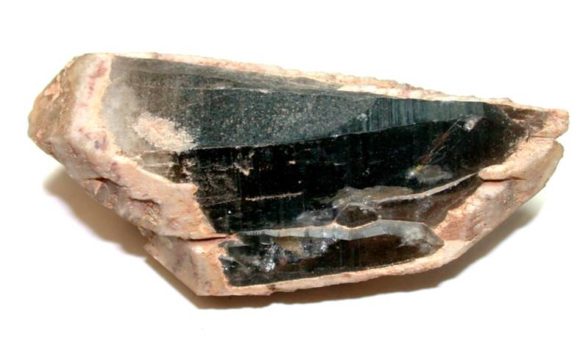
Smoky quartz from the Nine Mile Pluton in Wausau County, Wisconsin. 9cm field of view! Photo by Al Falster : https://wgnhs.wisc.edu/minerals/quartz/
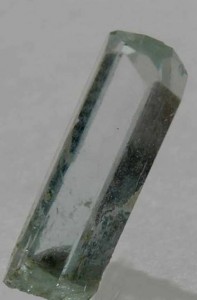
A beautiful, gemmy beryl from the Nine Mile Pluton in Wausau County, Wisconsin. Tiny crystal. 2cm field of view. https://wgnhs.wisc.edu/minerals/beryl/
Prospecting: Even though most of the locations that yielded the specimens above are likely private, there are probably plenty of other areas one could find to dig crystals since specimens are recorded as coming from a variety of spots within the area. See Mindat for more info: https://www.mindat.org/loc-24286.html
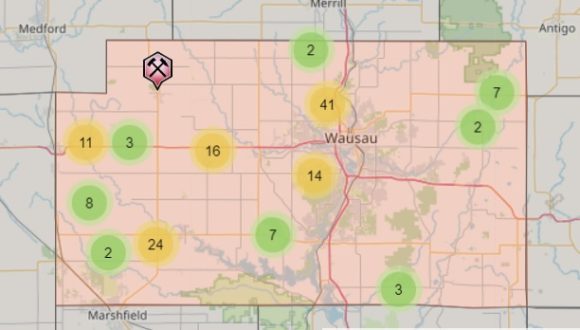
Localities in Marathon County recorded to mindat.org
Viewing the image above, one can see there is a huge amount of localities in this area. Looking at the mineral list and description on Mindat, the location is known for extremely old rocks and nice exposures of them- “ Marathon County displays some of the best outcrops of Precambrian rock in the state. Many of the rock occurrences are of interest to the mineral enthusiast.”
Many of the ancient intrusions that blasted through the complex igneous and metamorphic country rock are of unusual compositions. Additionally, they are extremely weathered and “rotten” meaning they are very easy to dig through.
Granite when unweathered tends to be one of the most difficult rocks to work, and hard rock mining it is a laborious task. Due to the fact that that the granite has been decomposed to the point where it falls apart means no hammer or chisel would be needed to dig them. Perhaps just a shovel or pickaxe!
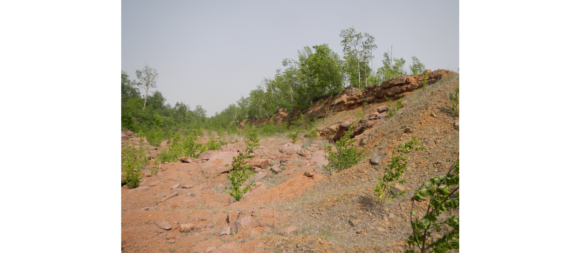
Notice how this granite is just falling apart into pebbles. At this particulat quarry, the Beilke Quarry, a variety of minerals were found including Microcline, Smoky Quartz, and Phenakite. This location is private and reclaimed.
It seems like the rotten granite occurs around Wausau. I would try to find some sort of public land you could freely prospect, or contact someone with interesting rotten granite or an abandoned quarry on their land. Crystals may be loose in the dirt, or may be clustered up and held together with clay within the weathered granite. Minerals found in the boulders are also reported. Weathering and alteration often left “cores” of more resistant rock.
This granite is “miarolitic” meaning as it rose when it was injected into the continent, gases dissolved within it bubbled out as it depressurized. These bubbles often were trapped in the solidifying rock before they could diffuse, and crystals grew inside as the rock cooled and vapors interacted with quartz, feldspars, and micas.
The premier location in the area appears to be the Bielke Quarry in Wausau, which unfortunately is reclaimed and off limits, but yielded beautiful specimens of amazonite that are of notable quality for the US. See: https://www.mindat.org/gallery.php?loc=24286&min=2704
Rib Mountain, contained within Rib Mountain State Park may be a good area to start learning about the local geology. Mineral collecting is likely not allowed in the park, but one could look around for crystals to understand the geology, but leave them be. Crystals have been reported as coming from Rib Mountain, so searching for pockets in granitic rocks exposed there may be a good place to understanding how to find them where you could regularly dig for them.
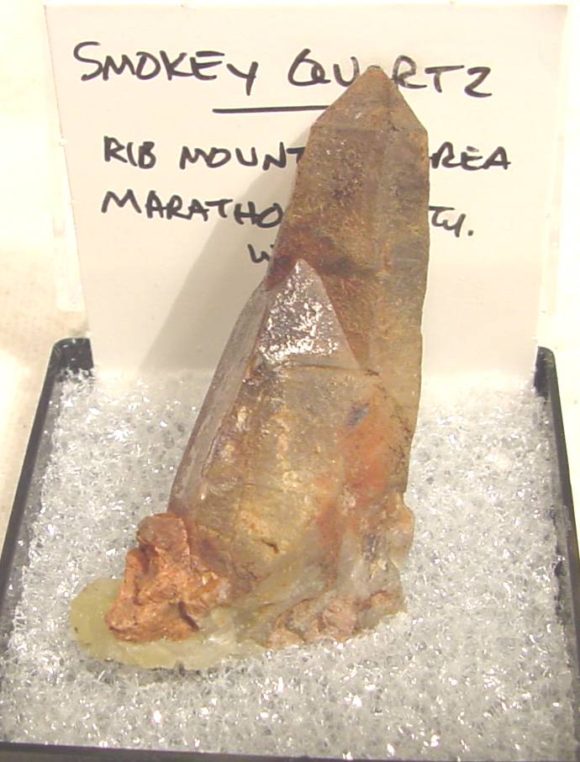
Searching around, I found a local talk about finding a large pocket of fine smoky quartz in his back yard. Props to this guy for having some nice collecting he can do so easily!
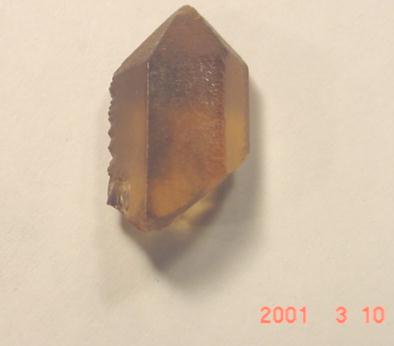
As you can see, a gorgeous smoky. Check his other Wisconsin minerals out here! http://huntforgems.com/minerals/wi.html
He states he found 32 crystals so far and they were embedded in a red clay. Interesting to note what he found them in.
Tools: Unlike some miarolitic granites which are very hard, these Wisconsin granites are often weathered to the point where you would expect to use a shovel, pickaxe, or hoe to move material. Use a screwdriver, chopstick, or bamboo skewer as a probe when you see anything that looks like a pocket. Wooden pocket tools are the safest for removing the crystals undamaged.
Unweathered granite is present in Marathon County too, and this can be mineralized. For this kind of rock, crack hammers, chisels, wedges, and prybars are likely your tools of choice.
There are a diverse array of minerals in this area of Wisconsin, so you will need to be creative and adaptable.
Conclusion: Considering the abundance of specimens of Smoky Quartz and Feldspar from Colorado, other locations with the same kinds of minerals are frequently overlooked. This example of such an overlooked area with similar mineralization deserves more attention, as it seems to be slipping into obscurity. This article serves as a guide to get the mental juices flowing, to help perhaps inspire a collector to make an exciting, beautiful find in this area.
Related posts:
The post Smoky Quartz and Granite Pocket Minerals- Marathon County, Wisconsin appeared first on Where to Find Rocks.
]]>The post Dyeing Agates – Who wants to dye some agates? appeared first on Where to Find Rocks.
]]>Dyeing of Agates Explained Here!
We will explain to you the process of dyeing agates, how to prepare them and how to dye them, with chemicals and tints.
Dyeing Agates
To start, the word agate will be used interchangeably with the word “chalcedony”, as they are the same thing. A suggestion is to place a piece of material to be dyed into a solution of Potassium Chromate
overnight. If the stone is yellow in the morning, dyeing will be easy to accomplish.
Processing
First, ensure that the material has been cleaned, to remove any debris, and of course, best, to have already slabbed, cabbed, or polished the stone to be dyed. The oils must be removed from the stone entirely, which can be done as such. Bring to boil the agate in a strong solution of water and sodium carbonate.
Allow this to cool and remove the agate and place in a pot of clean water and heat to a near boil, then cool, which should remove the traces of sodium carbonate. Then, place the agate into cool concentrated nitric acid,
which will remove any iron compounds. Heat this material for 24-48 hours, bring to a near boil for several hours at the very end of the cycle, then after cooling, wash and heat to a boil the agate in a clean water bath three or four times, at which point you will have the most professionally prepared agate ready for dyeing.
How to Dye Agates Red
To dye agates red, the solution is as follows.
Place 1/4 pound of iron filings
into 1 lb of concentrated nitric acid. The resulting fumes are going to be a corrosive, poisonous brown fume, so this mixture must be done outside or under a lab hood. This stuff will bubble and heat up, allow to cool for 24 hours, then decant the clear liquid into another container. This is iron nitrate, the liquid needed for the next step.
Place the cleaned, prepared slabs into the liquid iron nitrate produced from the last step and allow to soak for between 1 to 4 weeks, depending on thickness. 1/8′ needs a week, 1/4″ needs 3 weeks and 3/8″ needs 4 weeks to dye. Remove the agate, wipe them dry and place into an oven to gradually heat. Bring the material up to 365 degrees and heat for 3-5 hours. At this point, it is time to soak the agates in the iron nitrate for an equal amount of time, repeating the drying step after soaking, but for a lot longer, 2-8 days, depending on thickness. This long drying is needed, in a roasting pan
, as the final step is to raise the stones to 450 degrees and the long drying is needed to make sure the stones do not explode when the stones are brought up to that temperature Allow to cool, then, remove from the roasting pan
You should have a deep red colored agate. Note, while lab grade iron nitrate is available, the professional lapidary artisians claim it does not produce the same results.
How to Dye Agates Black
Dissolve 375 grams of sugar into a liter of water, producing a thick liquid similar to honey. Soak the slabs in this solution, heated to slightly above room temperature for 2-3 weeks, adding water to the solution as it is lost from evaporation. Rinse the slabs off and place into a bath of concentrated sulphuric acid
, which you will then warm slowly over an hour until the solution finally reaching 635° F for an hour. Allow the solution to cool, then remove the agate and wash, repeating the process to remove the acid. Soak the slabs in a solution of sodium bicarbonate to neutralize the leftover acid.
How to Dye Agates Blue
Bright blue agates are very desirable, below you can find the recipe for making this material.
Dissolve 250 grams of potassium ferricyanide
into 1 liter of lukewarm water. Place agate into this solution, kept at a lukewarm temperature, for 1 to 2 weeks. After soaking, wash the slabs and place into a solution of lukewarm ferrous sulphate
for 10 days. This solution will cause the compounds within the stones to react and form the bright blue color that people known and recognize.
How to Dye Agates Green
Take 620 grams of chromium trioxide
in 1 liter of water and place agates into the solution for 2 weeks, or longer if material is thick. Remove the material, rinse and place in a sealed container with ammonium carbonate,
to sit for 2 weeks. After this time remove the slabs from that container, place into a roasting pan
and place in an oven to “fire” the agate, bringing the oven up to 500 degrees for a few hours.
How to Dye Agates Yellow
Soak the agate in a concentrated solution of Potassium Chromate,
then wash and dry, which should give you a nice yellow tone.
And with this, our limits of dyeing knowledge are capped. All of these procedures should be done under a lab hood or outside. MSDS sheets should be reviewed before working with any chemicals and proper lab equipment, including safety glasses, gloves and proper eye wash stations, anti-acid creams and clean up kits available.
The post Dyeing Agates – Who wants to dye some agates? appeared first on Where to Find Rocks.
]]>The post Smoky Quartz Crystal Digging- Moat Mountain, White Mountain Nat’l Forest, New Hampshire appeared first on Where to Find Rocks.
]]>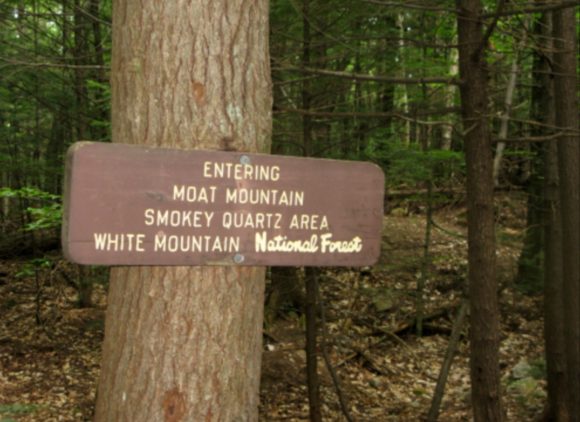
Welcome to Moat Mountain! Here is beautiful example of the typical smoky quartz and microcline combo found at this locality.
For more info and directions, Nat’l Forest Service page: https://www.fs.usda.gov/Internet/FSE_DOCUMENTS/stelprdb5382896.pdf
Background:
The iconic New Hampshire locality, Moat Mountain has been popular for its gorgeous smoky quartz and microcline specimens for decades. New Hampshire is known as “The Granite State” so it is fitting that specimens at its signature locality occur in a granite. In many ways, these specimens bear resemblance to other granitic quartz and feldspars from throughout the US, such as those from Colorado and Montana. The association of smoky quartz and feldspar is very typical in a miarolitic granite. More about how exactly these crystals form later.
One of the few if only free, open to the public dig sites in New England where pocket smoky quartz crystals can be found, this location is maintained by the National Parks Service and is accessible from mid spring to early autumn. The severe winter weather in the area makes collecting during that time impossible. Nearly the entire mountain has various mineral locations for smoky quartz, amethyst, microcline, and fluorite, but please respect where the parks service allows and doesn’t allow digging.
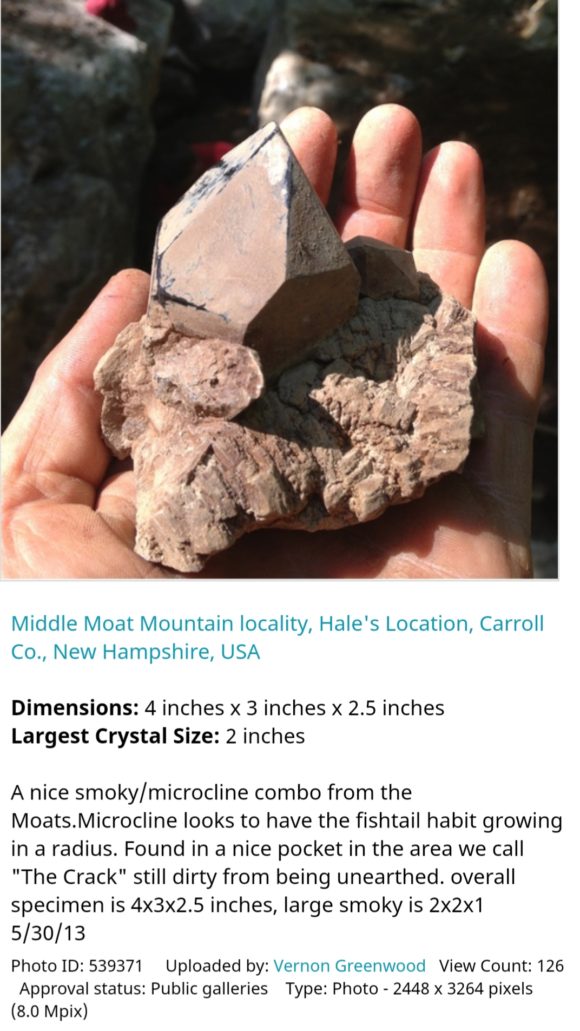
Geology and Minerals:
This locality occurs in miarolitic granite and these crystals are over 200 million years old. The minerals at this location formed at the contact between the Conway granite and the Moat Mountain volcanics. These volcanic rocks were part of a very active ancient volcano. As they rose and depressurized, gasses escaping from them were trapped by the surrounding Conway granite, forming the smoky quartz, microcline, and other minerals. The chemistry of the gasses was pretty simple, but enriched in fluorine which gave rise to some of the rarer, highly collectible minerals at the site.
Minerals:
Smoky Quartz: Commonly found in miarolitic pockets. Gemmy, very lustrous smoky quartzes are abundant. Usually they are an inch or less, but crystals to over a foot have been found. Some of the Moat Mountain pockets have been massive. It is still possible to find large pockets here, but it requires a lot of both work and luck.
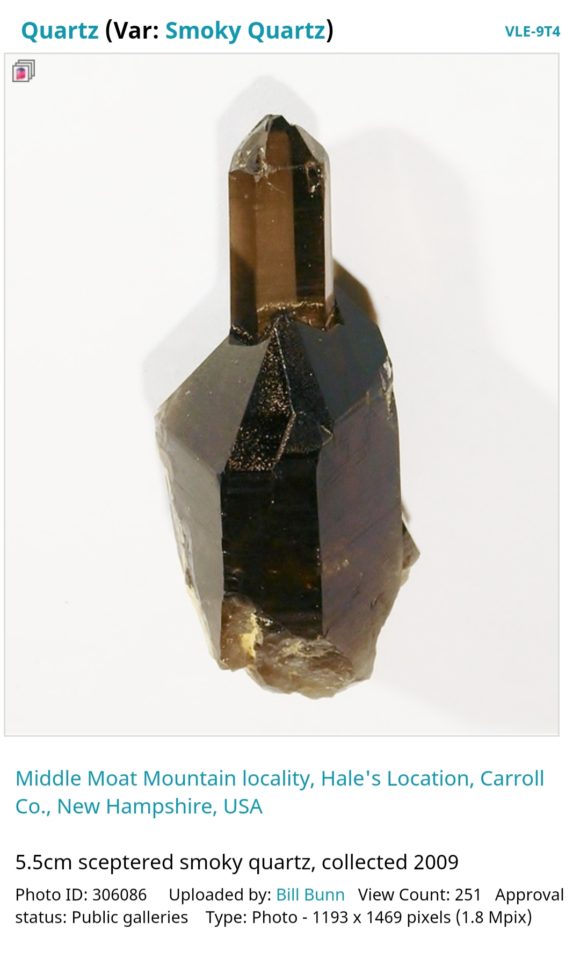
Some fantastic examples on Mindat of smokies collected at Moat. Note the red mud on the freshly pulled piece. These gorgeous specimens are proof good finds at Moat can still be made.
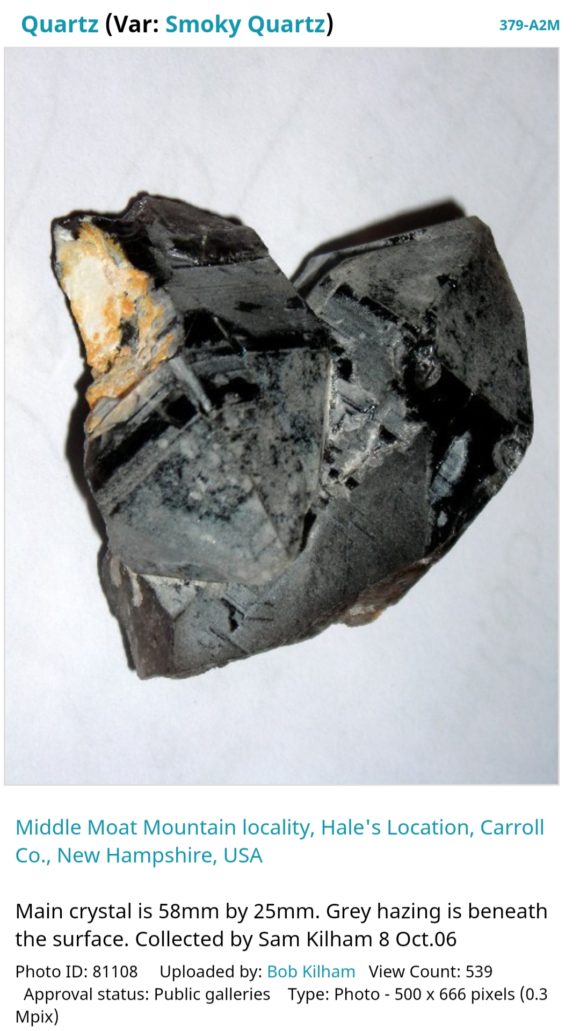
Fine Smoky Quartz Crystal from the Granite of New Hampshire
Microcline: Blocky crystals of microcline provide the matrix for many smoky specimens. They represent the walls of the miarolitic cavities. Often overlooked, these microclines make fine specimens on their own. Beautiful blue green amazonite and Baveno twinned crystals have been found on occasion.
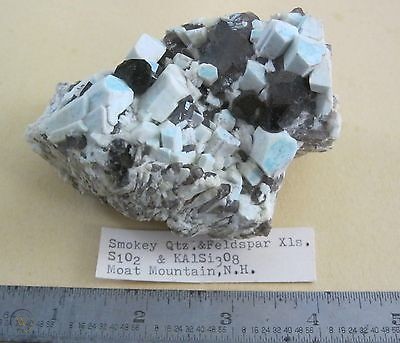
Old school specimen of smoky and amazonite from Moat Mountain
Topaz and Fluorite: The ultimate Moat Mountain specimen is a fine topaz, however this mineral is extremely rare here. When found, it is known to produce gorgeous gem quality champagne, pale blue, or colorless crystals that are sometimes slightly etched. Specimens can exceed five centimeters.
Fluorite crystals to several centimeters in diameter have been found on Moat Mountain. Also a rarity, they are quite sought after. Fluorite is a fragile, sensitive mineral so it often weathers away if it is at all present in a pocket. It occurs primarily in green, blue, and purple at this locality and can form cubic or octahedral crystals.
Directions (From Forest Service):
From West Side Road in Conway turn onto Passaconaway Road. Travel 1.2 miles and turn right onto High Street (dirt road). This road leads into the White Mountain National Forest, passing a gate at 1.4 miles. At 1.7 miles, bear left and continue 0.7 miles to the parking area at the end of the road. The Moat Mountain Mineral Collecting Site is a 0.9 mile hike from the parking area. On the Mineral Site Trail, keep right at both branches.
GPS Coordinates: • Moat Mineral Collecting Site Trailhead: 44.021700, -71.169500
Collecting Tips: There are many ways to collect this material. A popular way is to dig through loose, weathered rock paying attention for crystals and pocket sections. A hand rake and shovel are good for this. It pays to dig deep, past areas that have already been searched.
Another method is searching ledges for pockets and working the rock. Observe how plants grow, often roots will follow crystal bearing pockets and seams because they are open space easy for them to take hold in. Breaking the granite is hard work and requires a lot of hammering and chiseling. An assortment of wedges, chisels, hammers, and prybars would be a good idea to bring. Use large, flat wedges to exploit cracks in the rock.
This location is remote, so bring food, water, and bug spray especially if you plan on staying there for a while.
Related posts:
The post Smoky Quartz Crystal Digging- Moat Mountain, White Mountain Nat’l Forest, New Hampshire appeared first on Where to Find Rocks.
]]>The post Using an App to find Property owners of Rockhounding Locations – onX Hunt- Finding Property Ownership Quickly for Prospecting appeared first on Where to Find Rocks.
]]>When you download the app, you get trial use of it for 7 days and a choice of boundaries in one state. This app is subscription based and offers a premium subscription for $29.99/year that allows you to view property boundaries for one state, or an elite subscription where for $14.99/month or $99/year you can view property boundaries in all 50 states for one year. It is geared towards hunters, but it can be very useful for other outdoor activities like rockhounding, too.
When I downloaded the app, I chose Pennsylvania. Below is a screenshot of land around Hometown, PA
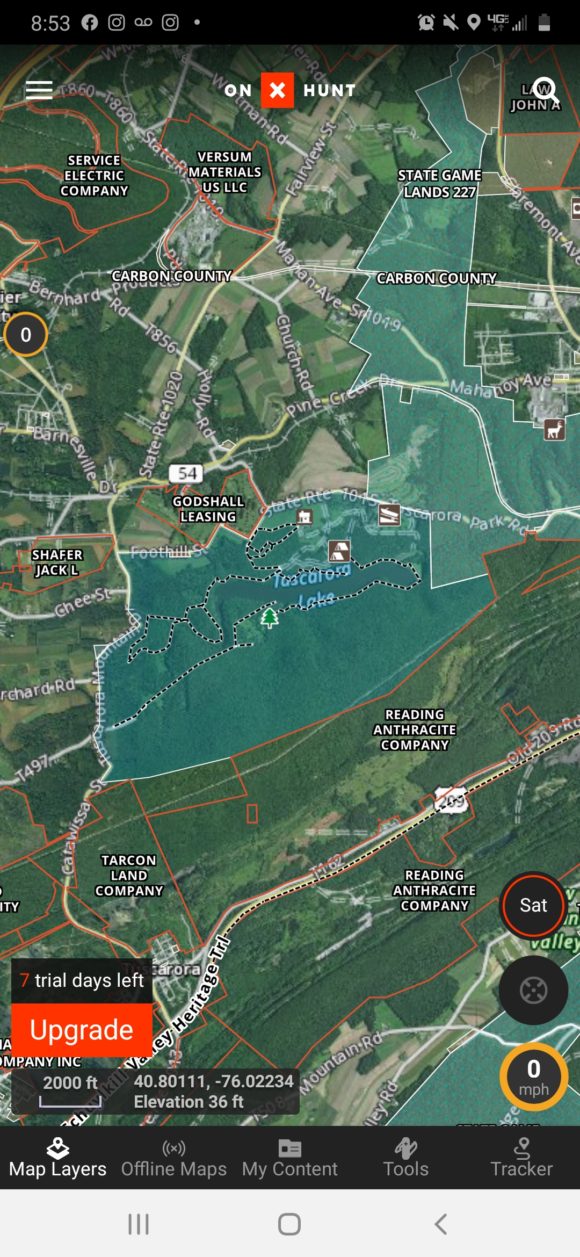
Overview of what OnXHunt shows on a sample screen
As you can see, the boundaries of various properties are outlined clearly on the screen as well as town names and counties. In addition, various useful navigation parameters such as speed and altitude are displayed.
When you click on a point, the boundaries are highlighted in green. A green cursor also appears at the point you click. Here I click on PA state gamelands and clearly the owner of the property is displayed as well as the size of the area. It shows that the PA State Game Commission is responsible for this land.
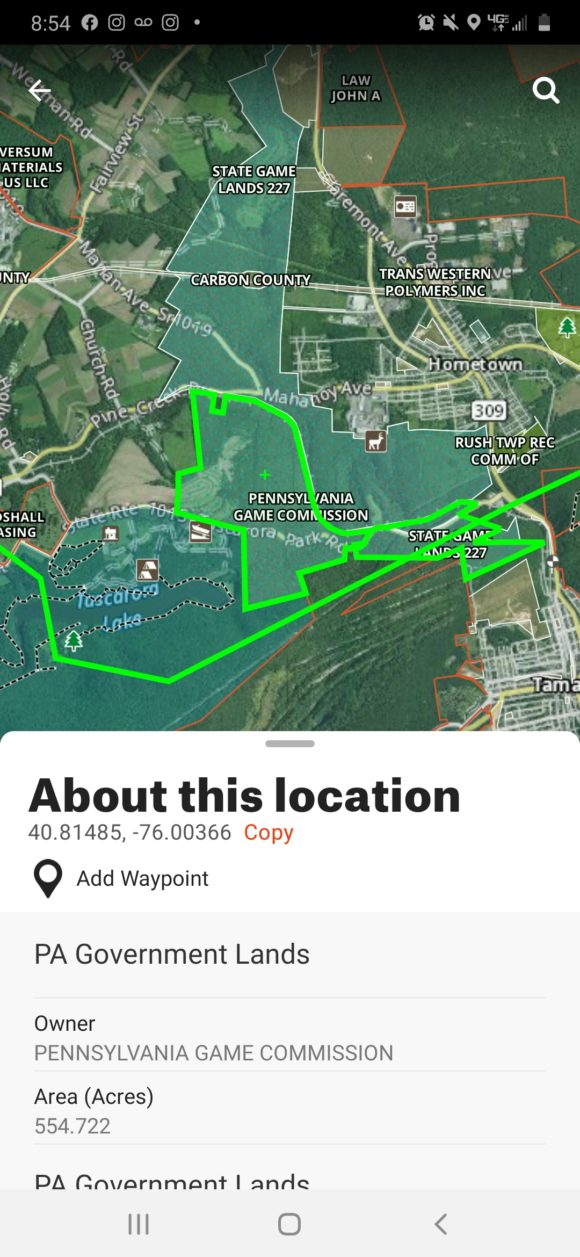
Gamelands shown clearly on the app, OnXHunt
Let’s say I wanted to check out the abandoned coal strippings west of town. Unfortunately, on the app this displays it is private property. When I click on the strippings, the pull up window provides the owner of the land, so if you wanted to explore it you could hypothetically contact them
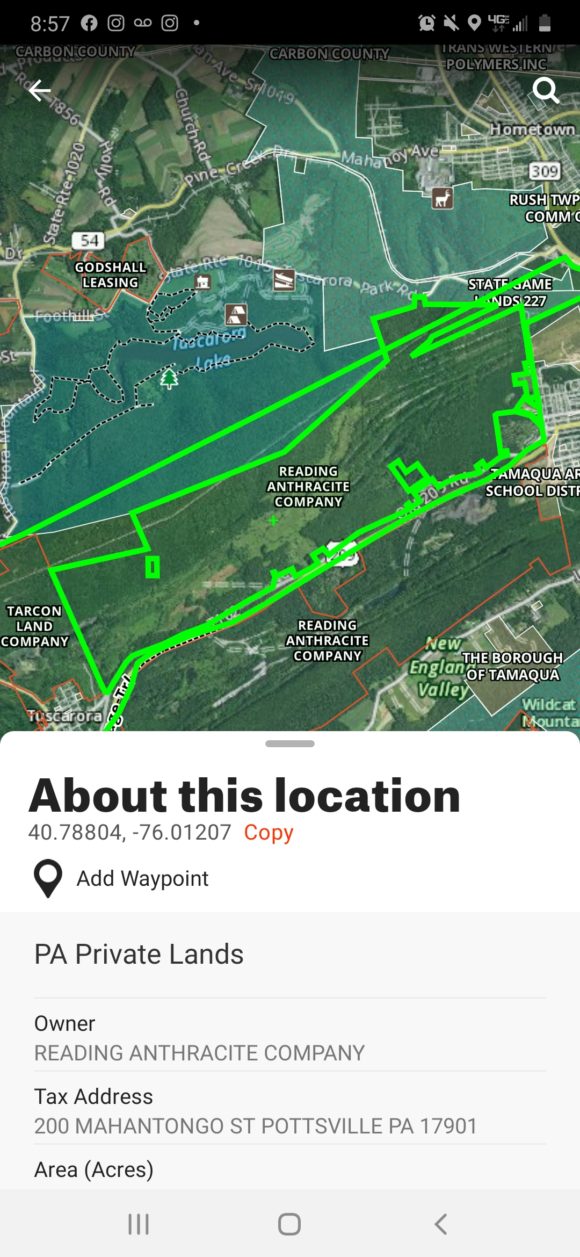
Property Ownership information shown on OnXHunt
Before this app was available, it was tedious searching records for owners and contacting them for permission. It is so easy here, in a very self explanatory maps like format.
Pros: Extremely intuitive and easy to use. An extremely practical app for mineral collecting that could be an indispensable tool that allows you to plan many more trips.
Cons: Kind of pricy, with a year subscription for 50 states costing $99. Perhaps it is really difficult keeping this app updated, as the task of finding property ownership is somewhat difficult at times. It would be worth it to someone who loves to rockhound, as I am sure your finds would exceed the cost of this app. Check out the website at OnXMaps.com
Related posts:
The post Using an App to find Property owners of Rockhounding Locations – onX Hunt- Finding Property Ownership Quickly for Prospecting appeared first on Where to Find Rocks.
]]>The post Dig Quartz – Milky, Smoky, and Amethyst at Diamond Hill, Antreville, South Carolina appeared first on Where to Find Rocks.
]]>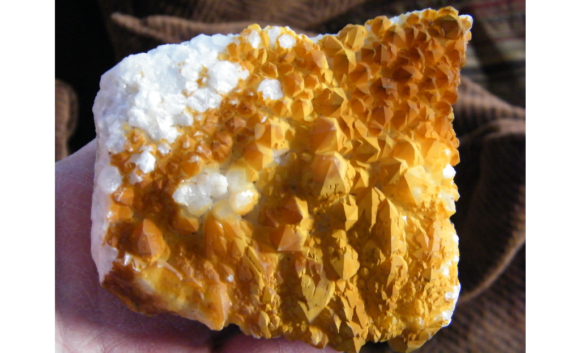 These specimens of quartz, collected by John Krygier: https://www.mindat.org/gallery-13767.html, are typical examples of what you can find at this mine. The black coating is due to manganese oxides, and the orange coating is due to iron oxides.
These specimens of quartz, collected by John Krygier: https://www.mindat.org/gallery-13767.html, are typical examples of what you can find at this mine. The black coating is due to manganese oxides, and the orange coating is due to iron oxides.

Amazing amethyst cluster found by a guest to the mine. This photo of Diamond Hill Mine (Courtesy of Tripadvisor)
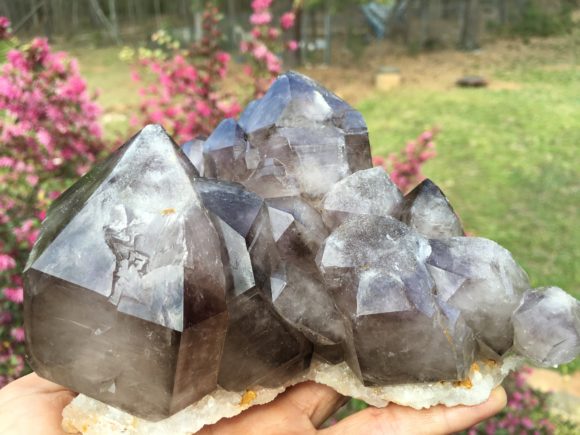
Smoky amethyst found at the mine and featured in their online gallery.
https://diamondhillmine.com/gallery/
Geology: The Diamond Hill Mine is hosted in a granite, and is one of numerous quartz localities in the Eastern US to be hosted in such geology. As the granite cooled, water rich in silica and other chemicals became less soluble in the molten rock, escaping and creating veins hosting the quartz crystals. Pegmatites — coarse grained rocks also formed in the granite as a result of cooling, and these are where rare elements escaped to, forming minerals like beryl. Subtropical weathering broke down the feldspar in this granite into clay, exposing this deposit very slowly over the eons.
Digging: This is a site good for rockhounds of all experience levels. Hand tools are welcome and there are many strategies for collecting in the various pits at the mine. Be aware of which areas allow public digging. Machinery in the main workings dig up material for guests to search for in massive spoils piles. Surface collecting is your best option here. Bring gloves, a small rake or trowel, a screwdriver or stick to poke around, and some water to rinse off your finds.
You may also decide to try to find your own vein and work it. This method doesn’t guarantee you’ll get anything- the results vary, but there is a possibility for you to get incredible material if you develop a skill for understanding this location. You will need a hammer, chisels, pickaxe, shovel, buckets, and water for rinsing material to work these veins. You will likely have to move a lot of rock.
General Information & Pricing
Diamond Hill Mine
100 Diamond Mine Road
Abbeville, SC 29620
(864) 934-3744 or (864) 446-7357
Camping is available on site. Tents and small motor homes are welcome. Camping is free, but please call the mine in advance to make reservation. Call Gina Clary at (864) 934-3744 or email at dhmine@rocketmail.com.
Bring food and water! Also bring sunscreen and bug spray! The only facilities are an outhouse and picnic tables. There is no running water. The closest place for supplies is a mini-mart type gas station about 5 minutes away.
Digging is from time of registration to sunset.
Adults 18+ : $20
Teens 13-17: $10
Seniors 65+: $10
Children 6-12: $5
Children 5 & under: FREE (as well as non-collectors but they will not be allowed in the collecting area.)
For larger groups, discounts are available. Visit diamondhillmine.com for more information.
Article by Jeremy Zolan
Sources:
https://www.gamineral.org/_docs/11-16may04.pdf
Related posts:
The post Dig Quartz – Milky, Smoky, and Amethyst at Diamond Hill, Antreville, South Carolina appeared first on Where to Find Rocks.
]]>The post Product Review: Cut That Agate- Speedy Tumble Rapid Refil Kit – Tumble Stone Polish Kit appeared first on Where to Find Rocks.
]]>Insta: @leaverite_tycoon
Speedy Tumble is a product released by Cut That Agate that provides the rough material and everything you need to tumble a wide variety of stones to a high, professional looking finish in under 1 month time. The only thing not provided are the tumbler itself, water, and optional Ivory soap. In essence, it is the fast food of tumbling- an inexpensive, highly consistent product that can be made in a comparatively short time. Unlike fast food, the quality of the product is great and I am very satisfied with the fact that there were probably over 50 different kinds of rough in my assortment. You get 4 pounds total. Speedy Tumble also includes a bag of one pound of premier material too. I think my bag had some almandine garnet. I think it’s amazing what they give you for only $30!!
Speedy Tumble Rapid Refil Kit for Tumbled Stones – as it arrives in the mail.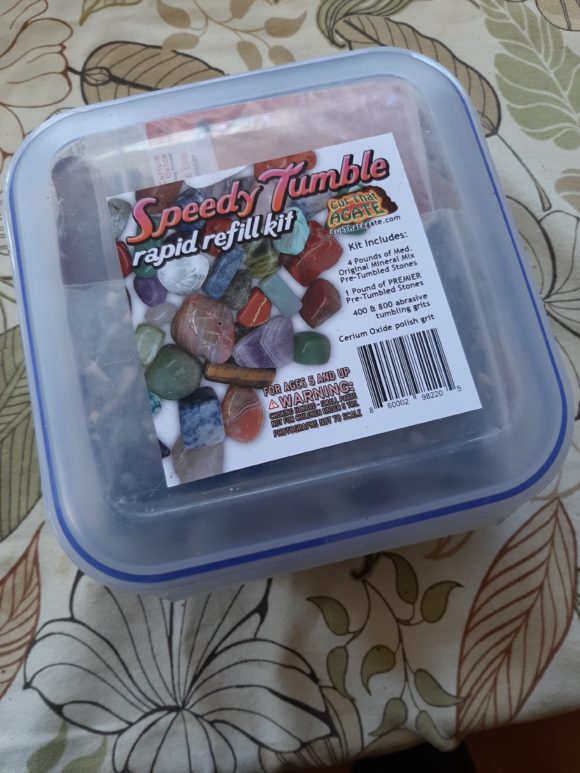
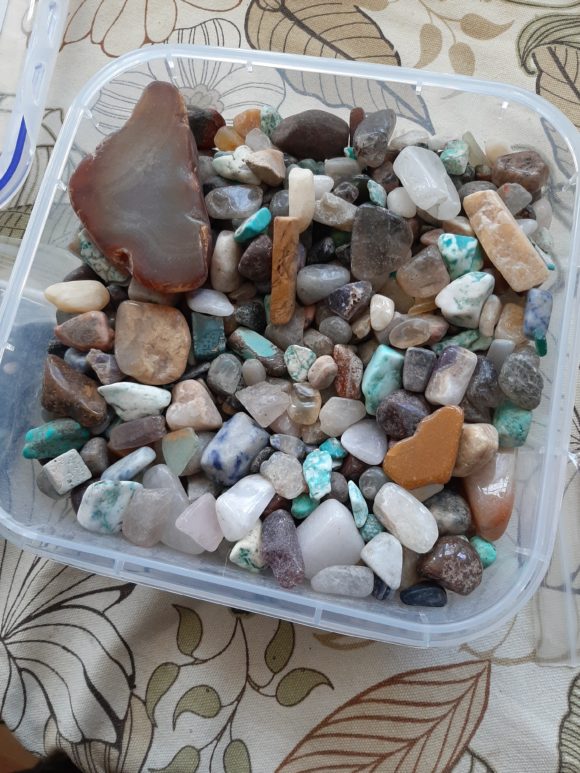
Stone Contents of Speedy Tumble Kit
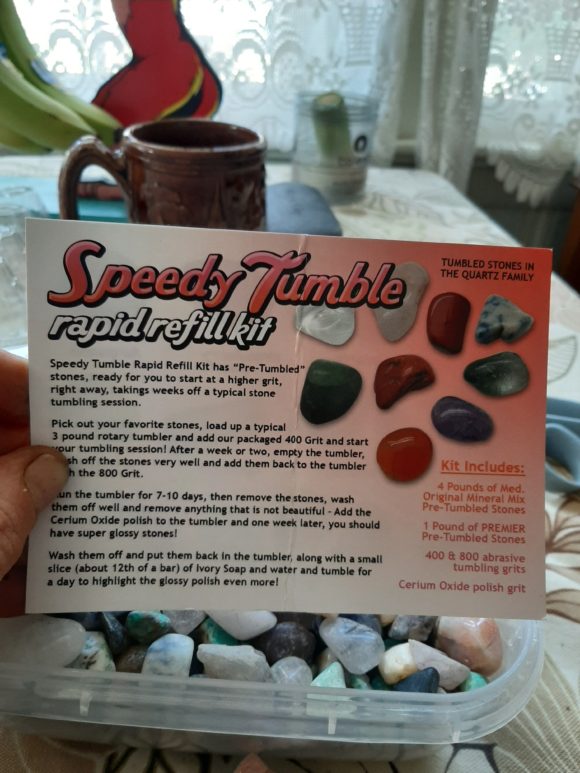
Instruction Card for Speedy Tumble Kit
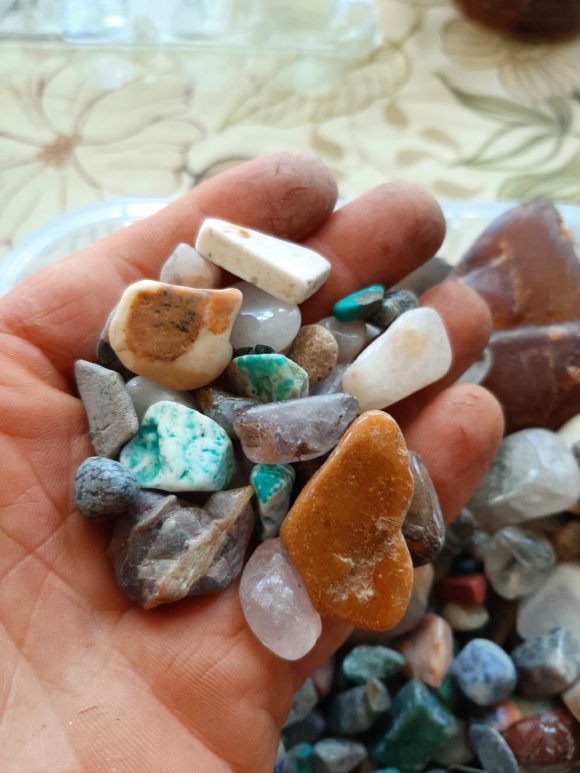
Handful of the stones in this Speedy Tumble Refil Kit
Notice the awesome container they give you as well as the colorful, high quality printed materials and instructions. This is a great looking set!!
To test Speedy Tumble, I decided to take the minimal amount of time it instructed to tumble for. So from start to finish, three weeks and one day total time. For my tumbler, I decided to use the most convenient option I could find. That meant I decided to take a trip down to my local Harbor Freight and purchase their Chicago Electric 3lb. rotary rock tumbler. It proved to be surprisingly well made, rigid, and perfect for getting the results I desired. Definitely a surprise.
I decided to leave some headspace in the tumbler barrel, and filled it about two thirds of the way with stones from the set that I lightly prewashed. It’s a bad idea to totally fill the barrel, so the stones can move freely and let the grit work them.
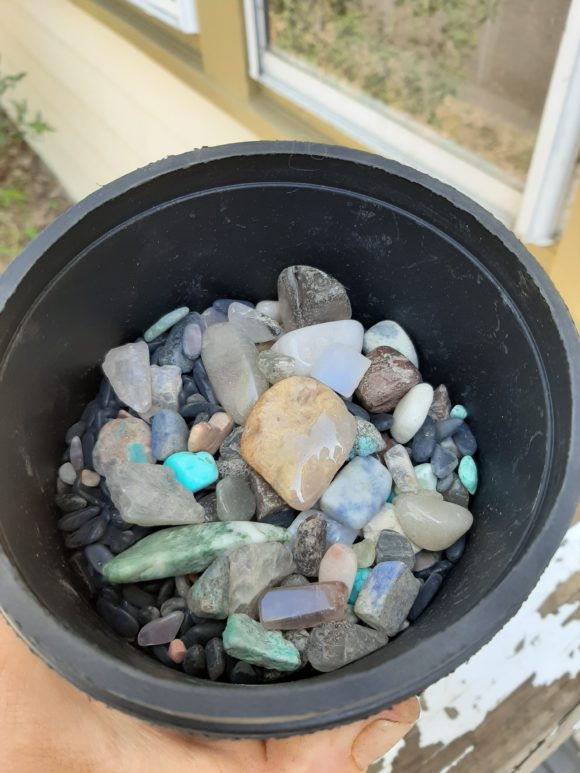
Rotary Tumbled Stone Barrel filled with pre-tumbled stones
I added about 3.5 tablespoons of 400 grit, added some water, sealed the drum, released pressure after 3 hours, then tumbled for one week uninterrupted.
One week later I opened the barrel, placed the rough in a strainer and carefully rinsed off the grit. The material is looking nicer!
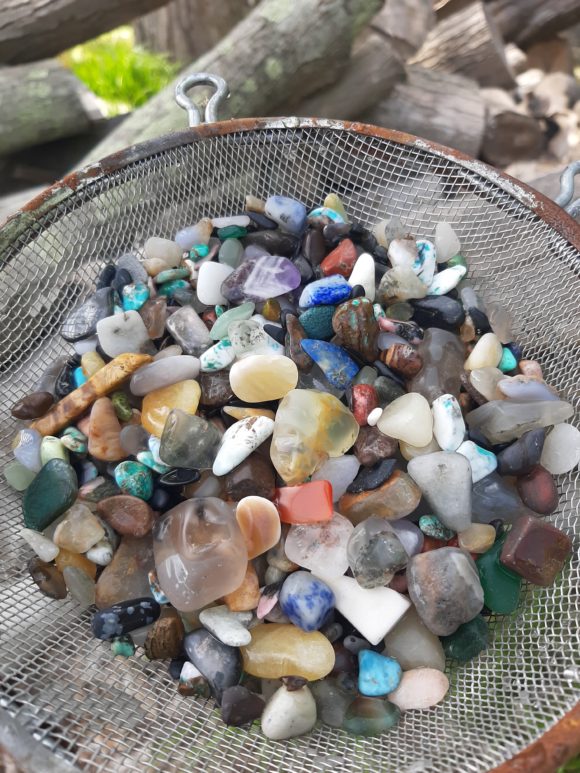
Strained and Cleaned of grit, the material is already looking much nicer!
Back into the tumbler with the 800 grit for a week. I repeated the same procedure as that for the 400 in terms of amounts.
Getting more tumbled! I washed this material well and then added about half the envelope of cerium oxide powder and more water.
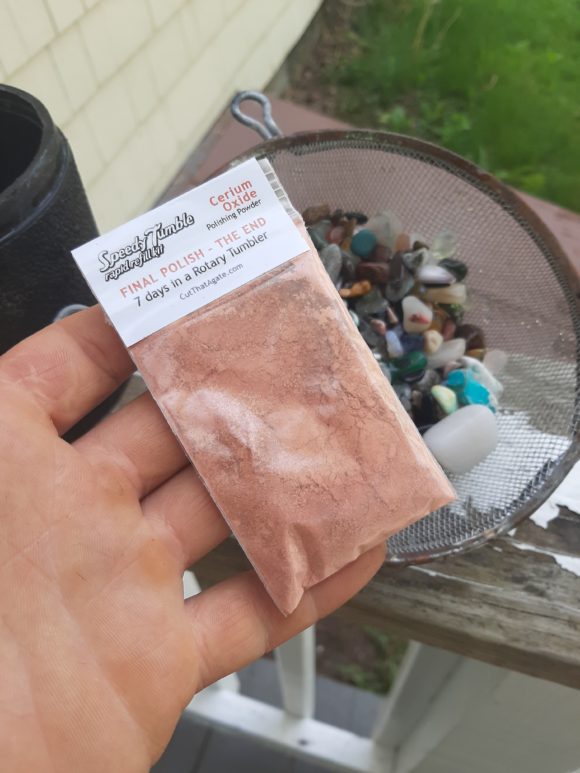
Bag of Cerium Oxide, a Very Fine Polishing Paste, for the final polish of the tumbled stones
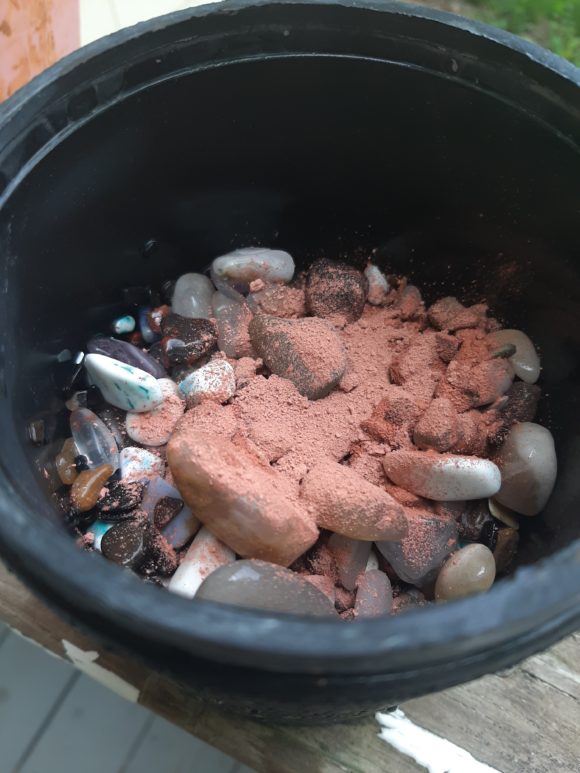
Cerium Oxide in the Rotary Tumbler Ready for Final Tumble.
After a week with cerium oxide, I washed the material well and added a small chunk of Ivory soap and tumbled with a little water to get a higher gloss. There you have it! It’s finished! Let’s take a look:
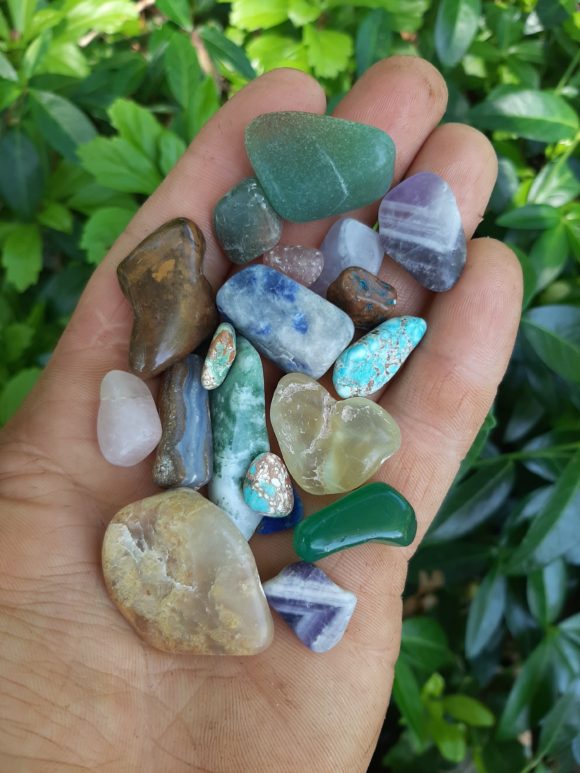
Tumbled Stones after Final Polish from the Speedy Tumble Rapid Refil Kit
Here is a handful of the beautifully glossy finished product. Ready to go for a craft project or just to enjoy!
Summary: Overall I really like Speedy Tumble and I think the value is amazing. Not only do they do the dirty work for you, but they include the grits you need to finish the job. You get a ton of material and the quality is great. I found many semiprecious stones in my assortment including amethyst, rutilated quartz, agate, sodalite, and turquoise. The only thing I can really criticize is I wish the premier material was something a little more colorful, but I can’t even really complain because of how well executed everything else was. Great job on making an interesting product for all ages, Speedy Tumble
PAID CONTENT – This Article is a paid review and contains links to Amazon to purchase the product.
Related posts:
The post Product Review: Cut That Agate- Speedy Tumble Rapid Refil Kit – Tumble Stone Polish Kit appeared first on Where to Find Rocks.
]]>The post Visit the Trilobyte Me! Quarry in Delta, Utah for a Gourmet Trilobite Buffet to Snack on! appeared first on Where to Find Rocks.
]]>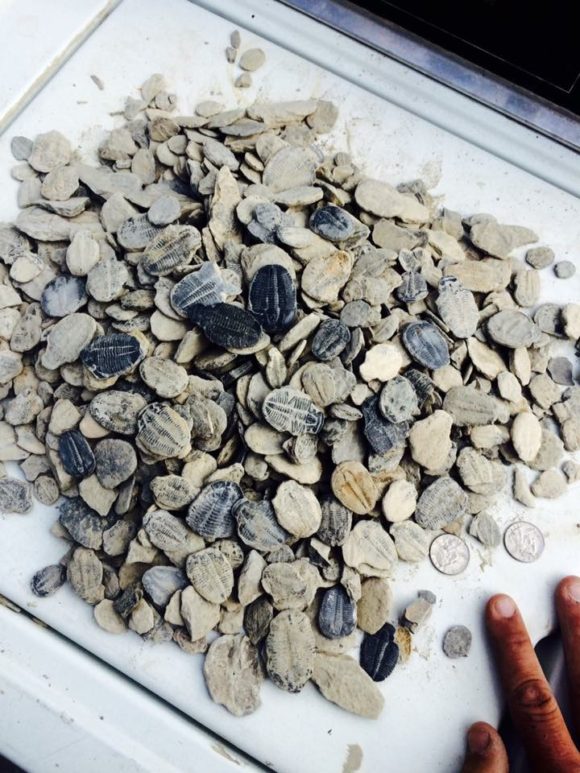
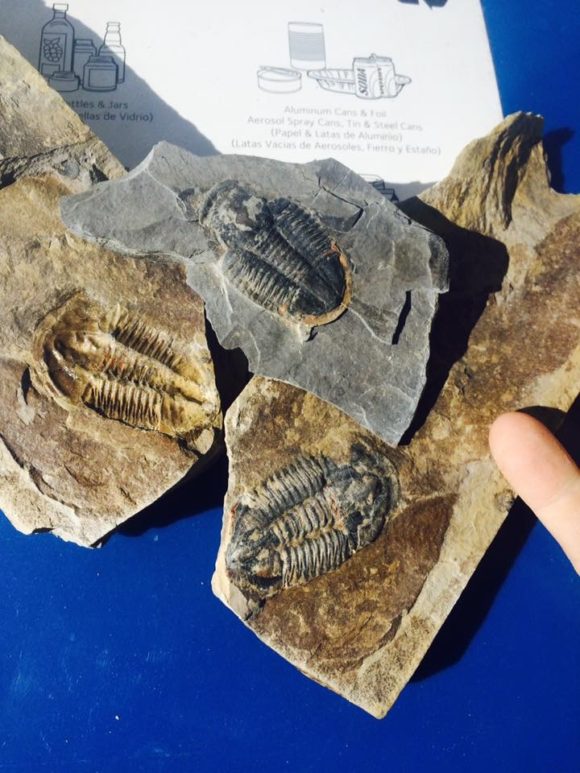
Photos from the mine operators. The operators state on their site that the pile represents approximately the finds from just two days of basic digging! The trilobite specimens in matrix show what you might find splitting rocks
What is a Trilobite?:
Trilobites are ancient arachnomorph (arachnid-like) class of arthropod invertebrates, meaning they are related to insects, crustaceans, and arachnids. Despite their crustacean like appearance, they are most closely related to spiders, horseshoe crabs, and scorpions. They were among the most diverse classes of life on earth during the lower paleozoic but many became extinct in the Devonian, and were all finally wiped out in the Permian mass extinction event.
Trilobites remain so well preserved in the fossil record because of their hard exoskeletons, which were easily replaced by calcite over time. They range in size and shape greatly from a few millimeters to about a foot long and are found in paleozoic rocks worldwide. Trilobites have large, prominent compound eyes and a pair of flexible, sometimes long antennae as well as many pairs of segmented legs for moving and feeding, similar to a pillbug. Some trilobites had elaborate spines, but those species are not often seen in the Wheeler Shale. Many species could even roll up in a ball for defense. Trilobites were mostly scavengers or sifted through the substrate for food, but there is some suggestion a few species were carnivorous. A great diversity of well preserved species is found in the Wheeler Shale, and the Trilobyte Me! Quarry is an extremely rich source.

The Trilobite body is divided into three main parts that can be thought of a head, torso, and tail. See the above figure, the head is called the cephalon (1) , the torso is the thorax (2) , and the tail is the pygidium (3). Lengthwise the body is divided into three lobes, the right pleural lobe (4), the axial lobe (5), and the left pleural lobe (6)

Some species of trilobites encountered in the Wheeler Shale. Source: https://u-digfossils.com/trilobites/
Geology and Paleontology:
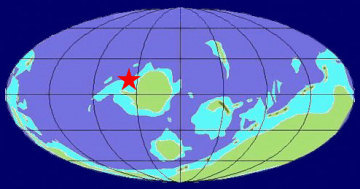
The approximate location of Utah in the early Cambrian period (~505MYA) Source: https://www.trilobites.info/Utah.htm
The Wheeler Shale of Western Utah dates back to the early Cambrian period, representing a period in which oceanic invertebrate life greatly diversified. This unit consists of mudstone, shaley limestone, and a platy limestone. Before the Cambrian, most vertebrates were soft bodied, poorly preserved as fossils, and difficult to classify. The Cambrian is the period where arthropods such as crustaceans and trilobites, cnidarians like jellyfish and corals, and brachiopods came into existence and started to thrive. During this time Utah was located along the equator and the Wheeler Shale is the bottom of a shallow, warm sea. Think of the water being similar to a tropical destination like the Caribbean. That is the type of climate these trilobites thrived in. Elrathia kingi is the commercial trilobite species most sought after by collectors. It is the iconic trilobite from this formation and is one of the most abundant. Elrathia kingi specimens are the most commonly encountered American trilobite on the market. However, there is variety at the Trilobyte Me! Quarry and about 15 genera of trilobite total exist in the Wheeler Shale.
Many unusual fossils including peculiar ancient crustaceans and soft bodied animals have been found in the Wheeler Shale. Some of these fossils are not easily noticeable but may be significant or important. If you see an unusual fossil, even if faint, keep it and try to get it identified. There have been many important fossils of soft bodied animals found in Utah. In addition many fossils of trilobite-like fossils have been found. These organisms are closely related, but not true trilobites.
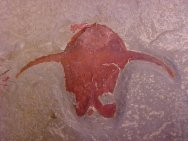
A fossil of a peculiar ancient crustacean from the Wheeler Shale- Pseudoarctolepis sharpi, a Phyllocarid. It is definitely important to look out for strange fossils at the Trilobyte Me! Quarry, you might find something rare and unusual. Source: http://www.fossilmuseum.net/Cambrian-Explosion/Utah-Cambrian-Explosion.htm
Collecting and Supplies:
To collect these trilobite fossils you will be splitting shale, which has a particular technique to it. Hit the shale in the direction it splits with a geologists pick or crack hammer and thin chisel. Use a sturdy tap, when this rock splits, it often happens all at once. For digging in the quarry, bring a prybar, pickaxe, and wedges to remove and split bigger pieces of shale. Also bring a screen to go through finer material, a bucket, gloves, and safety goggles. Bring plenty of food and water, sunscreen, and bug spray. From the High Desert Gems and Minerals website, several collecting options in different price ranges are available, but all give you the experience of digging tons of your own awesome quality trilobites!
Dig Gemstone Fossils
Open Daily April 1 – October 10th 9am – 5pm
No reservations required, just show up, any day!
Basic Trilobite Collecting
Split the shale or screen dirt for shale and find matrix specimens or loose jewelry grade trilobites.
Adults $50
8yrs-14yrs $35
7yrs/ under Free
Quarry Bank Digging
Dig and split shale using hand tools in the actual freshly exposed trilobite bearing shale layers of the quarry
Adults $100
8yrs-14yrs $50
7yrs/ under Free
E x c l u s i v e Digging Options…..
High-End Quarry Bank Digging
Our exclusive digging area reserved for our commercial trilobite operations.
Adults $200
11yrs-14yrs $100
10yrs/ under Free with paying adult
“Trilobite infested” Ore Pile
Our trilobite pay dirt shale dug up with our machinery and put in a pile for your convenience to sort.
$150/ pile
Price includes whole family
High-Grade “Trilobite Swarm” Ore Pile
Our exclusive commercial trilobite bearing shale dug up with our machinery and put in a pile for your convenience to sort.
$300/ pile
Price includes whole family
Directions: See Map
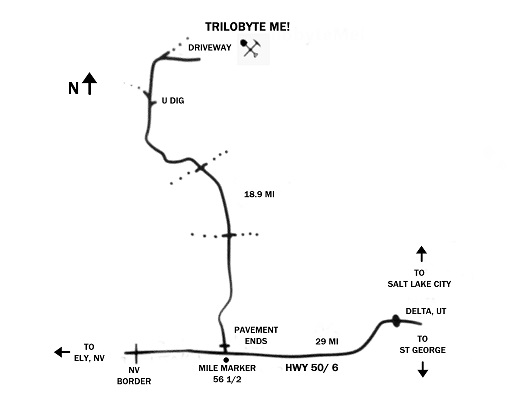
Driving Directions
From the West: use Hwy 50 in Nevada at the state line border drive 56 miles into Utah.
From the East : use Hwy 50/ 6 out of Delta, Utah drive West 29 miles.
On Hwy 50/ 6 at mile Marker 56 & 1/2 turn onto dirt road North (Known as Long Ridge Reservoir Road).
0.0 reset odometer at the U-Dig Fossils sign/ cattle guard.
4.9 drive over cattle guard.
6.3 drive over another cattle guard.
Slow down! for tight curves in road.
10.1 intersection for Margum Pass sign.
15.0 intersection for Swasey Spring sign.
Slow down! curvy road.
18.8 intersection for U-Dig and Death Canyon, stay on road as it bears right.
18.9 immediate right turn into driveway of Trilobyte Me! Quarry.
Parking: cars continue on through the gate, RVs and trailers park before gate!
Follow these directions! The internet may get you lost!
Accomodations: Free camping and RV accomodation on site! Pet friendly! Bring your own food and water. There are hotels near Delta, Utah also available. Rancher Motel (435) 864-274, Delta Inn Motel (435) 864-5318, Days Inn (435) 864-3882, Antelope Valley RV Park (800) 430-0022
Sources:
https://www.highdesertgemsandminerals.com/html/trilobyte_me_quarry.html
http://www.fossilmuseum.net/Cambrian-Explosion/Utah-Cambrian-Explosion.htm
https://www.trilobites.info/Utah.htm
Related posts:
The post Visit the Trilobyte Me! Quarry in Delta, Utah for a Gourmet Trilobite Buffet to Snack on! appeared first on Where to Find Rocks.
]]>The post Finding Your Own Green Pyromorphite and Orange Wulfenite in Western Massachusetts! appeared first on Where to Find Rocks.
]]>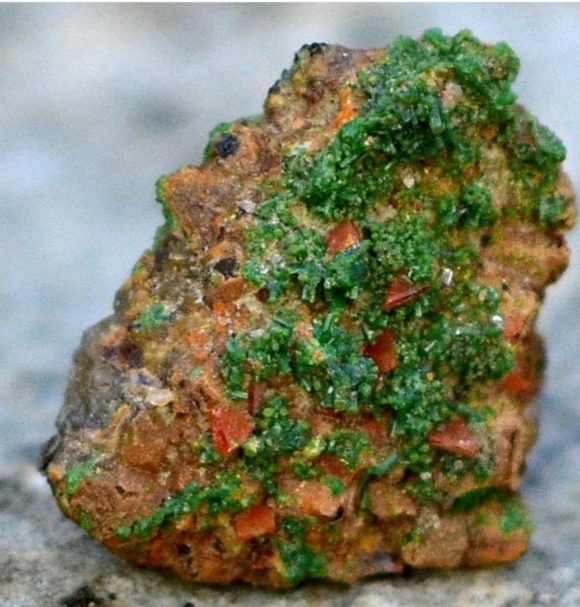
Beautiful combo of pyromorphite and wulfenite dug by my friend Alex Kim (@dirty_minerals on insta). Finding this piece is what inspired him to dig minerals. Check out more of his collecting adventures and amazing finds on his page!
History: The name “Loudville Lead mines” is used to refer to the many mines in a small district adjacent to the Manhan river in Northampton, Mass. Loudville is the name of a small village in the area on the Easthampton and Westhampton line that was the nearest settlement during mining activity (2). The Loudville Lead mines are some of the oldest colonial mines in the US. Discovered by Robert Dyer in the late 1670s (1), they experienced several periods of mining from the 17th through 19th century. The first phase was from discovery until the American Revolution, which halted operations. I have heard though I cannot confirm that lead from Loudville was used in Revolutionary munitions like musket and cannonballs. Ethan Allen, famous hero of the American Revolution worked Loudville in the late 1700s after giving up prospecting Mine Hill in Roxbury, CT for silver (3). This mine was worked intermittently throughout the 19th century, last in 1865.
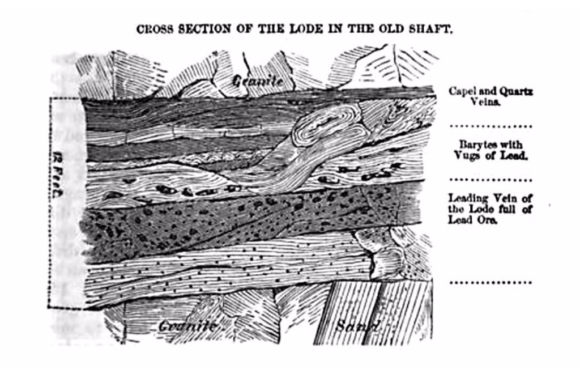
an early sketch of the geology of the lead ore vein at Loudville from
Richardson, Charles (1854): Northampton District. The Loudville Mine (Mining Magazine Vol. 2 pp 13-20.
Mineralogy: Pyromorphite and Wulfenite are the most sought after minerals at this location and often they are hard to see. When you find material that shows any hint of green or orange, save it and delicately clean it at home. Do not use chemicals on minerals from Loudville with the exception of quartz. Many of these minerals will react even with iron out.
Secondary, oxidized minerals like Wulfenite and Pyromorphite are extremely rare in New England. Many of the oxidized zones (called supergene zones) of metal deposits in the region were removed by glaciers leaving mostly just sulfides which generally are massive and not aesthetic at the majority of locations in the region. Finding just one pyromorphite or wulfenite crystal at a lead deposit almost anywhere else in New England is a very rare experience.
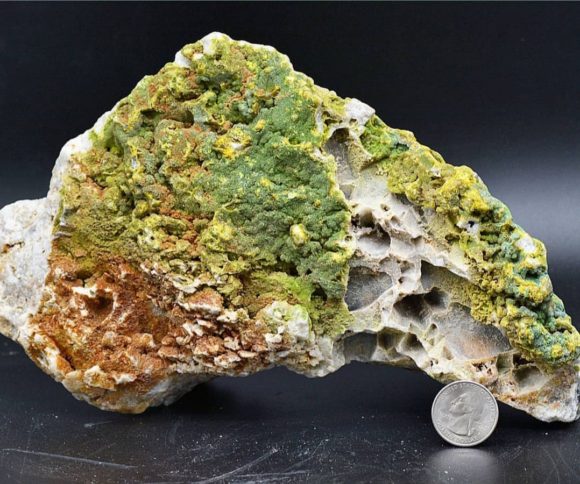
Gorgeous specimens of pyromorphite collected by my friend Dustin Bartlett (@themodernnaturalist on instagra,) Dustin has collected Loudville extensively and his page is a good place to go to see what collectors are still finding there!
Lead secondary minerals such as cerussite, anglesite, and the rare leadhillite are also found at Loudville. Cerussite is expecially common and overlooked. The best way to spot it is by its high luster and understanding its unique crystallography. Frequently it exhibits twinning. Even though it is colorless, its appearance makes it immediately distinguishable from quartz and baryte- the two other colorless minerals here. The author has collected numerous fine cerussites at Loudville to nearly 2cm long.
Quartz is another very common mineral at Loudville that can be very pretty. Beautiful clusters of milky, smoky, amethystine, and combos of these three varieties of quartz can be found, crystals getting quite large! Many of the similar lead mines in the Northeast such as the closed to collecting Canton Lead Mine in Ct are known for colorful amethyst and smokies with lead secondaries. At Loudville, you will often find other minerals, especially pyromorphite and wulfenite coating the quartz.
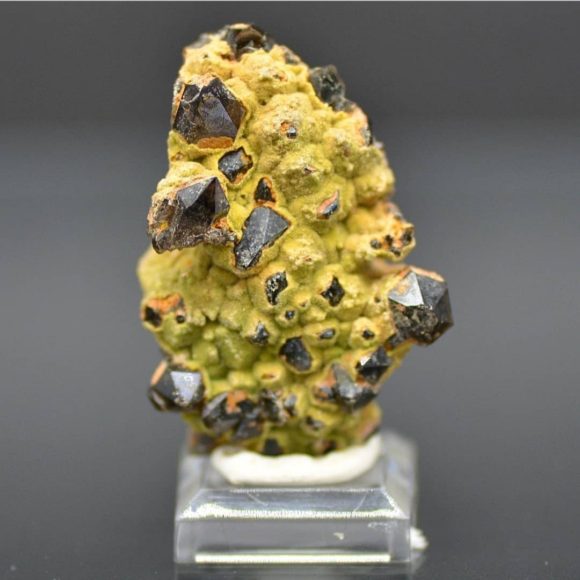
Beautiful combo of pyromorphite on dark smoky quartz dug by Dustin Bartlett @themodernnaturalist on insta
The list of minerals at Loudville is extremely extensive and represents so many interesting combinations of lead, zinc, copper, sulfate, carbonate, silicate, etc. Under the microscope, a whole world of collectible material becomes available. Please see Mindat if you want to learn more: https://www.mindat.org/loc-3832.html
Directions and Equipment:
When digging here, please respect the boundaries to the collecting area! There has been a lot of digging outside of it and if it continues, the site may be closed within the next few years. Saying that, there are many strategies to collecting there, I will discuss two of them.
The first strategy involves digging into the dump and breaking rock to expose vugs. Use a shovel, hand rake, etc to turn over the dump and a crack hammer and chisel to break the material. The river is a convenient source of water to wash pieces off you can’t see clearly. Often the mud can obscure the crystals. Move slow and be careful.
An especially interesting technique people have been successful with here is panning for wulfenite in the river using a gold pan. Wulfenite is very dense compared to other minerals and will readily separate out in your concentrate. Use tweezers to pluck them out and I strongly advise you put them into a vial of water since they are fragile and very easy to lose.
In addition to the tools I outline above, other things you will want to bring is food, water, bug spray (it gets bad in the summer), sunscreen, and waterproof footware. This is a great place to bring dogs as many of them love swimming in the river. Just keep them on leash and be respectful to other dog owners.
To get to the site, it is very simple. Navigate to the pin on the embedded map and look for a small parking area. Park there and make your way down to the edge of the river. The collecting areas are clearly marked.
Article By Jeremy Zolan
Sources:
https://www.mindat.org/loc-3832.html
(1) Trumbull, James R. (1898): History of Northampton Massachusetts from its Settlement in 1654, Gazette Printing Company, Northampton Massachusetts: 358-368.
(2) Robinson, G.R. Jr., and Woodruff, L.G. (1988): Characteristics of Base-metal and Barite Vein Deposits associated with Rift Basins, with Examples from some Early Mesozoic Basins of Eastern North America, in Studies of Early Mesozoic Basins of the Eastern US, Frolich, T.J. and Robinson, G.R. Jr., Editors, USGS Bulletin 1776: 377-390.
(3) Hall, Henry (1895). Ethan Allen: the Robin Hood of Vermont, Appleton and Company, New York.
Related posts:
The post Finding Your Own Green Pyromorphite and Orange Wulfenite in Western Massachusetts! appeared first on Where to Find Rocks.
]]>The post Green Stuff in Vermont! Colorful Chrysoprase Agate appeared first on Where to Find Rocks.
]]>by Jeremy Zolan
Outcrops around the town of Newfane have long been known for interesting samples of bright green chalcedony colored by nickel. This popular and beautiful semiprecious stone is known as chrysoprase. The majority of chrysoprase is mined from commercial lapidary rough mines in Australia, but fine examples of the material are also known from Poland, Albania, Kazakhstan, Tanzania, and Oregon. It is a relatively rare stone worldwide so having an opportunity to find it is certainly unique. In addition to chrysoprase, a variety of other beautiful material can be obtained at this site such as jasper, serpentine, and small quartz crystals. The rare hydrated nickel silicate garnierite has also been found here.
Chrysoprase forms from oxidized nickel impurities imparting a green color to the material. The source of this nickel is from rocks geologists call ultramafic. These ultramafic rocks were metamorphosed to form the serpentinite at the deposit. These rocks are from very deep in the earth and have a chemistry that differs quite a bit from other igneous rocks. Often these ultramafic rocks are very rich in magnesium, calcium, and iron. They are also frequently poor in silica and rich in elements like chromium and nickel. When these rocks are exposed to water as well as a tiny amount of heat ad pressure, they break down and form serpentinite. The metals leach into silica and other minerals giving them their color.
Collecting-
Most of the collecting at this site will be done in the stream, stream banks, or riverside outcrops. Collecting involves getting into the stream bank and flipping over rocks. You might want to bring a shovel or hand rake to remove material from the stream bottom. Inspect material carefully for anything interesting and keep an eye out for anything with a bright green color. Place anything you want to keep in a sturdy bucket. Heavy waterproof boots or waders are a must in colder months. When it’s warmer wear some waterproof shoes to protect your feet from the rough bottom. Bring a hammer and chisel in care you want to break open anything you find to inspect it further.
Directions-
Navigate to South Newfane and look for a bridge that crosses Adam’s Brook. It should be very close to the center of the small town. Find a safe place to park and enter the brook. Search material in the brook for minerals. There are serpentine boulders present. Nearby there are several outcrops near roadcuts along the brook that can also be dug for similar material. Always keep an eye out for a bright flash of green color.
Related posts:
The post Green Stuff in Vermont! Colorful Chrysoprase Agate appeared first on Where to Find Rocks.
]]>The post Rockhounding in the Time of a Global Pandemic appeared first on Where to Find Rocks.
]]>How You can Engage your Interest in the Times of COVID-19
by Jeremy Zolan
None of us expected to be hit with a pandemic disease in 2020 and it is undoubtedly changing many aspects of every day life. Taking precautions to slow the spread of the virus unfortunately has caused the cancellation of many of the spring and summer mineral shows that we all eagerly await. Local club meetings and field trips may also be canceled so hobbyists may get discouraged to field collect. The hobby can still be engaged in a fun way, and you can still get out and dig too. It is very important to take the new coronavirus seriously and pay attention to cleanliness, health, and social distancing. Going out rockhounding can definitely give you a healthy workout, and you’ll usually be very socially distant.
Engaging Your Club and Other Diggers-
While meetings and club shows are canceled for the time being, it’s critical that you stay engaged with your fellow members and other collectors, ensuring the health of your mineral club until you can meet again. While you are required to stay physically distant, you can still maintain a strong presence through electronic resources.
The internet, obviously is great for this. It might be a good idea if you haven’t already, to create a Facebook group for your club. After you create the group, you need to request other members to join and nurture the page with posts so it grows. Post your recent findings, something you just cut and polished, or a favorite specimen. Share your passion. It is still possible to trade material too. Make sure to pack it in a box with clean hands to mail it long distance or maybe just drop things off on your fellow club members and local friends’ doorstep so you don’t physically engage them.
There are so many online resources for collectors. It’s very easy these days to see hundreds of mineral related pictures a day through social media. Personally, I love the picture based format of Instagram. Lots of diggers are very active there, posting pictures of their findings. It is easy to get engaged in that community. Use hashtags describing the mineral you are posting, relating to appearance, species, locality, etc. Facebook, again is good too. The majority of people in the US have a Facebook and there are many regional groups, etc. It is a good place to reach out to people to discuss mineral topics.

Educating Yourself and Kids-
Mindat.org is a mineral database cataloging thousands of different minerals and possibly close to one million localities. It is a great place to learn about minerals you are unfamiliar with, or research new spots to dig. There is also a messageboard where you can discuss mineral related subjects from the most basic to graduate level academic topics. Mindat is the website that got me into minerals as a child. If your kids are into science or nature, explore the site with them and learn about your regional minerals.
Nothing beats a book either, and now many of us have plenty of time to read since it is harder to go out. While libraries are closed, plenty of books are available on Amazon and Ebay, as well as from mineral dealers, etc. Many new instructional guides on lapidary topics are excellent, there are gorgeous picture books of fine specimens, and superb field guides too. If you are an ardent field collector, old guides are available from time to time online. It’s a good time to rediscover that elusive lost locality!
Buying and Selling Minerals-
All of our favorite shows are canceled and it is a big disappointment to buyers and sellers alike. Again, we all should turn to the internet to get our mineral fix! There is so much available on private dealer websites, Instagram, Facebook, Ebay, Etsy, and even Amazon. It’s a great time to support a local miner too. Buy crystals and lapidary rough you see directly from the people who mine them! Not only will you get something unique and exclusive to add to your collection, but you’ll ensure the miner themselves continues to be productive and successful at saving crystals! May assortments, kits, and sets of minerals are available too, which are perfect for teaching a kid who is home from school about earth science with a hands on approach.
Buying and selling minerals through live feed on Facebook simulates at least some of the appeal of a mineral show and allows customers and dealers to engage in real time. It’s a great way to be able to discuss specimens and sell quickly if viewers can be attracted. A good camera is very important as well as a kind, gentle, informative speaking manner when engaging customers.
Field Collecting-
Digging your own specimens is a healthy activity and the best way to learn about how minerals occur in the wild! Due to COVID-19, I am insistent that you only collect solo or with people you live with. Social digging will have to wait. Fee dig sites are mostly closed as well. There are still ways to dig and say socially distant but you will need to take precautions. Explore sites from guides on or available through wheretofindrocks.com and also old publications and dated websites for some neat sleeper locations far off in nature. Always carry a phone on you when you are alone in case you get injured or need help. Be extra careful these days, as going to a doctor or hospital puts you in extremely close proximity to the virus. Eat well and get hydrated before you dig so you do not compromise your immune system. Don’t dig or hike too hard to avoid injury. Wear gloves and eye protection too. Be very very careful. I personally have dealt with a collecting injury that required going to the hospital and it was no fun. The best advice I can give you is MOVE SLOW!
As COVID-19 continues to spread and the situation gets more intense, it affects our every day lives more and more. Instead of focusing on the privileges we have lost, focus on those we still have. Don’t make fun your priority and go out to rockhound until you’re exhausted. Moderate it and prioritize health. Rest a lot. Take care of your body like you would your best specimens.
Related posts:
The post Rockhounding in the Time of a Global Pandemic appeared first on Where to Find Rocks.
]]>The post Prospecting for Quartz in New York State – Ellenville Quartz Mine and Beyond appeared first on Where to Find Rocks.
]]>By Jeremy Zolan
New York is a state with an abundance of quartz localities. These locations produce crystals of a huge
array of styles from many diverse geologies. While most famous for beautiful Herkimer diamonds from
the Mohawk river valley, there are many other kinds of deposits found within the woods of New York.
This brief guide will highlight some things to look for when out in the field and what tools may be
useful. There is a lot in NY state that may be overlooked!
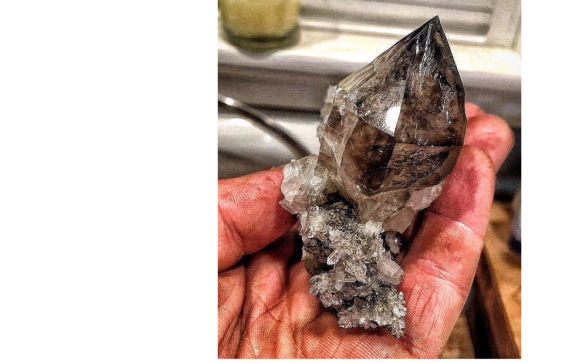
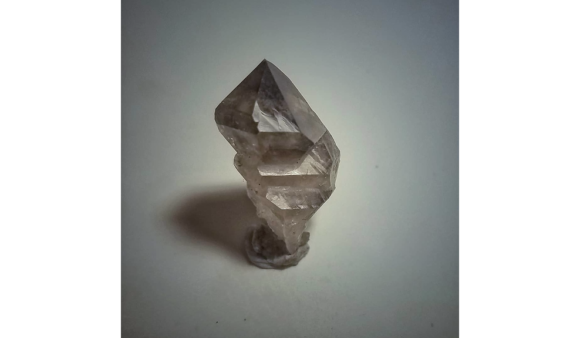
Two beautiful smoky quartz crystals the author found in the Hudson Valley. The author used
the techniques and tools in this article to find and collect these beautiful quartzes
Most of the quartz deposits in NY differ considerably from the deposits in the Herkimer area, which are
the most well known. While the Herkimer “Diamond” deposits focus on a sea of isolated pockets that occupy layers in the host dolostone,
most of the other localities in New York work vein deposits. These veins often appear as white quartz
that shoots through the rock, twisting and turning in various lengths, rather different than the deposits the Herkimer Quartz is found.
Often there is a higher probability of finding crystals where you see these
veins intersecting because more space is available for growth at the meeting point. It is important to
take note of the geology in the area where you are to search. Often if you see faulting or contacting,
there can be movement of fluid that can produce crystals. As for contacting, notice that the richest
quartz deposits often form where two different rock types touch, for example sedimentary and igneous
or sedimentary and metamorphic. There is chemical exchange between the rocks which promotes
crystal growth. Getting familiar with some basic geology really does help. Here is a photo below of a
textbook example of a contact in NY of sedimetary rock with the metamorphic basement. If you see
veins originating at this junction of rock, there is a higher chance they will have interesting minerals or
nice pockets.
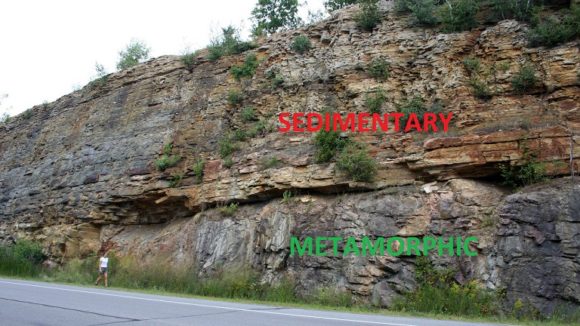
A contact between sedimentary and metamorphic rock in New York
Original Image Source: By Michael C. Rygel – Own work, CC BY-SA 3.0,
https://commons.wikimedia.org/w/index.php?curid=29021804
Lets say you have found an interesting vein and are looking to assess it and its potential for specimens.
If you see a hole in the rock, it is in your best interest just to take a look.
It is important to look for pockets containing crystals, or loose material that may have fallen out of a pocket into the talus below.
If you see any mud coming from the veins, especially if it is a reddish or orange color, check it out it as that may
contain crystals! Sometimes pockets can be just filled with dirt or totally clean too.
There is a bit of a list of what tools you will need to prospect and dig quartz in NY. Preparation is
critical. Keep in mind that you will often be looking in rural areas where there will be little or no
service, and having a GPS is often essential. I personally use a Garmin GPSMap 64st which is great,
but if you wish to have birdseye satellite imagery available to you, the Garmin GPSMap 66 series will
make all your wildest GPS dreams come true.
As for the tools you need, I notice that I pack very differently when I am going to prospect versus when
I am going to dig somewhere I already know about. Talking to my good NY prospector friend Dustin
Bartlett (@themodernnaturalist on instagram) we have made some lists of supplies you can buy easily
to get started.
Prospecting Pack:
The goal of the prospecting pack is mobility and sample collection. Use a small backpack you don't
mind getting dirty for this. Remember to pack ample water and supplies as you may be in the woods for
hours looking. The focus of your tooling should be light and versatile. Choose tools that are good for a
variety of environments. Here are the tools I would choose for this-
Available on Amazon:
Estwing B3-3LB Crack Hammer 3-Pound
Stanley 16-332 FatMax Cold Chisel with Bi-Material Hand Guard
Stanley FMHT16556 FATMAX Flat Utility Chisel, 1-1/4"
Estwing Gad Pry Bar – 18" Forged Geological Tool with Pointed Tip & Chisel End – GP-18
Estwing Handy Bar Nail Puller – 15" Pry Bar with Wide, Thin Blade & Forged Steel Construction – HB-15
Sahara Sailor Survival Shovel, Unbreakable Tactical Shovel-180 Degree Folding Shovel (or similar)
Also:
A chopstick for removing crystals from pockets undamaged
Wrapping Material
Water and Food
Notebook and Camera
I really think these lists should give you what you need to prospect and mine nearly any kind of quartz
deposit in NY other than the Herkimer deposits. You'll find that there will be cases where you might
have to use other tools and leave some of these home. Be creative! You will have to be adaptable and
try different things for different locations. Go out there, get dirty, and hit pockets!
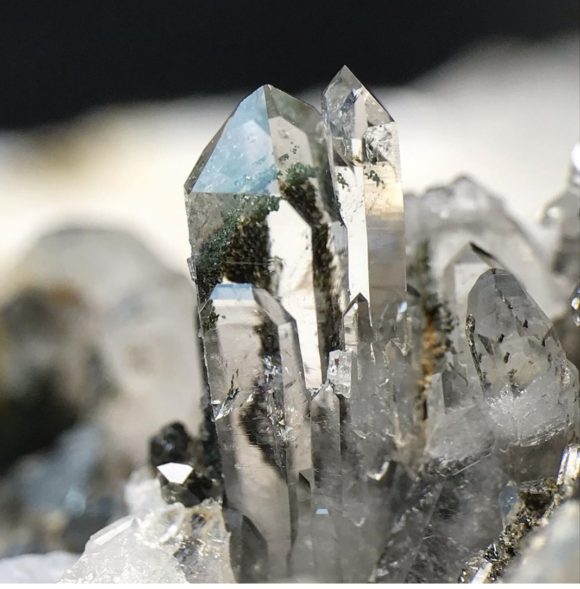
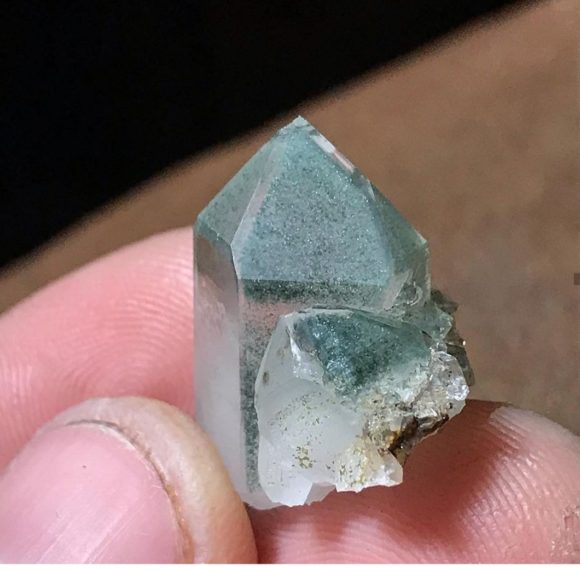
Gorgeous chlorite included quartz Dustin Bartlett (@themodernnaturalist on insta) dug from
his Lil' Give prospect on the Mass/NY line. Dustin discovered this brand new prospect and mined it
using the techniques and tools discussed above.
Locality:
Ellenville Quartz Mine, Ellenville, Ulster County, NY
To showcase one of New Yorks’ MANY quartz locations, we are showing you the Ellenville Quartz deposits. Once mined for iron and copper ore, this location has produced tons and tons of fine quartz crystals that form in quartz fissures.
This old mine has produced many specimens of quartz and pyrite over the years and there is still great
material there to be found. I recommend you park at Berme Road Park and walk to the mine, where the
red pin is. On the back wall you'll find pyrite and quartz crystals. Sometimes you can also find other
minerals like galena and sphalerite.
Related posts:
The post Prospecting for Quartz in New York State – Ellenville Quartz Mine and Beyond appeared first on Where to Find Rocks.
]]>The post Limited Edition “Miner Threat” Shirt – Out of Step! appeared first on Where to Find Rocks.
]]>This shirt is a limited edition made exclusively for the Tucson Gem Show 2020 –
A Tribute to the LEGENDARY Punk Rock album “Out of Step” by Minor Threat – a tribute to not following the herd, to doing your own thing. Instead of a herd of sheep and one crayon drawn black sheep, we have a herd of clear quartz and the one smoky quartz making its own way – Out of Step!
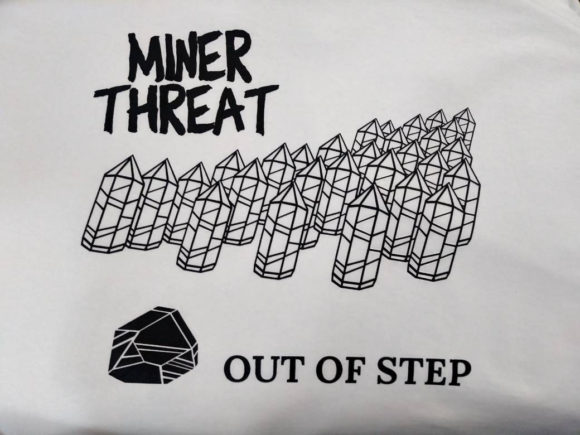
We have a small amount of these shirts available – 18.99 plus 1.50 for shipping in the USA –
Canadian orders, contact us at FortySevenPress@gmail.com before 2/12/2020 and we can get it to Canada for shipping.
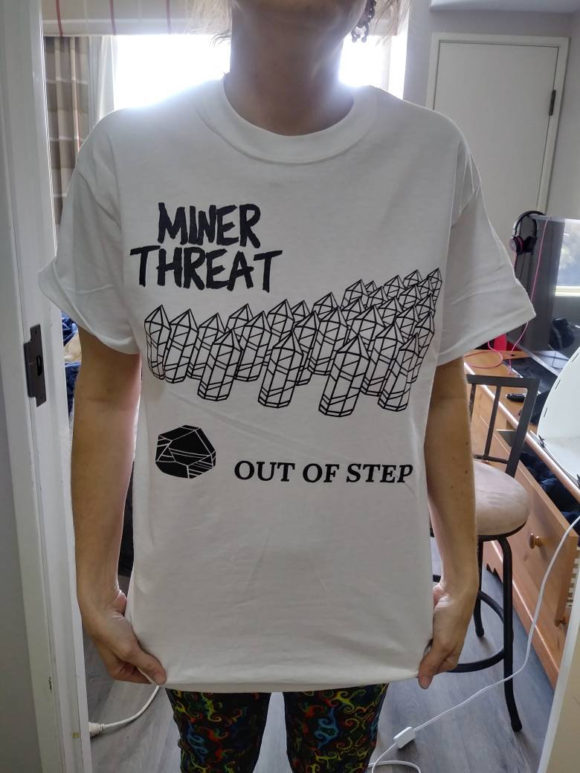
Related posts:
The post Limited Edition “Miner Threat” Shirt – Out of Step! appeared first on Where to Find Rocks.
]]>The post Pecos Valley Diamonds: the Desert is Paved with Diamonds appeared first on Where to Find Rocks.
]]>Like many other colloquial mineral monikers (another well-known example is “Herkimer diamonds”), these “diamonds” are not diamonds at all, but quartz crystals. The glint of reflected sunlight off the faces of these quartz crystals can give the barren desert the appearance of being “paved with diamonds” (Albright and Bauer 1955).
Article and Photos by Phil Simmons and Erin Delventhal at Enchanted Minerals LLC – enchantedmineralsLLC@gmail.com
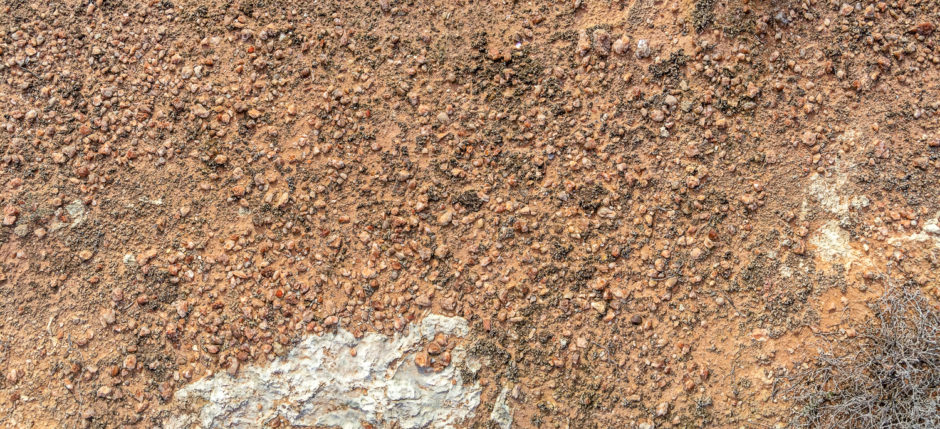
Outcrops of Pecos Valley Diamonds are often densely concentrated. Each “pebble” in this image is a quartz crystal, most measuring ~1-2cm. Many crystals are broken. Field of view is approximately 1 meter. ©Enchanted Minerals LLC
Pecos Valley Diamonds are found in the southeastern region of New Mexico, exposed in dispersed outcrops that span 100 miles long by as much as 25 miles wide. Though the area where outcrops are found is expansive, Pecos Valley Diamonds are limited to a very specific geologic unit: the Seven Rivers Formation, a back-reef segment of the Guadalupe reef sequence. The crystals are authigenic, meaning they have formed in place with no transportation via water or wind, though they often have weathered out of the much softer massive gypsum host rock. Though authigenic quartz crystals are known in ancient shallow marine carbonate and evaporite series across the world, Pecos Valley Diamonds are of note for their variety of colors and forms and for their impressive size (up to ~12cm, though more often ~2-3cm) for this type of deposit.
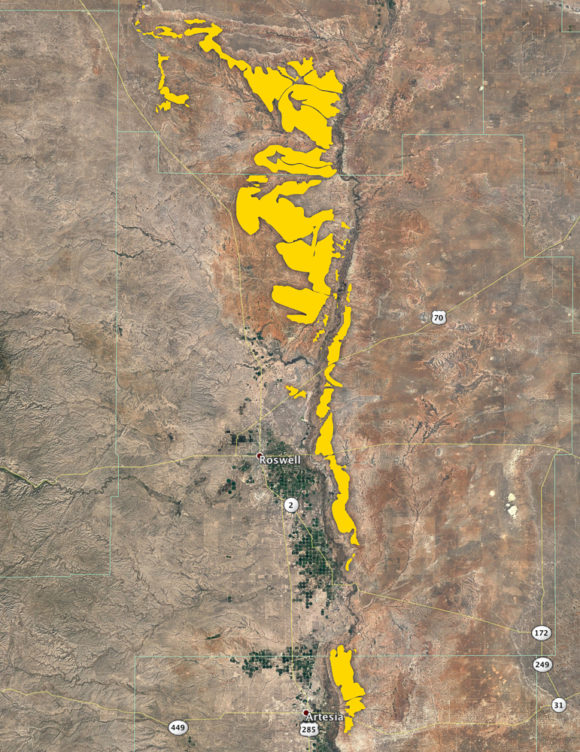
Surface outcrops of the Seven Rivers Formation (highlighted in yellow) in Southeastern New Mexico. Modified from Albright and Lueth 2003. ©Enchanted Minerals LLC
Habits and Variations of Crystals
One of the most appealing aspects of Pecos Valley Diamonds is the immense variety. They occur as doubly terminated crystals (less often in radial groupings) in a multitude of colors ranging from reds, oranges, and yellows, to whites, blacks, browns, and sometimes even hues of purples, pinks, and greens, and a variety of habits including prismatic, quartzoid, pseudocubic, and pseudotrigonal.
Coloration
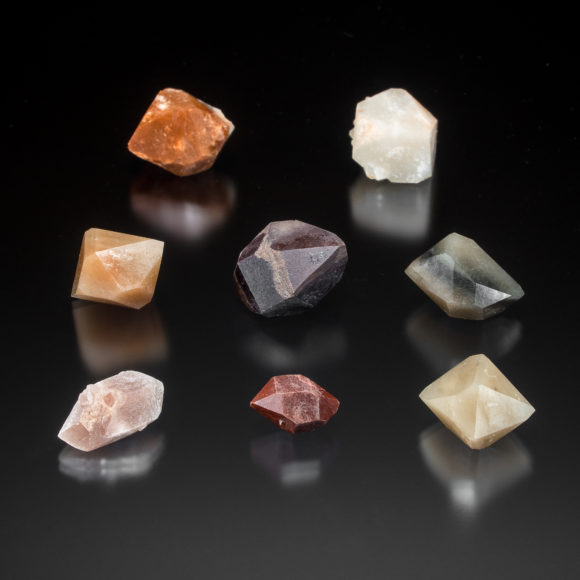
A grouping of Pecos Valley Diamonds showing some of the range of coloration in the quartz crystals. Center crystal is 2.5cm. ©Enchanted Minerals LLC
The wide variety of colors in Pecos Valley Diamonds has not yet been fully explored. Observational evidence indicates the coloration is largely due to inclusions: Pecos Valley Diamonds found still embedded in the host rock take on the color of the gypsum, even to the point of preserving the color banding found along laminations or fracture joints (Tarr and Lonsdale 1929).
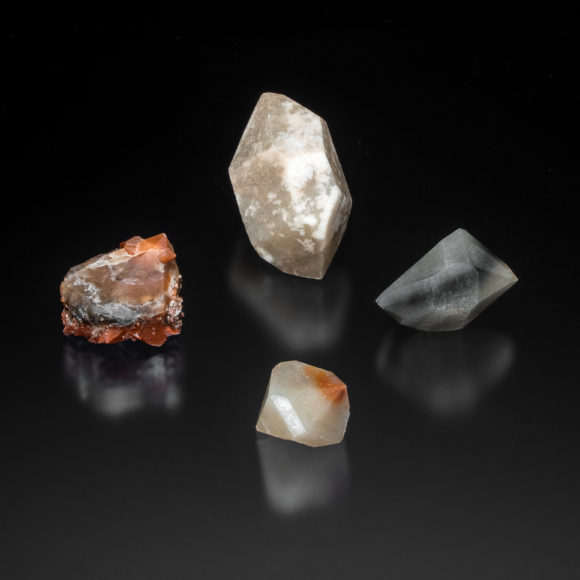
Crystals displaying color variations within individual crystals. Top crystal is 3.5cm. ©Enchanted Minerals LLC
The geological setting (see Geology below) of these crystals allows for the transition between gypsum and anhydrite, and zonal inclusions of anhydrite rather than gypsum have been reported (Nissenbaum 1967). However, the exact nature of those inclusions is still somewhat enigmatic: early reports refer to “ferruginous” (iron-rich) quartz or hematite inclusions in quartz, but analysis of similar quartz crystals from Spain indicate the red coloration is due to clay inclusions rather than hematite (Gil Marco 2013). Nearby occurrences of aragonite crystals also show coloration determined by inclusions of clay. Additionally, some coloration is suspected to be related to hydrocarbon inclusions (Albright and Lueth 2003). Of further interest, many of the quartz crystals are fluorescent, though the source of that phenomenon has not been explored.
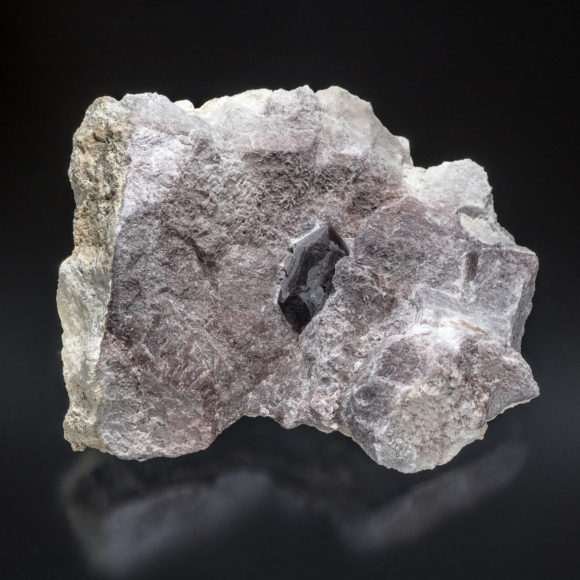
A Pecos Valley Diamond embedded in the host rock of massive gypsum. These crystals appear to take the color of the surrounding gypsum, though the crystals tend to universally be darker. Specimen is 15.2cm across; crystal length is 3.4cm. ©Enchanted Minerals LLC
Prismatic Habits
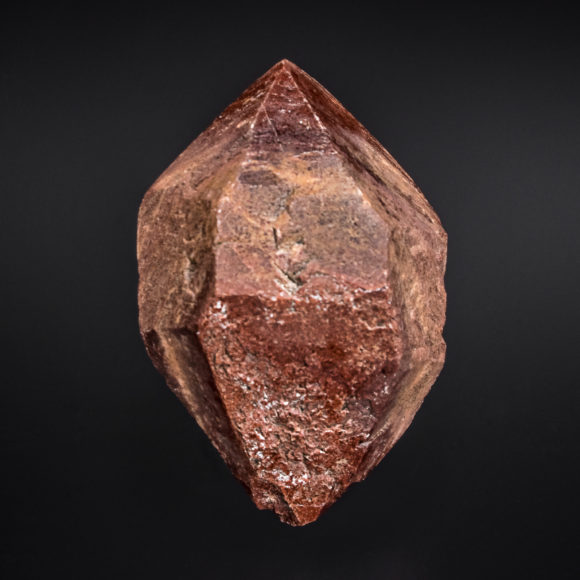
An example of a fairly “typical” Pecos Valley Diamond – a doubly terminated prismatic crystal. The red coloration is also fairly common. Crystal is 5.9cm. ©Enchanted Minerals LLC
The predominant habit found is single doubly terminated prismatic crystals with the regular m prism topped by hexagonal pyramids of equal or near equal r and z rhombs. This habit of quartz is common all over the world, although the majority of crystals worldwide are not doubly terminated. This habit tends to have the most color variations of Pecos Valley Diamonds. Elongated crystals are more rare than short, stubby crystals, though they can be found in several known locations.
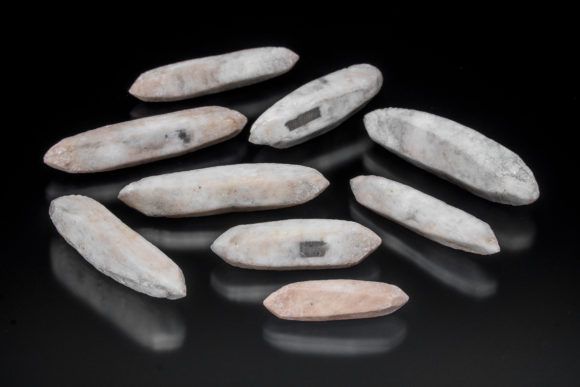
Elongated prismatic crystals are unusual in Pecos Valley Diamonds. Longest crystal is 5.5cm. ©Enchanted Minerals LLC
Equant Habits
Though Pecos Valley Diamonds are most often found as prismatic crystals, the variety of equant (length, width, and depth are roughly equal) habits of quartz are of particular note.
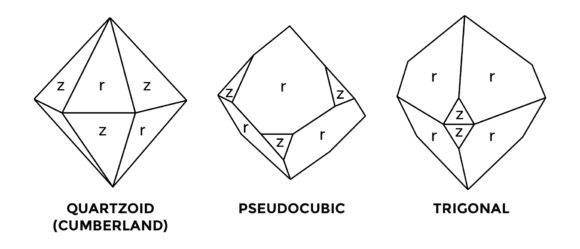
Crystal diagrams of equant forms found in Pecos Diamonds. Modified from Albright and Lueth 2003. ©Enchanted Minerals LLC
Crystals that display equal or near equal r and z rhombs, but significantly lacking m faces display a quartzoid, or Cumberland, habit. This habit is often erroneously referred to as beta-quartz, which is a high-temperature polymorph of SiO2 that is unstable at room temperatures. The presence of this habit in the low-temperature environments of Pecos Valley Diamonds indicates that the quartzoid habit is not tied exclusively to high temperature deposition.
Two unusual equant habits in worldwide deposits are relatively common in Pecos Valley Diamonds: the pseudocubic habit and the trigonal habit. Both are described by dominant development of r-faces with minimal z-faces and next to no presence of m–faces, though the latter two forms are never completely absent. The pseudocube and the trigon can be differentiated crystallographically by the orientation of z-faces: the pseudocube features alternating r– and z– faces across the a-axis, while the trigonal form shows r– and z– faces mirrored across the a-axis (see crystal diagrams above).
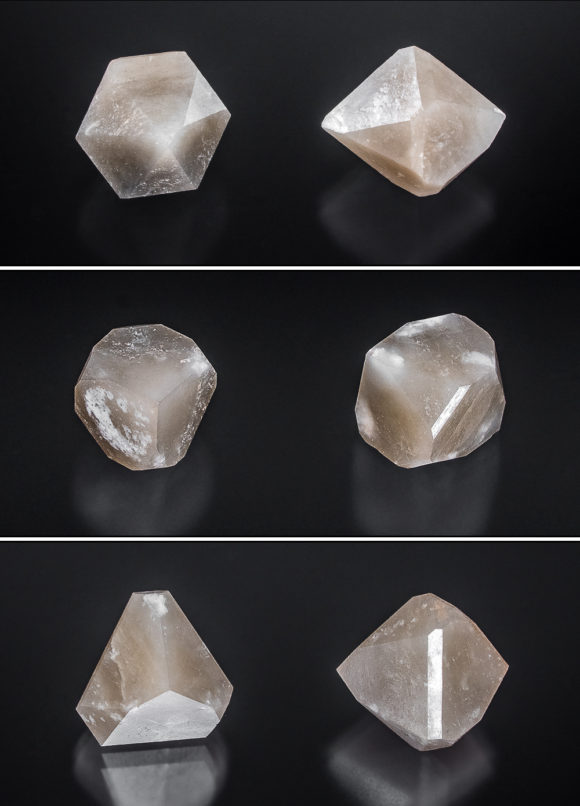
Comparison of equant forms with the left-hand side viewing the crystals down the c-axis and the right-hand side viewing roughly perpendicular to the c-axis. Top: quartzoid (Cumberland) habit; Middle: pseudocubic habit; Bottom: trigonal habit. Largest crystal is 2.1cm. ©Enchanted Minerals LLC
Pecos Valley Diamond pseudocubic crystals are of particular note: while the pseudocubic habit is very unusual worldwide, Pecos Valley Diamonds boast an unusually high percentage of crystals in this habit and crystals can reach sizes in excess of 5cm. Given the tendency for crystals to be fully formed and doubly terminated, coupled with availability, it can be argued that Pecos Valley Diamonds are the world’s best source for pseudocubic quartz.

Various orientations of the pseudocubic form in Pecos Valley Diamonds. Left-hand crystal is 2.5cm; largest crystal in center grouping is 2.7cm; right-hand crystal is 1.5cm. ©Enchanted Minerals LLC
Other Features
Pecos Diamonds often display different lusters on different quartz faces. This is typically found in lustrous terminations (r– and z– faces) and dulled, or pitted, m-faces. Luster can also vary between r– and z– faces, creating alternating finishes on terminations.
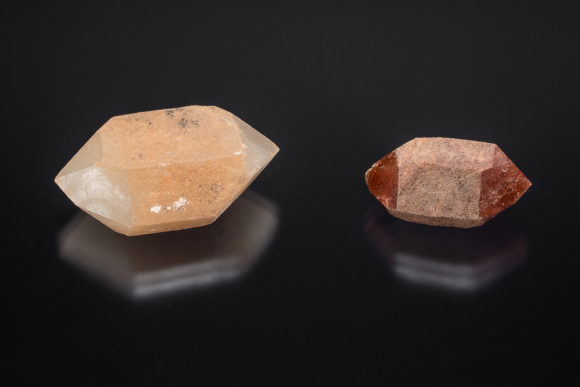
Two prismatic crystals displaying lustrous terminations (r- and z-faces) and dulled, or pitted, m-faces. Left-hand crystal is 3.0cm. ©Enchanted Minerals LLC
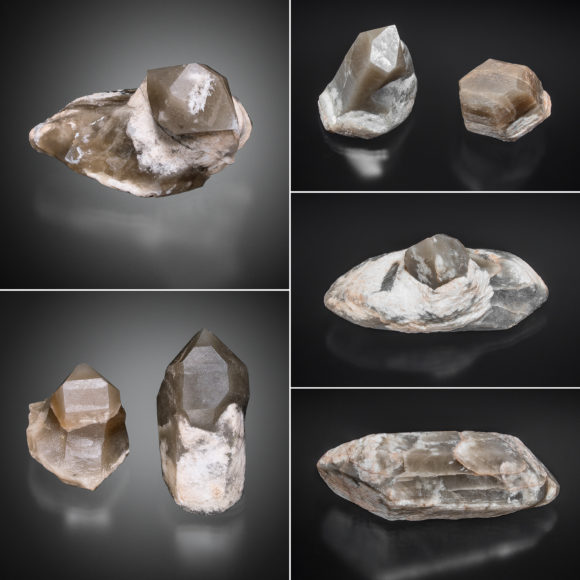
Examples of Pecos Valley Diamonds displaying both crudely crystalline “knobs” and well-formed, lustrous crystals. Clockwise from top left: crystal is 5.1cm; terminated crystal is 4.6 tall; crude crystal is 7.2cm across; crude crystal is 7.6cm across; right-hand crystal is 4.7cm. ©Enchanted Minerals LLC
Groupings
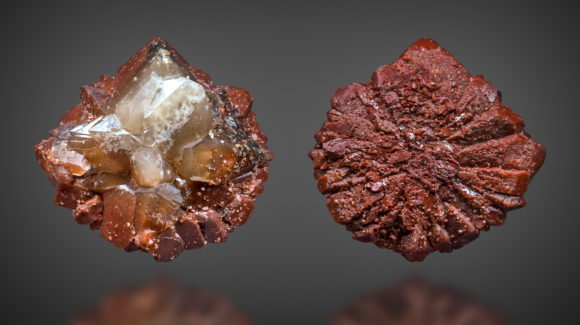
Radially oriented grouping of crystals; specimen shown front and back. Crystal is 3.8cm across. ©Enchanted Minerals LLC
Previous reports (Albright and Lueth 2003) have indicated the presence of Japan law twinned Pecos Valley Diamonds, though it is the opinion of the authors that further examination is needed to determine whether these geometries are truly Japan Law twins. There are a number of other unusual relationships between multiple crystals that are also worth further investigation, including crystal pairs that show indications of potential relationships along the c-axis.
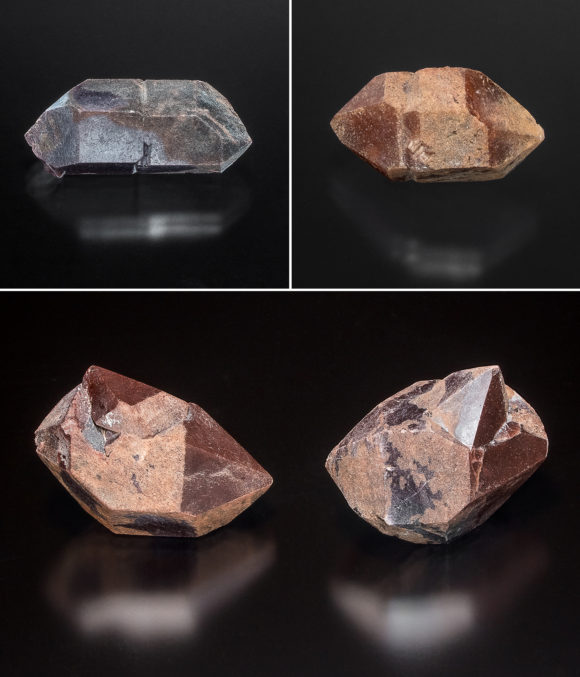
Unusual geometries in groupings of multiple crystals. Top left crystal is 3.1cm; top right crystal is 2.6; bottom right crystal is 3.1cm. ©Enchanted Minerals LLC
For more information on the History and Geology of Pecos Valley Diamonds, see the full-length article from Enchanted Minerals LLC: Pecos Valley Diamonds: the Desert is Paved with Diamonds.
Where to Go!
As mentioned earlier, outcrops of Pecos Valley Diamonds are prevalent throughout the Seven Rivers Formation – this means that anywhere in the yellow area below is prime territory to find them.

Surface outcrops of the Seven Rivers Formation (highlighted in yellow) in Southeastern New Mexico. Modified from Albright and Lueth 2003.
We’ll give you directions to a few of our favorite spots, but we encourage you to take some time to explore on your own! You never know what you might find – though please be sure to check land status of where you’re at and obtain proper permissions.
BLM land is fair game for surface collecting, but private land is not. Many cattle ranches operate in this part of New Mexico – many times you can simply ask permission and you’ll be good to go. Many oil and gas operations are also active in this area – surface collecting is legal around these operations, but be respectful of equipment (re: do not touch it), and also be very aware of any signs or warnings posted indicating the presence of H2S gas – it can and WILL kill you. In short: be smart and be safe while you’re out!
Location 1: East of Artesia (click for map)
Location 1 features small to medium dark red crystals – mainly equant crystals, sometimes pseudocubic!
Location 2: East of Roswell (click for map)
Location 2 features druzy crystals ranging from light to dark red.
Location 3: Acme – northwest of Roswell (click for map)
Location 3 is the site of the first professional paper published on Pecos Valley Diamonds (Tarr, 1929) – crystals are white to pink and usually do not exceed more than 2 cm in length, but this is a fun spot for the history!
Other things you need to know:
The southern region of New Mexico is barren desert. There’s usually not a tree, and if there is, it’s probably a short and stubby one. If you are going to this area during the summer, be sure to be prepared for the heat: pack lots of water, bring sunscreen, etc. Surface collecting without shade in July can be pretty miserable even with all these preparations, so we recommend that you take this trip in the spring or fall. Winter is also an option, but just as the desert is prone to extreme heat in the summer, it has a tendency to be bitterly cold in the winter. New Mexico in the spring time is also known for wind – this is an unpleasant thing when your face is inches from the ground and you can’t see anything except the sand grains in your eyes. There’s not much to be done about the wind, but be aware that it is a possibility.
Other things to do in the area:
If you’re making this trip, there are some other really fantastic things in the area worth checking out. Schedule some of these into your trip, or keep these as a backup option if the weather is poor for collecting.
Number 1 for us on this list is Carlsbad Caverns National Park – this is arguably New Mexico’s pride and joy, and is around 2 hours from Roswell, New Mexico. This National Park protects hundreds of miles of natural cavern systems, including it’s namesake Carlsbad Cavern. There are many things to do while in this park: walking trails, cave tours, historical stops, etc., but we absolutely recommend that you try to make it for one of the Bat Flight Programs that are held from late May through October – this experience is absolutely magical.
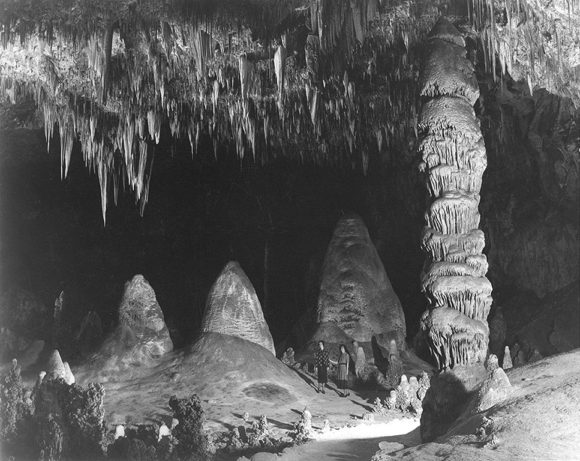
Rock of Ages in the Big Room, c. 1941; photo by Ansel Adams
Number 2: you’re near Roswell, New Mexico. You know what that means. Make a stop at the International UFO Museum and Research Center to explore your alien curiosity or grab some great knickknacks featuring little green men.
There are some other museums and parks in the Roswell area worth considering, including art museums, an aviation museum, and a number of wildlife refuges and bird sanctuaries. Check out some of the options here: Roswell Area Attractions. If you’re up for going out a little further, also consider: Carlsbad Area Attractions, and if you’re up for a real jaunt, consider White Sands National Monument and the White Sands Missile Range Museum.
Related posts:
The post Pecos Valley Diamonds: the Desert is Paved with Diamonds appeared first on Where to Find Rocks.
]]>The post GemShades Collection Debut at The Crystalarium – The Ocular Artistry of Naomi Hinds appeared first on Where to Find Rocks.
]]>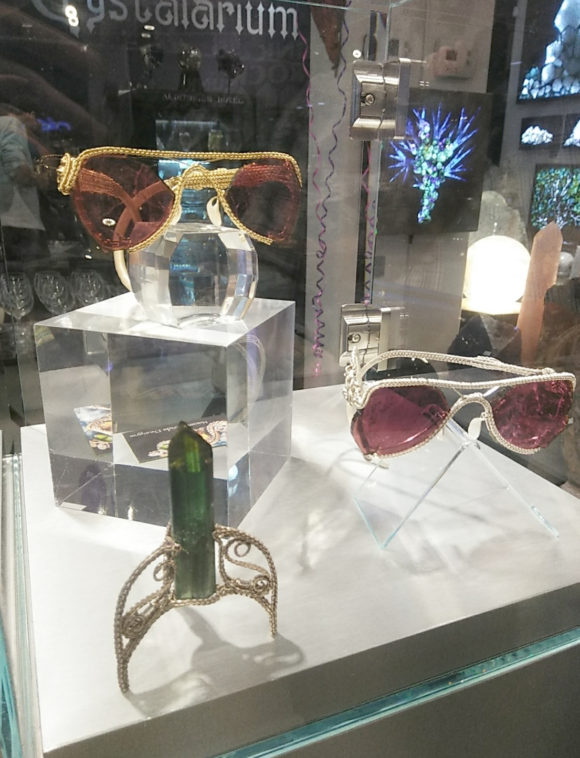
These fine custom sunglasses were a centerpiece of the showcase, featuring bold red tourmaline slices and accessory crystals in the arms.
Fine Jewelry artist Naomi Hinds assembled a dozen unique wire framed gemstone glasses for the showing. Naomi was on hand, along with the fun loving staff of the Crystalarium, to show off these pieces of functional, wearable, art.
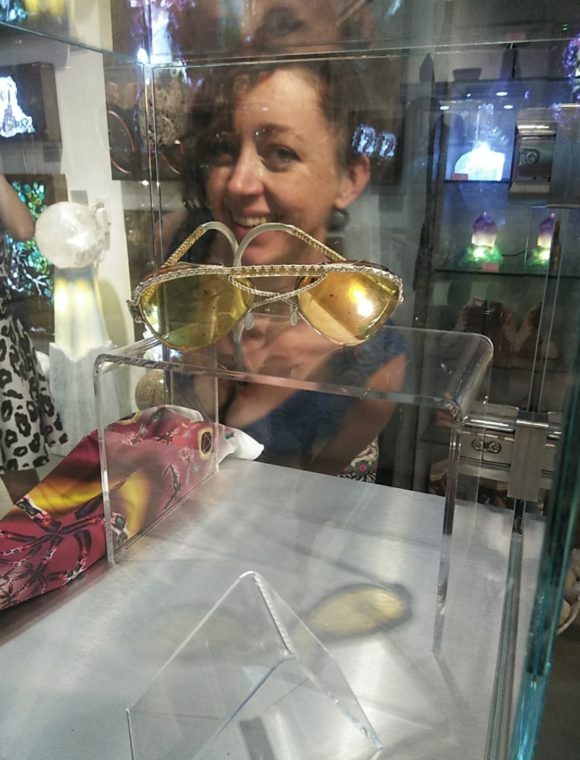
Wire Artist Naomi Hinds was on hand to show a close up view of her functional artwork.
Crystalarium, located on beautiful La Cienga Blvd, in West Hollywood, was truly a perfect setting for this exhibit. The staff certainly coordinated a fine affair, with a live guitarist, fruits and cookies, wine and hors d’oeuvres served through the night, while visitors were able to visit with the artist and get the chance to try on selected pieces.
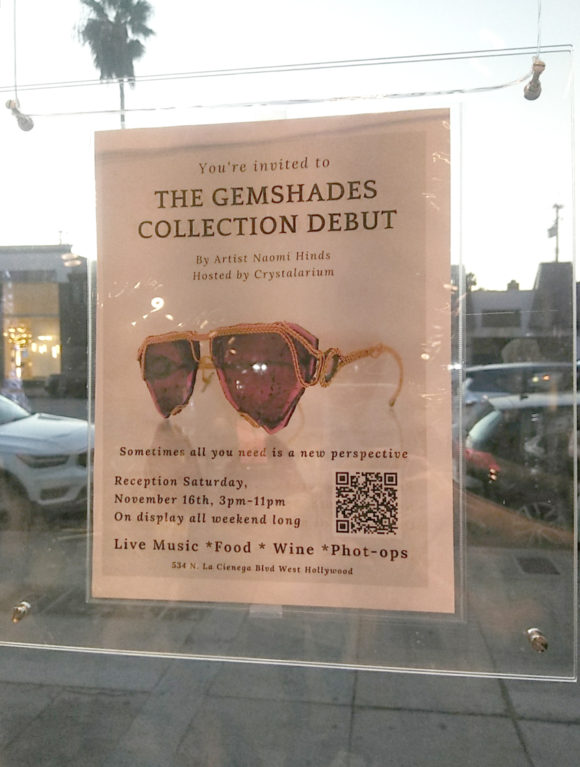
Hosted by the Crystalarium, located on La Cienega, in West Hollywod, the GemShades Collection Debut took place on Saturday, November 16th, 2019.
Follow CrystalariumLA on Instagram to find out about upcoming events and general crystal shenangans going on in West Hollywood!
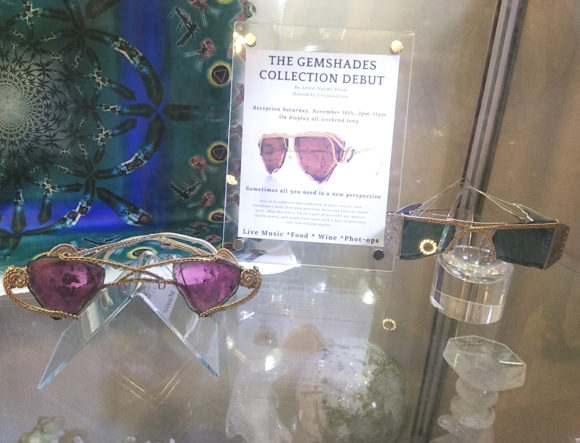
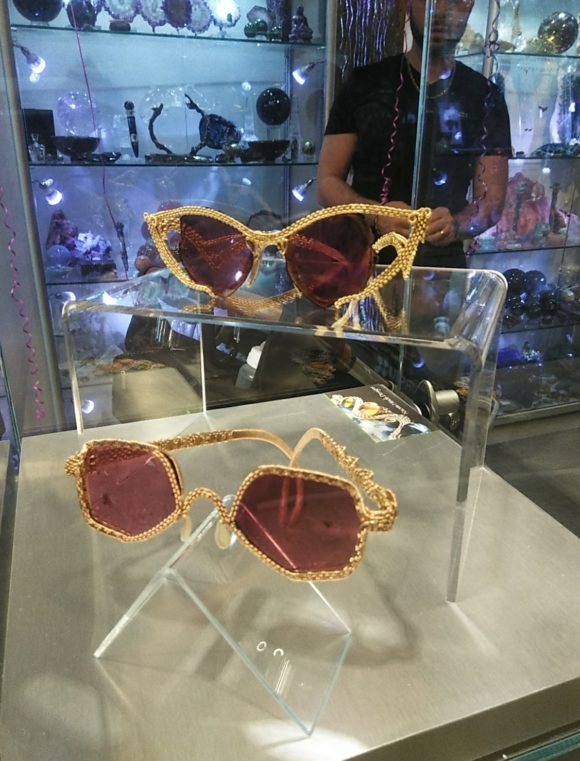
These bold Gold and Red Tourmaline Sunglasses were a hit, with visitors flocking to them all night.
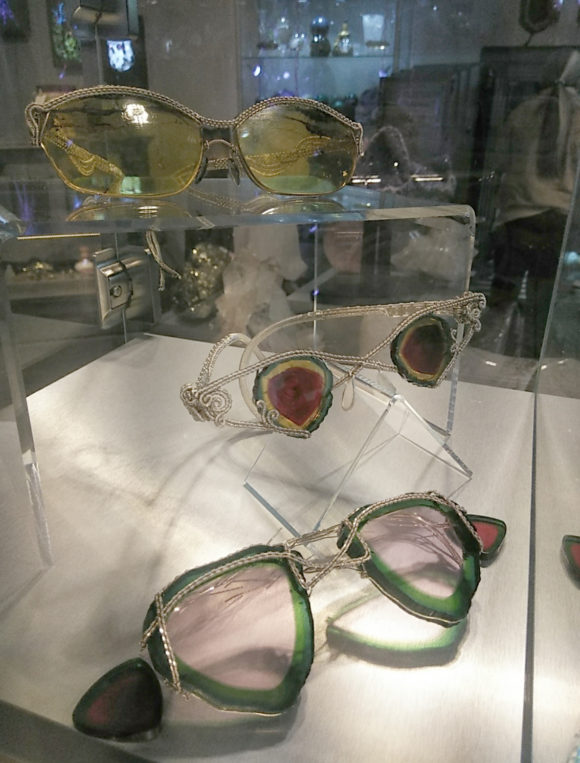
Wild custom framed glasses featuring a collaboration with the glass artist “DiggerGlass”
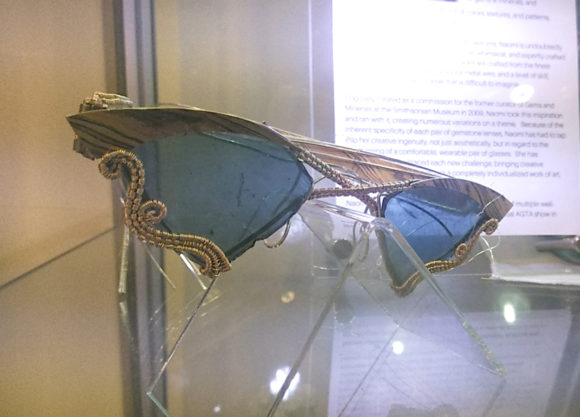
These would certainly set any room ablaze. Gem blue tourmaline slices set into a custom frame created by wire artist Naomi Hinds
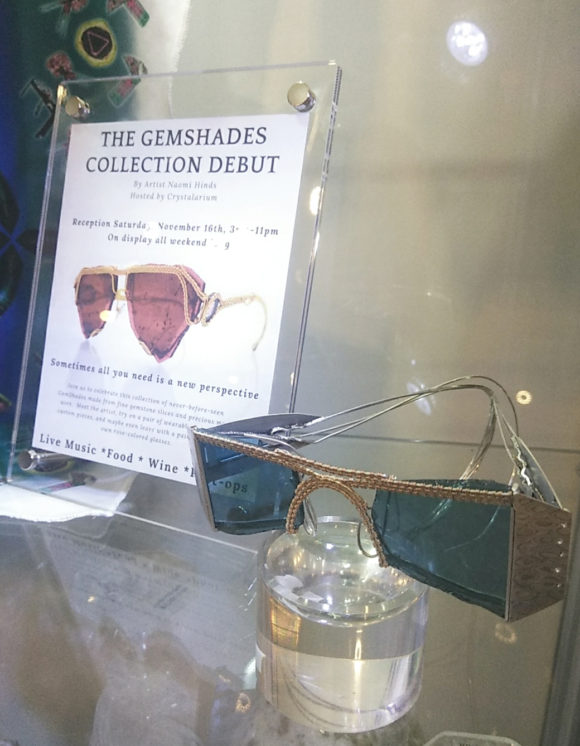
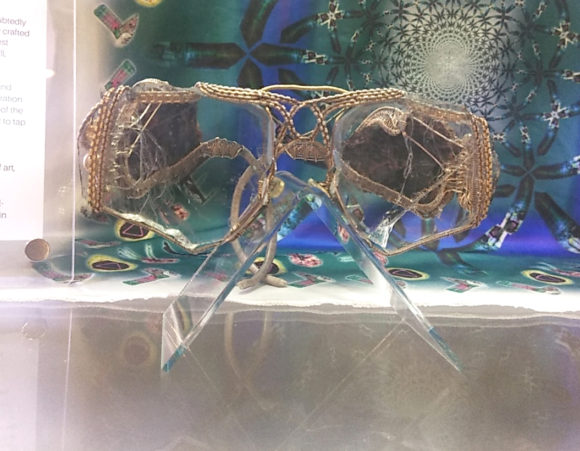
These Unique Lenses are the gem Aquamarine, the Blue Beryl.
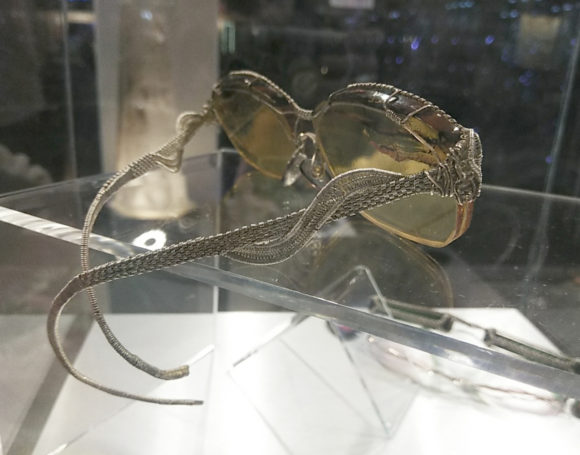
Polished Lenses of Amber give a truly unique look on life!
In addition to the fine works on display, the artist treated the visitors to some behind the scenes looks into how the frames and other works, are designed and made.
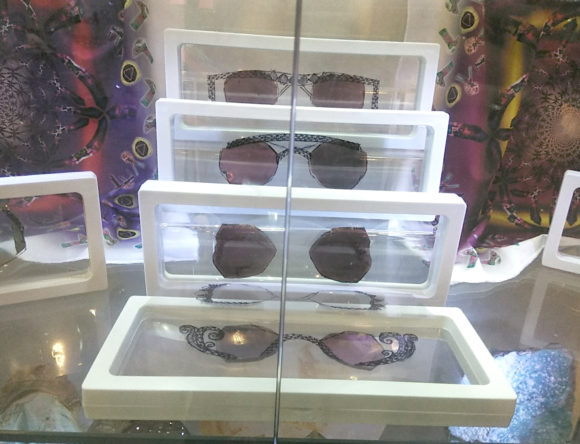
Behind the Scenes of How it is Made – Naomi first matches the slices up and plans on HOW to give life to these unique products of mother nature.
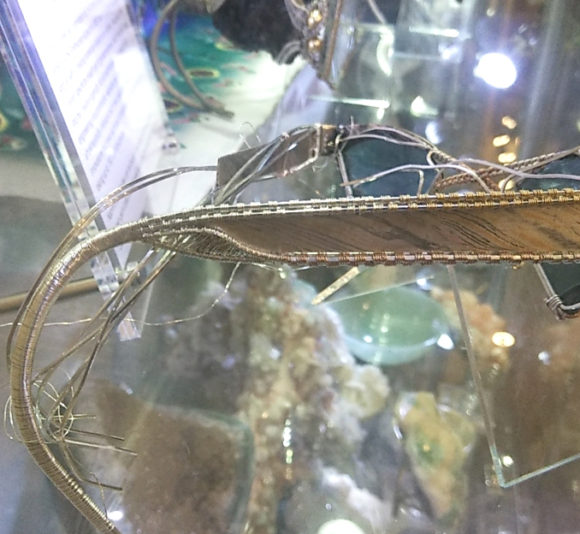
Hours of delicate work are required for each piece, these showcased the left arm in unfinished process, showing a glimpse of how the artist works.
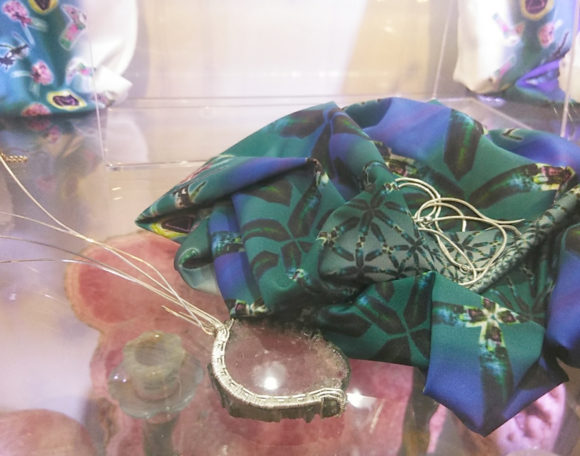
Behind the Scenes look at How it is Made – The Artist showcases a work in progress as this tourmaline slice is custom fit into precious wire.
One case full of stunners included two custom accessory arm features and a fantastic custom woven metal base for a bold green tourmaline, making it look like it was ready to blast into space!

These fine custom sunglasses were a centerpiece of the showcase, featuring bold red tourmaline slices and accessory crystals in the arms.
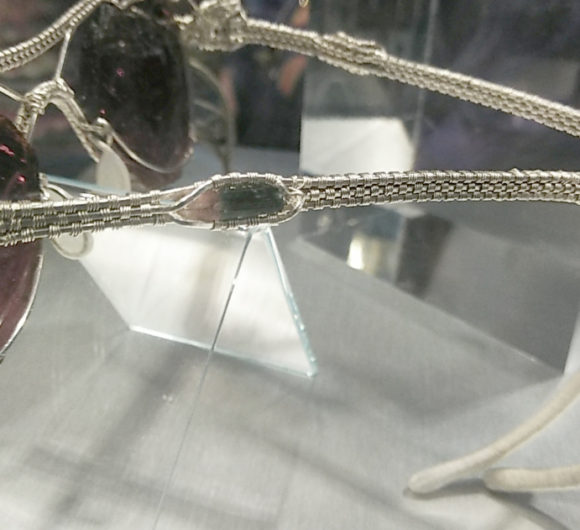
This bold tourmaline scepter accessory crystal is a bold addition to the arms of these GemShades
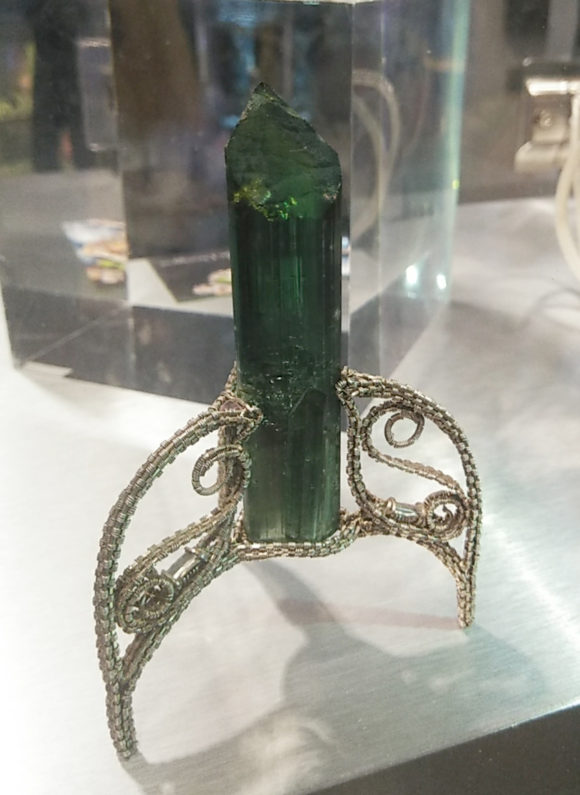
This Crystal looks ready for takeoff!
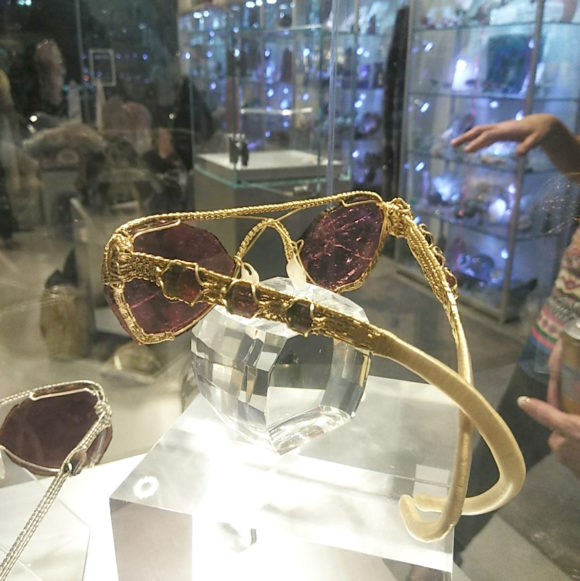
View of the Side Arm to this breathtaking gold wire and tourmaline eyeglasses
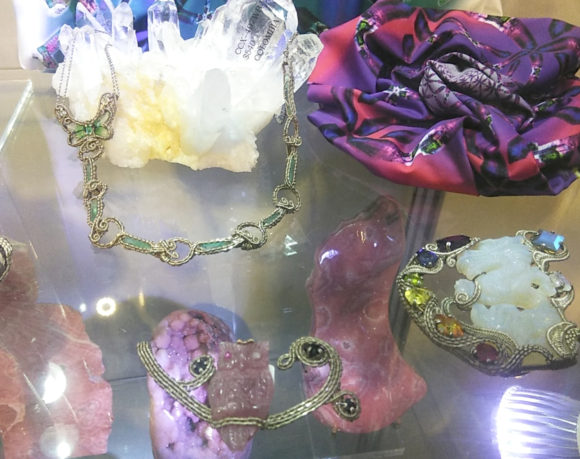
Examples of the artistry of Naomi Hinds, creator of GemShades.
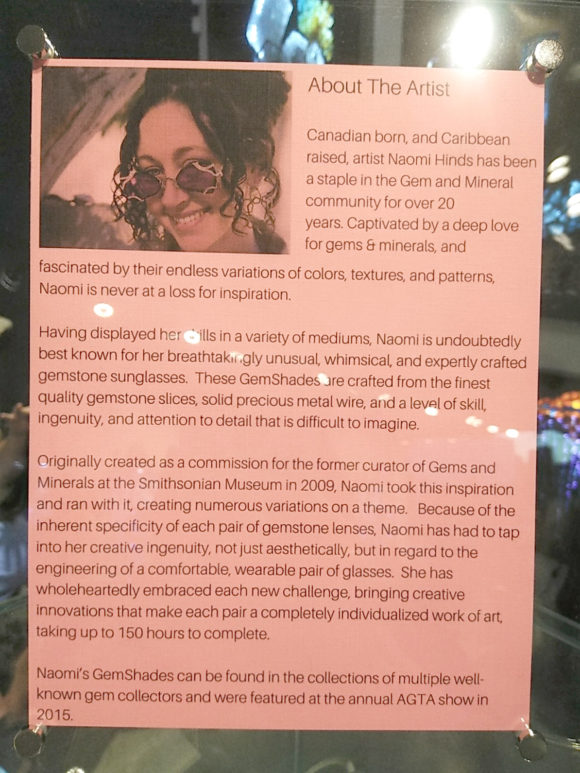
If you would like to contact the artist for information on these or other works, you can find Naomi via this business card, and view her works on instagram @NaomiHindsDesigns

Business Card for Naomi Hinds Designs – contact her for inquires.
I was all too happy to run into Barbie Petrosky, the_miniralogist – creator of HIGH quality mineral memes on Instagram. Be still, my heart!

Barbie Petrosky, known as ig: the_miniralogist, was looking fly with these custom made tourmaline glasses and accented side armature, made by the artist Naomi Hinds.
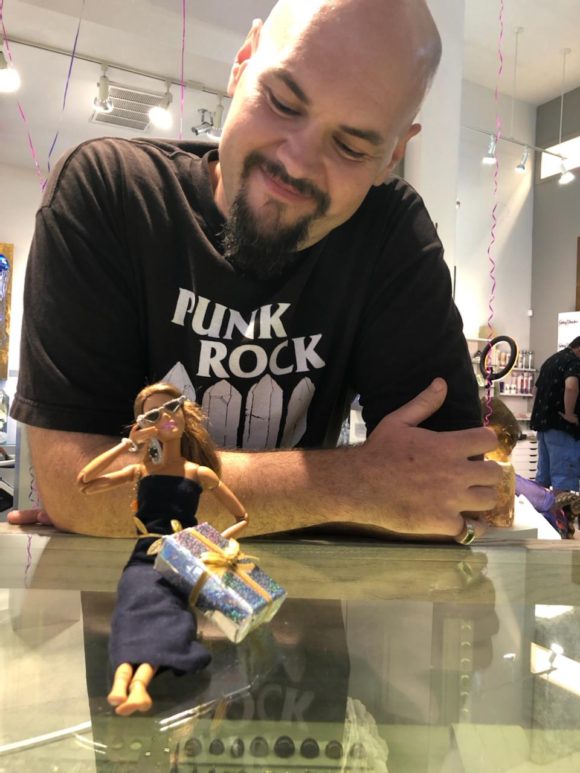
One of Barbie’s MANY admirers!
Related posts:
The post GemShades Collection Debut at The Crystalarium – The Ocular Artistry of Naomi Hinds appeared first on Where to Find Rocks.
]]>The post Collecting Tourmaline at the Himalaya Mine, California appeared first on Where to Find Rocks.
]]>Before we get to the pictures of pretty minerals, let’s talk a little about the history of the Himalaya Mine! (If you really can’t handle this part, you could scroll past, but you’d be missing out on some cool stuff!) The Himalaya Mine was officially located in 1898, though early reports indicate that local Indigenous Peoples knew of the gem crystals. Legend has it that white settlers located the mine after noticing Indigenous children playing with tourmaline crystals!
Gail Lewis was the original claim holder on the mine, though only held the property for four years. In 1902, J.L. Tannenbaum, an employee of Tiffany & Company and a very controversial man, acquired the property through claim jumping. Keep in mind, this is the original usage of the term “claim jumping,” meaning Tannenbaum filed another claim over the top of Lewis’ existing claim. Much legal to-do ensued over this, but Tannenbaum retained the property. The mine was then operated by Tannenbaum with J. Goodman Braye as mine superintendent. Braye is a very interesting figure in mining history, as his position as superintendent was one of significant power and respect and he also happened to be an African American in the early 1900s.
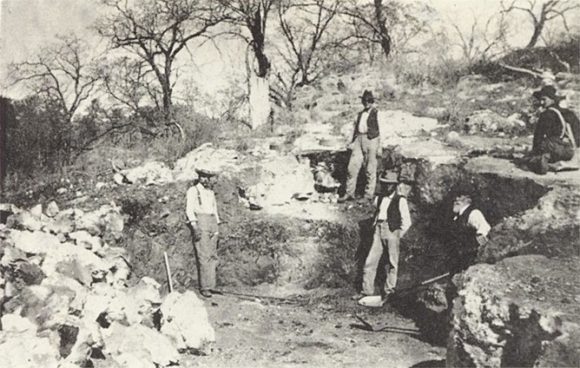
Original caption: “First workings on the Himalaya mine at Mesa Grande, which was later to become one of the greatest tourmaline producers in the world. Left to right: Heighway, who filed on the Himalaya for Tannenbaum of New York; Vance Angel (center above) who was foreman 1900 – 1912; J. Goodman Bray, Jr., colored protege of Tannenbaum who was in charge of the Himalaya; Lohrer, first foreman of the mine; La Chapa, Indian worker. Photo courtesy Vance Angel, Mesa Grande.” Reprinted from the bimonthly magazine Calico Print, Vol. IX, No. 4, July 1953, 40pp. The Calico Press, Twentynine Palms, California.
In the following ten years, reports indicate that 6 tons of tourmaline were shipped for use as lapidary material out of an estimated production of 110 tons produced by the Himalaya Mine and neighboring mines. This would equal value at the time of more than $750,000! By 1904, the surface workings were mined out and work had moved underground.
One of the principal demands for tourmaline was overseas in the Chinese market, where pink and red gemstones were highly prized by the Dowager Empress. This drove a highly speculative market until the overthrow of the Chinese aristocracy in 1911. The downfall of the Chinese aristocracy caused the tourmaline market to crash and ended the early production period at the Himalaya Mine.
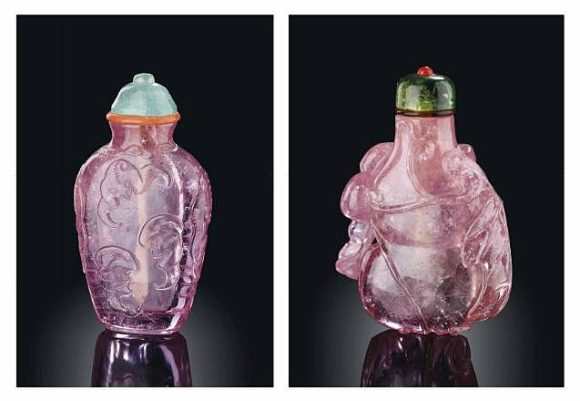
Pink Tourmaline snuff bottles – 19th century – Qing Dynasty – photograph from Christie’s Auction House.
Sporadic small scale mining operations continued between 1913 and the early 1950s. In 1957, Ralph Potter began another attempt at systematic mining at the Himalaya, including rehabilitating several older underground workings and driving several new tunnels. Potter operated the mine for several years, but a collapse of the main tunnel in the winter of 1968-1969 ended underground mining.
In 1977, Bill Larson of Pala Properties International leased the property, later purchasing it in 1988. This period saw extensive tunneling and underground expansion, and produced a relatively consistent stream of minerals in comparison to earlier projects.
The Himalaya Mine is now operated by High Desert Gems & Minerals, who also facilitate the pay dig site.
Over its life, the Himalaya Mine has produced an estimated 250 thousand pounds of tourmaline and mineral specimens. In its most active 15 years, it produced more tourmaline than any other tourmaline mine in the world, including 5.5 tons in 1904 alone (the most tourmaline ever produced in a year).
For more on the history of the Himalaya Mine, see:
Fisher, J., Foord, E. E. and Bricker, G. A. (1999), The geology, mineralogy, and history of the Himalaya mine, Mesa Grande, San Diego County, California. California Geology 52(1): 3-18.
Jacobson, Mark Ivan (September 2010): Lippman Tannenbaum: President of the Himalaya Mining Co. and a Difficult Person, Mineral News, Vol. 26, No. 9.
Jacobson, Mark Ivan (January 2017): The Early History of the Himalaya Pegmatite Mine – San Diego County, California, Mineral News, Vol. 33, No. 1.
So, what you really want to know: what can you find?!
Tourmaline – Elbaite:
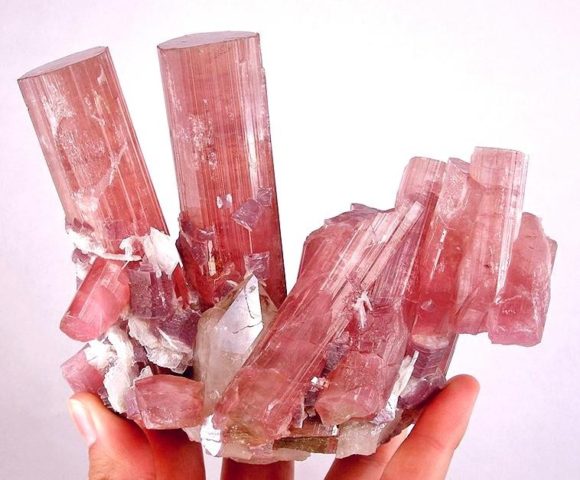
Tourmaline, Lepidolite, and Quartz – 14 cm across – photograph from Rob Lavinsky, iRocks.com.
The Himalaya Mine’s most notable mineral is tourmaline, a complex hexagonal boron-aluminum-silicate mineral group. Most tourmaline from the Himalaya Mine is the species elbaite. The tourmalines can range in color from black to vivid pink to apple green, and some crystals even feature multiple colors! Blue tourmaline is also present, but is rarely found.
Approximately 5% of tourmaline from the Himalaya Mine are gemmy, meaning they have the high translucency that allows them to be faceted into glassy gem stones.
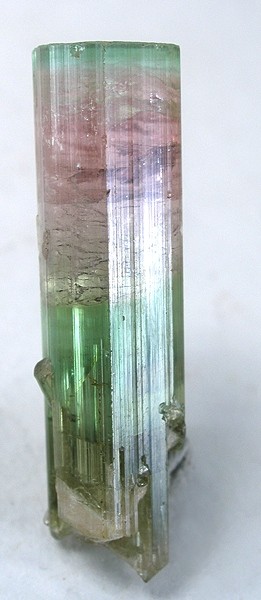
Elbaite – a gemmy crystal showing greens and pinks – 3.9cm tall – photograph from Rob Lavinsky, iRocks.com.
Lepidolite:
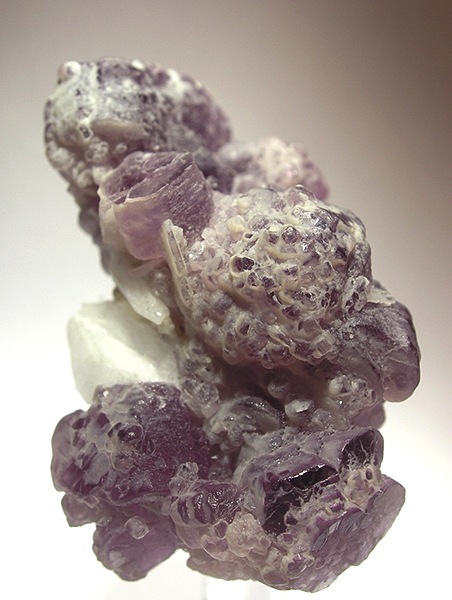
Lepidolite on Hambergite – 4.5cm tall – photograph from Rob Lavinsky, iRocks.com.
Lepidolite is a series of the mica group minerals. Lepidolite is rich in lithium, though the pink to red color of lepidolite is usually attributed to manganese content. Because lepidolite is a mica group mineral, it is often very flaky, but some material can be used in lapidary work.
Quartz:
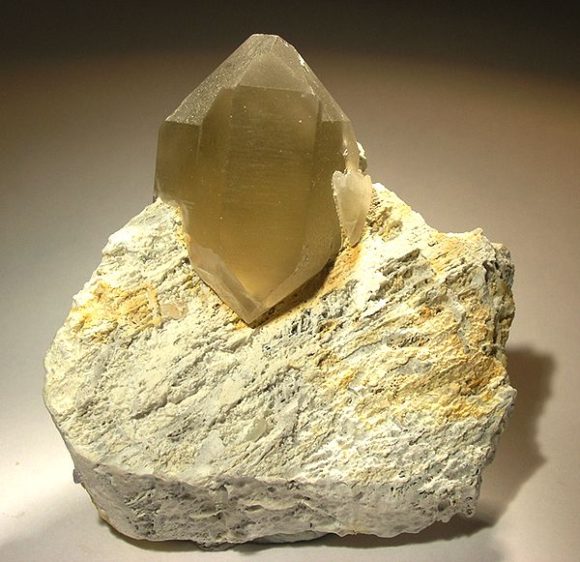
Quartz on Microcline – 7.8cm – photograph from Rob Lavinsky, iRocks.com.
Since the Himalaya Mine is a pegmatite mine, quartz is common throughout the deposit. It can occur as clear “rock crystal” quartz, milky quartz, and even smoky quartz. Some top specimens feature tourmaline or other minerals attached to quartz in beautiful ‘combination’ specimens.
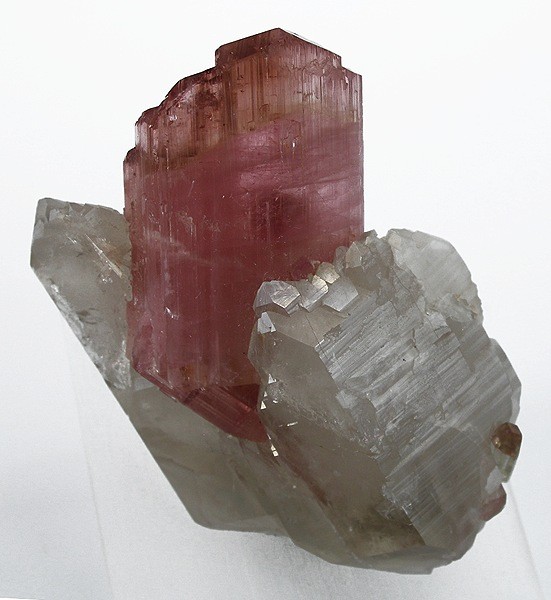
Elbaite on Quartz – 6.0 cm – photograph from Rob Lavinsky, iRocks.com.
Microcline:
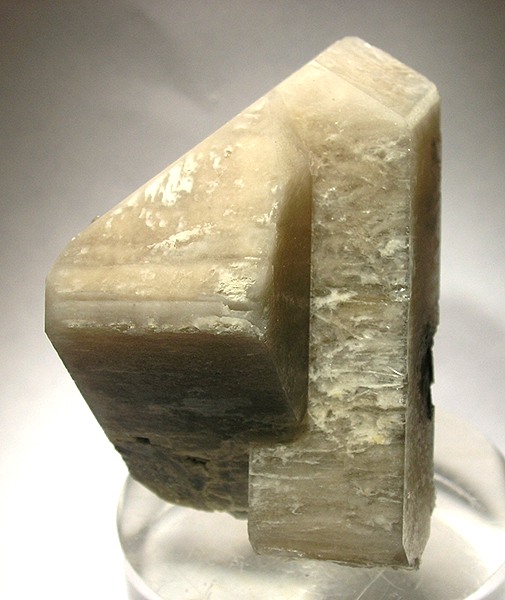
Microcline (Carlsbad twin) – 6.0 cm – photograph from Rob Lavinsky, iRocks.com.
Like quartz, feldspar is an integral part of the mineralogy of the Himalaya Mine. The most common feldspar species found is microcline. Microcline from the Himalaya Mine is often beige to colorless, and can featured etched surfaces as well as crystallographic twinning. Microcline is rarely gemmy from anywhere in the world, and this is also true at the Himalaya: it will likely appear as blocky opaque white-ish crystals.
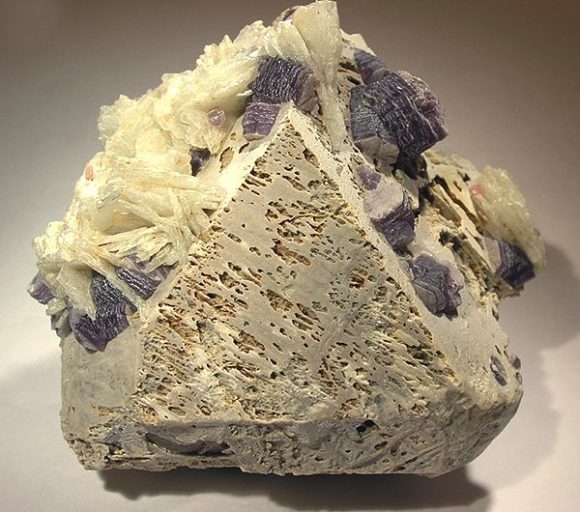
Etched Microcline (twinned) with Albite and Lepidolite – 10.1 cm – photograph from Rob Lavinsky, iRocks.com.
Albite – variety Cleavelandite:
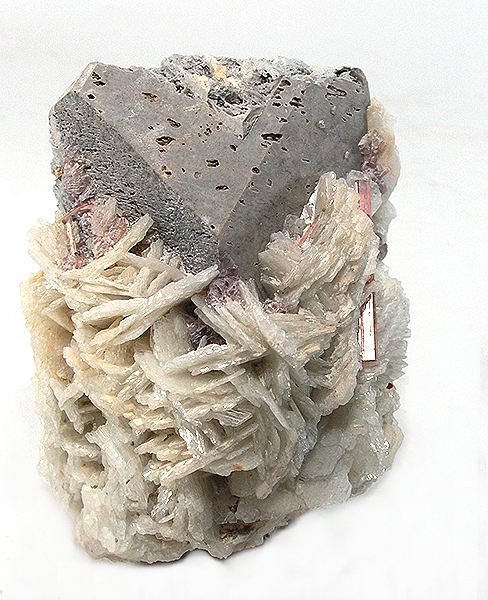
Albite on Orthoclase with Tourmaline – 8.6cm – photograph from Rob Lavinsky, iRocks.com.
Albite is another of the feldspar species present at the Himalaya Mine. It often occurs as the variety Cleavelandite, which occurs as thin, platy crystals. Cleavelandite at the Himalaya Mine often occurs in beautiful rosettes of colorless to very faint blue, and can often be somewhat translucent.
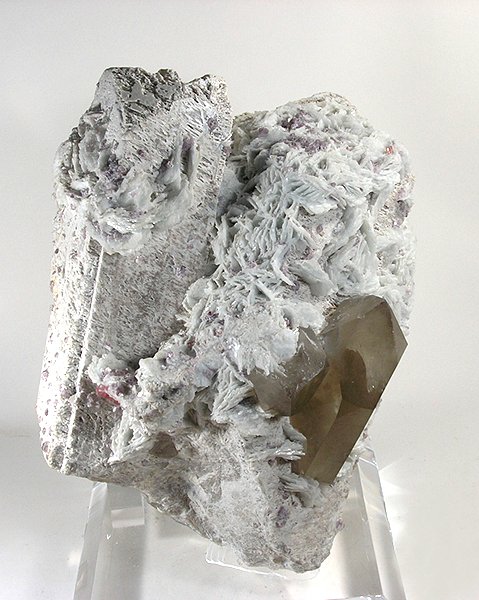
Albite on Microcline with Quartz and Lepidolite – 25.0 cm – photograph from Rob Lavinsky, iRocks.com.
Fluorapatite:
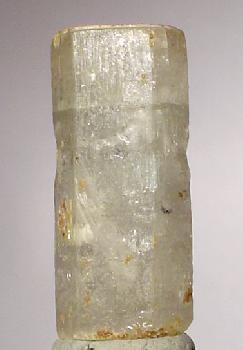
Apatite – 2.3cm – photograph from Rob Lavinsky, iRocks.com.
Fluorapatite from the Himalaya Mine is a uncommon, but is worth looking for! Colors range from colorless to blue to intense pink. Fluorapatite from the Himalaya Mine is light sensitive, so be prepared for colorless crystals on the surface and be sure to protect any colored crystals you happen to find.
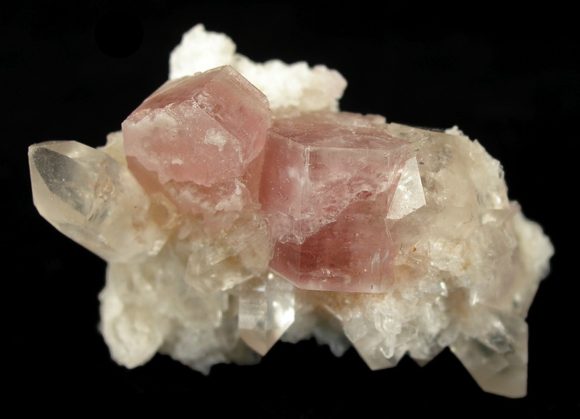
Apatite on Quartz – 4.1cm – photograph from Rob Lavinsky, iRocks.com.
Beryl, topaz:
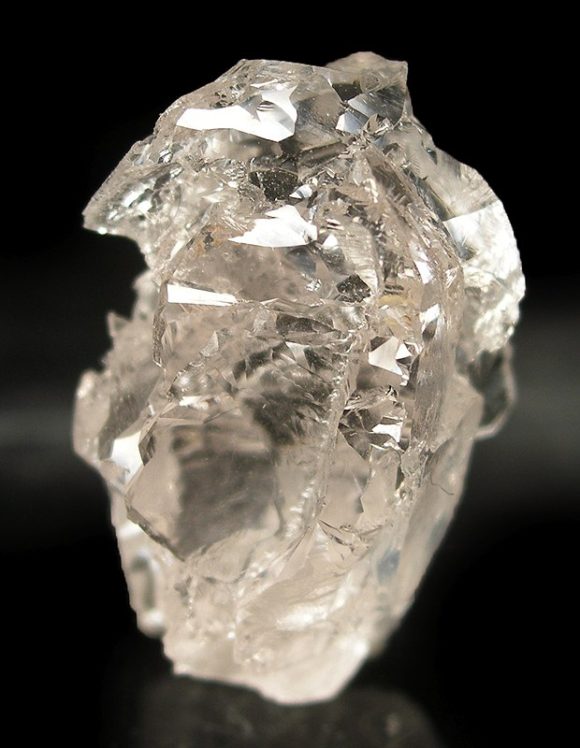
Beryl (etched) – 2.9cm – photograph from Rob Lavinsky, iRocks.com.
While beryl and topaz do occur at the Himalaya Mine, they are exceedingly rare. Keep an eye out for oddities though – you could get lucky! Beryl can occur as etched “floater” crystals, though fully formed crystals have also been found. Beryl colors at the Himalaya include goshenite (colorless), morganite (pink), and aquamarine (blue). Topaz is so rare at the Himalaya that we couldn’t even find a photo to share with you! Both beryl and topaz will likely look much like quartz, though there are physical qualities to help distinguish them – be sure to make use of the staff at the mine to help answer questions you have about your finds!
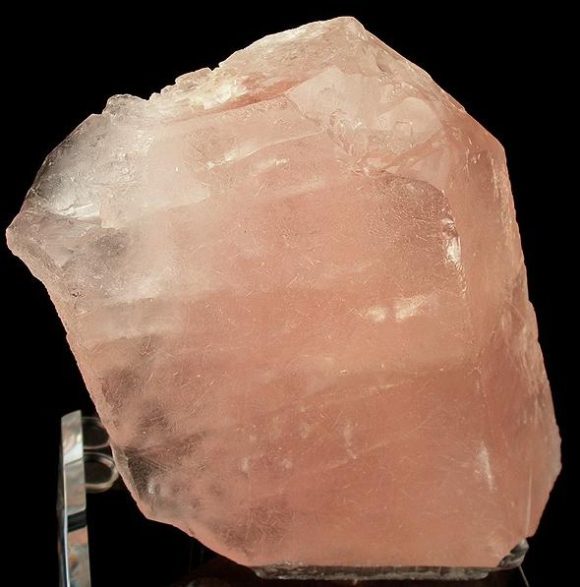
Beryl (morganite) – 11.7 cm – photograph from Rob Lavinsky, iRocks.com.
Hambergite:
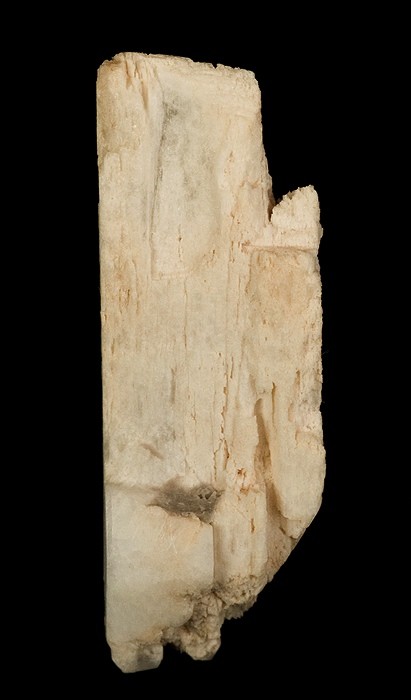
Hambergite – 4.4cm – photograph from Rob Lavinsky, iRocks.com.
Hambergite is another relatively rare pegmatite mineral that often occurs with beryl. Well-formed crystals of hambergite are hard to come by from anywhere in the world, but they can be found at the Himalaya Mine. They occur as creamy white crystals, but can also range from an orange-ish tint to a salmon orange-pink. They are sometimes opaque and sometimes gemmy, sometimes etched and sometimes sharp. Again, if you have questions about what you are finding, ask the staff – they’ve seen a lot of this material and have a lot of knowledge to share!
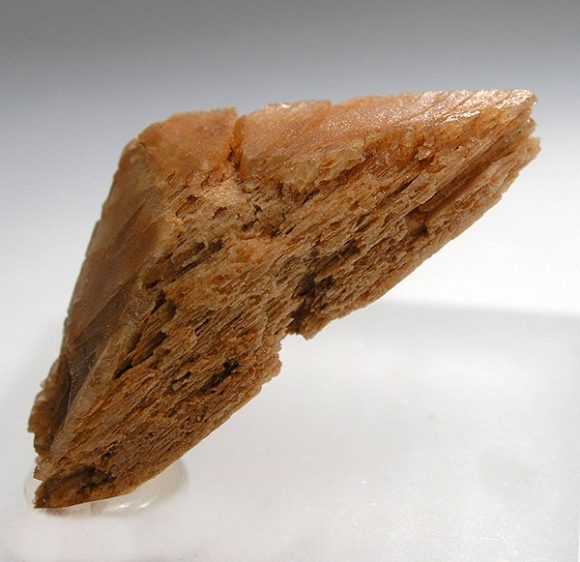
Hambergite – 2.9cm – photograph from Rob Lavinsky, iRocks.com.
Stilbite:
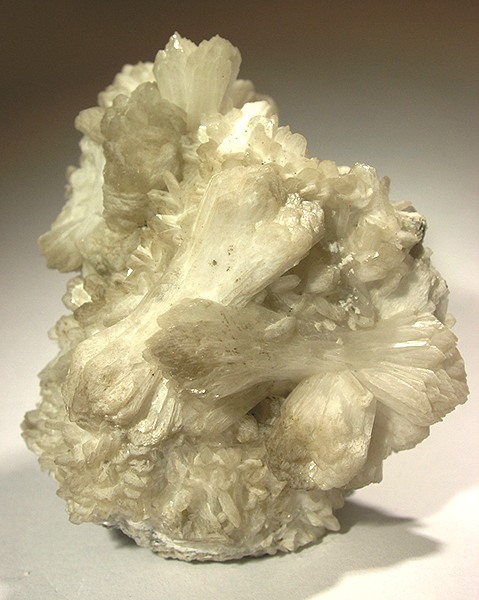
Stilbite-Ca – 5.5cm – photograph from Rob Lavinsky, iRocks.com.
Stilbite occurs at the Himalaya Mine as white to cream colored crystals often found in “wheat sheaf” shaped sprays of crystals. Stilbite is technically a super group of zeolite (framework alumosilicate) mineral species, but that chemistry makes it even more interesting at this locality! Stilbite rarely makes stand-alone specimens at the Himalaya (though that’s still possible!) – but look for it in combination with other minerals!
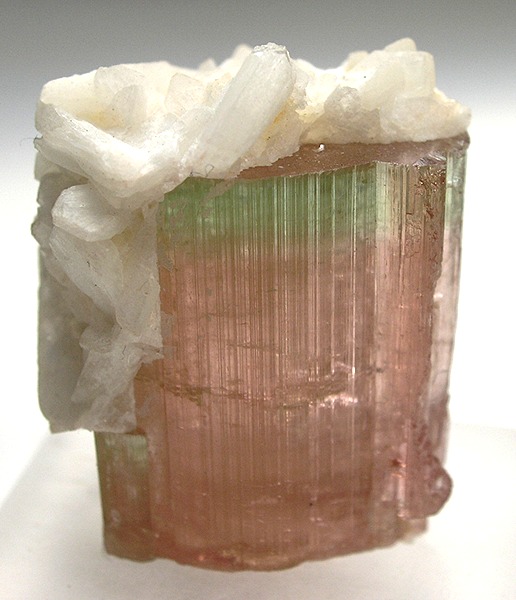
Stilbite on Tourmaline – 2.8 cm – photograph from Rob Lavinsky, iRocks.com.
Stibiotantalite, Columbite-(Mn), and other “ugly” minerals:
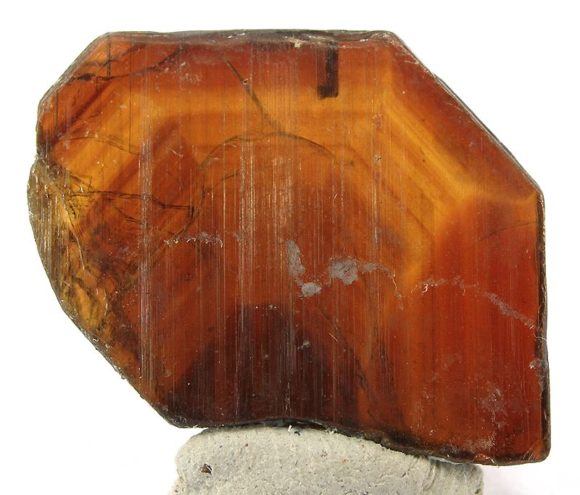
Stibiotantalite (zoned) – 1.8cm – photograph from Rob Lavinsky, iRocks.com.
For those of you who also love the “ugly” minerals of the world, keep an eye out for some of other pegmatite rarities: stibiotantalite and columbite-(Mn)! These minerals will occur as black to root beer brown colored crystals, usually with a somewhat flattened shape. Some stibiotantalites even exhibit a beautiful color zoning! These minerals, though lacking the vivid colors of some of your other possible finds, have a fascinating chemistry (they include rare elements like tantalum and niobium!) and are fairly rare in worldwide deposits – don’t throw them away!
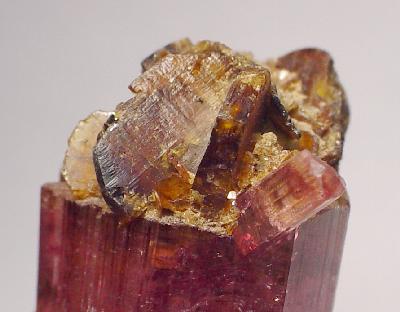
Stibiotantalite on Tourmaline – 6.0 cm – photograph from Rob Lavinsky, iRocks.com.
There are a few other minerals we haven’t mentioned (mostly because they’re super rare or uninteresting or both), but you can see a complete list and more photos on mindat.org here: Himalaya Mine, Gem Hill, Mesa Grande Mining District, San Diego County, California, USA.
Dig info:
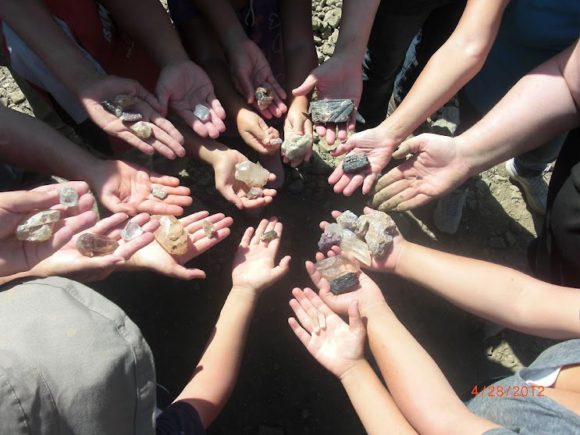
Himalaya Mine Finds! – photograph from Himalaya Tourmaline Mine.
So now that you’re ready to pack the car and go, here’s the rest of the important information you need to know!
The Himalaya Mine dig site is open year round on Thursdays through Sundays from 10am to 3pm (Monday digs can be arranged by reservation only). The mine is located near Santa Ysabel, California and is open to the public. Visitors can dig and screen through ore from the mine in search of pink, green, and black tourmaline, quartz, garnet, lepidolite, cleavelandite, and more!
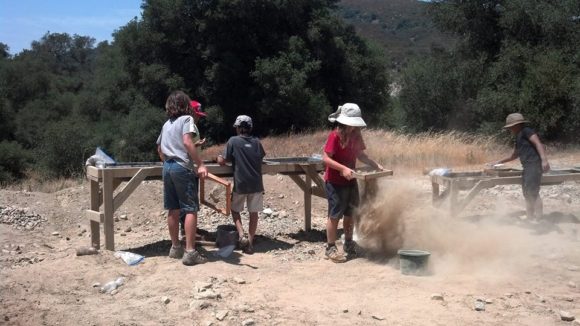
Screening for Gems – photograph from Himalaya Tourmaline Mine.
The cost for adults is $75/day, 13-15 years old is half price ($37.50/day), children 12 years and under are free with a paying adult, and additional children are $20/day. Senior and active military discounts, rain discounts, and group rates are available.
Be prepared to go digging: it’s going to be dirty and weather is going to happen. Be sure to bring appropriate gear (sunscreen, raincoats, shoes that can get muddy, etc.) as well as food and water. Sorting through material can be made easier with toothbrushes and rubber gloves. Don’t forget baggies/buckets and wrapping material for your finds!
How to Get There:
LISTEN UP, FOLKS! Do NOT use Google Maps or Map Quest to take you to the “Himalaya Mine” – this will NOT take you to the right location and you will end up LOST!
Instead, use the address Lake Henshaw 26439 Hwy 76, Santa Ysabel, CA 92070 to take you to Lake Henshaw Resort. You will need to go into the store (across from the lake and in the same building as the restaurant), ask for the mine dig, and the cashier will give you a code and further directions.
Make use of the MAP provided by High Desert Gems & Minerals by clicking here.
Be sure to check out High Desert Gems & Minerals’ website for any further information on the dig: Himalaya Tourmaline Mine Dig.
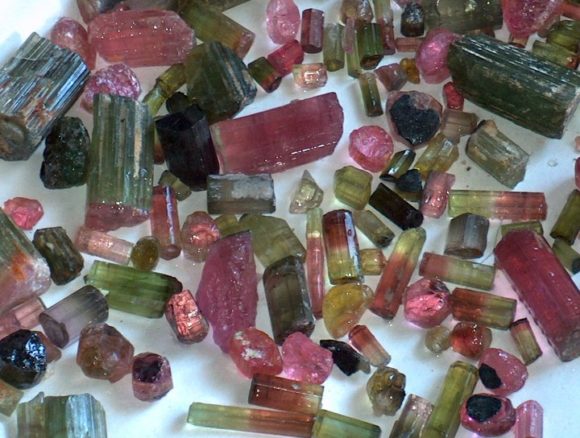
Himalaya Mine Tourmaline – photograph from the Himalaya Tourmaline Mine.
Related posts:
The post Collecting Tourmaline at the Himalaya Mine, California appeared first on Where to Find Rocks.
]]>The post Trona Gem-o-Rama CANCELED for 2019 due to Earthquake! appeared first on Where to Find Rocks.
]]>Due to the massive earthquakes of the Summer of 2019 that were located right next to the town of Trona, the gem show and field trips for 2019 have been CANCELED.
That’s right, there is no show, there are no field trips.
Back in 2008 there was a tipped over truck for the Blow Hole Dig.
Take a look at the video from back then –
If you can imagine, Pink Halite will be in SLIGHTLY shorter supply this year. Maybe it will be possible for some dealers to take this chance to blowout what they have unwillingly stockpiled from the past couple years.
There will be 50x less posts of people trying to sell 50 pound clusters of funky Hanksite, destined to turn crusty and poison all your plants in your front yard.
Saw these funky display stands while looking for Halite photos.
They put Granola, Coffee grounds and Ramen Noodles in these display stands!
What do you think of that?
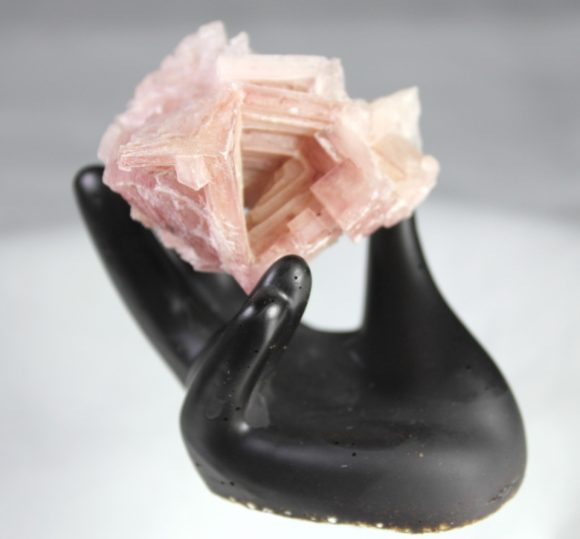
Pink Halite from Trona California on a display stand made from Resin and Cafe Bustelo Coffee Grounds.
We would like to thank everyone involved with the Trona Show and hope for its return in 2020!
Related posts:
The post Trona Gem-o-Rama CANCELED for 2019 due to Earthquake! appeared first on Where to Find Rocks.
]]>The post The Top 11 Toxic Minerals – Lies the Internet Told You appeared first on Where to Find Rocks.
]]>Disclaimer: our goal here is clear up some rampant fear-mongering, but any substance in significant doses or in specific situations can be very dangerous – even water can be deadly if consumed in significant quantities, and it will definitely kill you if you try to breathe too much of it! As a general rule, don’t eat your mineral specimens, don’t grind them into powders and snort them, don’t cook them and inhale their vapors, and please don’t look for any other ways to put them into your body. They just don’t belong there. Keep minerals out of reach of pets and children. And wash your hands – it’s just good hygiene anyway.
11. Fluorite
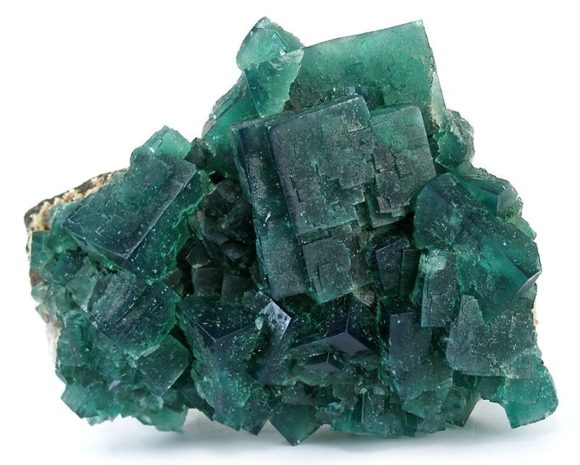
Fluorite from Rogerley Mine, Frosterley, Weardale, North Pennines, County Durham, England, UK – photograph from Rob Lavinsky, iRocks.com.
Fluorite (CaF2) is a mineral that is listed as being dangerous because it contains the element fluorine, which by itself can be some nasty stuff. However, when fluorine is bonded with calcium, it has entirely different properties than fluorine by itself.
To better understand this, let’s take a little detour and talk about the mineral halite (NaCl – sodium chloride). Sodium (Na) is a highly reactive alkali metal that forms flammable hydrogen and caustic sodium hydroxide when it comes into contact with water – in short, it will burn you if it touches moisture on your skin, eyes, etc. Chlorine is a toxic gas that attacks the respiratory system, eyes, and skin. However, when deadly sodium bonds with toxic chlorine to form halite, we end up with table salt, a compound that we frequently add to food.
Similarly, fluorite does contain fluorine (which is some nasty stuff) but when fluorine is bonded with calcium, it has entirely different properties and does not inherently carry the risks of elemental fluorine.
10. Pyrite
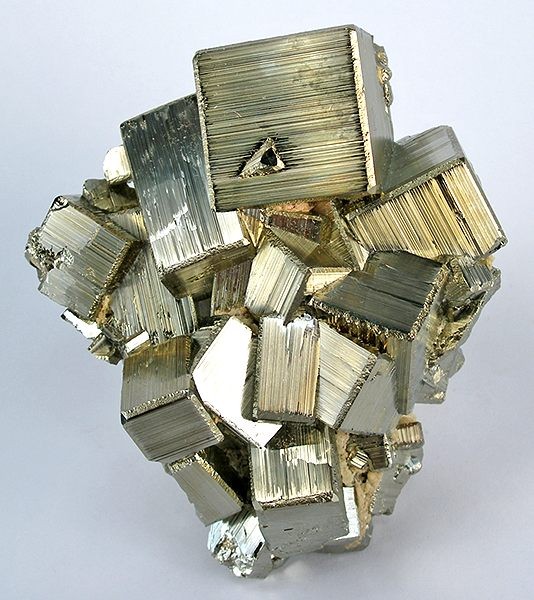
Pyrite from Huaron Mining District, San Jose de Huayllay District, Cerro de Pasco, Daniel Alcides Carrión Province, Pasco Department, Peru – photograph from Rob Lavinsky, iRocks.com.
Pyrite (FeS2) is a relatively common mineral, often colloquially known as Fool’s Gold because of its brassy appearance. Pyrite is included on lists of toxic minerals because it might contain small amounts of arsenic.
Yes, pyrite can contain some arsenic, but since pyrite is not soluble in water or hydrochloric acid it poses no risks when handled.
An important thing to understand is that for any substance to be harmful, it must have bioavailability. Bioavailability is a term used to describe the degree and rate at which a substance is absorbed into a living system. A substance with high bioavailability can be readily absorbed into your body, whereas a substance with low bioavailability cannot be.
With many minerals, bioavailability will depend on the solubility of a mineral. Most material that has solidified (crystallized) has done so in a way that results in a stable, non-reactive substance. Minerals that aren’t stable tend to easily break down and often don’t survive very long. Solubility requires a fluid, and when considering potentially toxic minerals, the two most important fluids to consider are water (perspiration and saliva) and hydrochloric acid (stomach acid). Minerals that are soluble in water are a possible risk when handling the material, whereas minerals soluble in hydrochloric acid are a possible risk if the material is ingested.
9. Galena
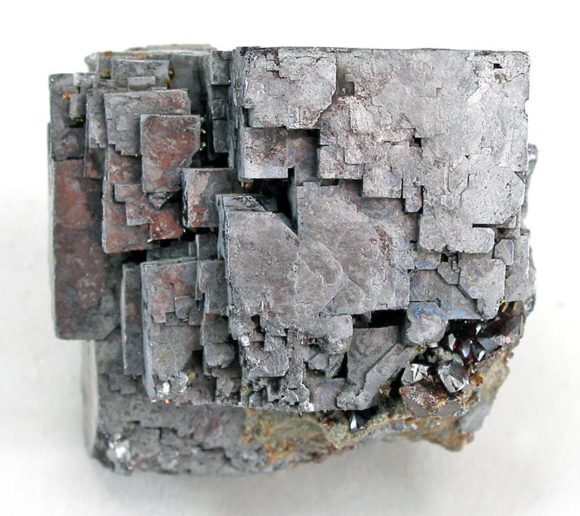
Galena from Elmwood mine, Carthage, Central Tennessee Ba-F-Pb-Zn District, Smith County, Tennessee, USA – photograph from Rob Lavinsky, iRocks.com.
Galena (PbS – lead sulfide) is often listed as a toxic mineral because of its lead content.
However, when lead is chemically bonded with sulfur, we find a highly insoluble compound – lead sulfide is virtually insoluble in water, and only very slightly soluble in hydrochloric acid.
While we’re here, let’s talk a little more about the toxicity of lead. It’s common knowledge that lead is toxic, but that is a concept that has come from the ban of lead oxide. Metal lead isn’t banned at all! There are many nuances to chemistry that we don’t have time to explain in depth in this article, but it is important to realize that an element in itself isn’t toxic – toxicity is complicated and is very specific to what kind of reactions can happen when any element at any given oxidation state interacts with anything else. One thing is pretty straightforward though: if a stable substance doesn’t dissolve, it has a low chance of being able to react with anything, thus it cannot create any change that might interact with the human body.
8. Stibnite
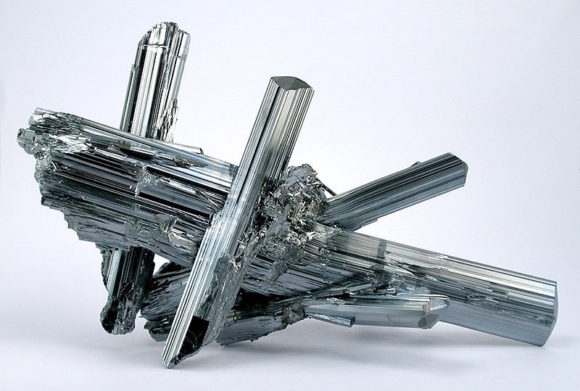
Stibnite from Wuning Mine (Wuling Mine; Qingjiang Mine), Qingjiang, Wuning County, Jiujiang Prefecture, Jiangxi Province, China – photograph from Rob Lavinsky, iRocks.com.
Stibnite (Sb2S3 – antimony sulfide) is listed because of its antimony content, but again it is nearly insoluble and poses no risk.
For some technical talk, the Center for Disease Control (CDC) describes chemicals in terms of LD50, which is a number that measures the dose needed to kill 50% of individuals. This number is measured in the weight of chemical per unit weight of body tissue (usually this is in milligrams per kilogram or mg/kg).
The CDC lists studies of the LD50 of elemental antimony in rats being between 900 and 20,000 mg/kg, which roughly translates to 90 to 2,000 grams (~0.2 to over 4 pounds) of antimony in a 220 pound human (though please note that different animals can have different sensitivities to a substance). Long story short, it would likely be difficult for a human to ingest that much stibnite to begin with, and, with a very low solubility, it is unlikely it would remain in your system long enough to release enough native antimony to cause any ill effects.
7. Hydroxylapatite
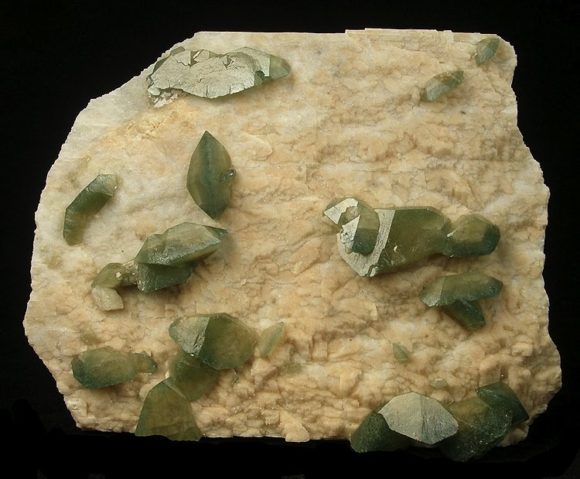
Hydroxylapatite from Sapo mine, Conselheiro Pena, Doce valley, Minas Gerais, Southeast Region, Brazil – photograph from Rob Lavinsky, iRocks.com.
Hydroxyapatite (Ca5(PO4)3(OH) – calcium hydroxide phosphate) is mentioned on lists of toxic minerals because it is the same material as bone and, supposedly, if you ingest it, it will cause blockages by depositing bone in your arteries.
This is just utter hogwash. Hydroxyapaite, also called hydroxylapatite or apatite-(CaOH), is soluble in hydrochloric acid but will break down into calcium ions and phosphoric acid, both of which exist in your body naturally. (Fun fact: phosphoric acid is the ingredient in some sodas that give it a tangy taste.) If you were to ingest large amounts of hydroxyapatite, you may find yourself with a case of kidney stones, but to fear your arteries turning into bone is completely unnecessary.
6. Coloradoite
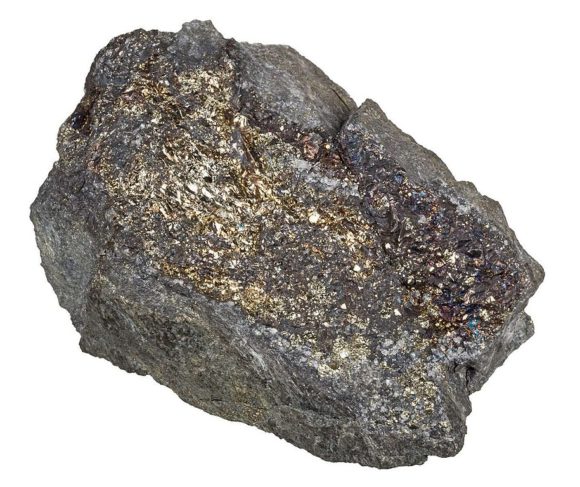
Coloradoite from Kalgoorlie-Boulder, Kalgoorlie-Boulder Shire, Western Australia, Australia – photography from Rob Lavinsky, iRocks.com.
Coloradoite (HgTe – mercury telluride) makes the list for containing both mercury and tellurium.
This compound is not soluble in water or hydrochloric acid and poses no risks to handling. It’s also a particularly rare mineral that you’re not likely to happen across accidentally.
There is another risk we should discuss though – mineral dusts. When looking at solubility and resulting bioavailability of minerals, the first concern is the introduction of large quantities of the material into the body (i.e. ingesting 4 pounds of stibnite). However, there is a more innocuous way for minerals to enter your body and that is through your lungs. Since the lungs do not flush themselves out as regularly as the digestive tract, minerals can be trapped in the body for longer periods of time which gives them more time to dissolve. Dusts also have more surface area that larger chunks of material, which allows chemical reactions to occur more easily. These things coupled together mean that material inhaled into the lungs could dissolve over time and cause serious health concerns. (See more about risks related to inhalation below in our special mentions.) Do NOT breathe your minerals!
5. Hutchinsonite
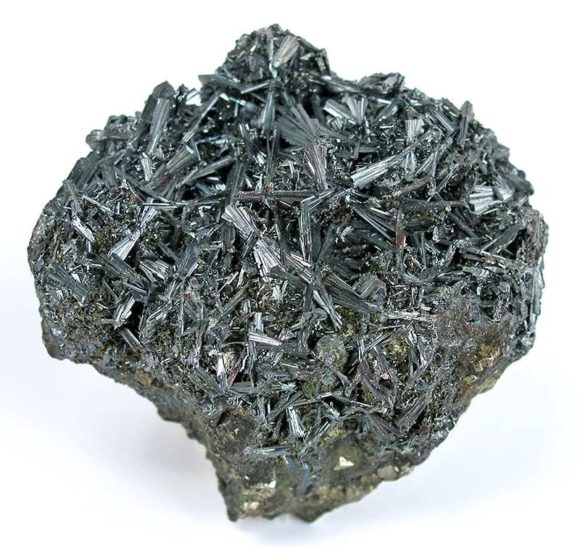
Hutchinsonite from Quiruvilca Mine (La Libertad Mine; ASARCO Mine), Quiruvilca District, Santiago de Chuco Province, La Libertad Department, Peru – photograph from Rob Lavinsky, iRocks.com.
Hutchinsonite (TlPbAs5S9 – a lead/thallium-bearing sulfoarsenide) appears on lists for containing both lead and thallium.
Again, hutchinsonite is a mineral with very low bioavailability, since sulfoarsenides and sulfoantimonides are relatively insoluble.
Other thallium minerals with a higher solubility may certainly pose a risk for thallium poisoning (we seriously don’t recommend anyone try this being poisoned by this, it’s pretty awful), but hutchinsonite is not the thallium mineral to be afraid of.
4. Cinnabar

Cinnabar from Wanshan Mine, Wanshan District, Tongren Prefecture, Guizhou Province, China – photograph from Parent Géry.
Cinnabar (HgS – mercury sulfide) is another mineral that is regarded as a toxic mineral because it contains an element regarded to be dangerous by itself – mercury.
However, like galena, the elements in cinnabar are bonded together – inorganic mercury sulfide is virtually insoluble.
Another risk we should discuss is reactions instigated by heat. Like many minerals, cinnabar can decompose thermally, meaning that if you were to cook it at a sufficiently high heat, it will break down and may release toxic vapors. Grinding these minerals can also cause similar risks, likely because of local heating caused by friction. Do not heat your minerals, as heat may cause reactions with dangerous byproducts! However, this does mean that it is harmful to physically handle a specimen of cinnabar. Do NOT cook your minerals and absolutely do NOT inhale their vapors!
3. Orpiment
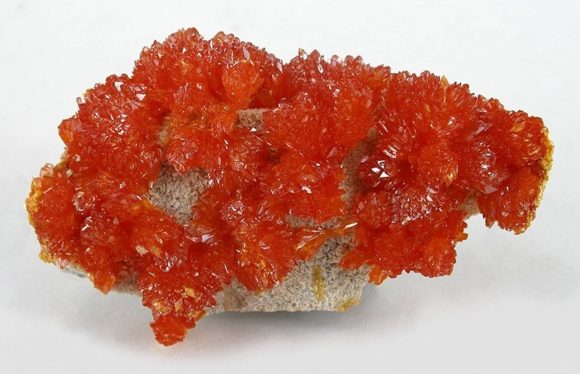
Orpiment from El’brusskiy (Elbrusskii) Arsenic mine, Elbrus, Kabardino-Balkarian Republic, Northern Caucasus Region, Russia – photograph from Rob Lavinsky, iRocks.com.
Orpiment (As2S3) and its cousin realgar (As4S4) are cited as being even more dangerous than arsenic because of the associated sulfur.
We call hogwash on that because when arsenic is chemically bonded with sulfur, it is far less soluble than native arsenic.
Orpiment is slightly soluble in water (i.e. saliva and perspiration), so it should be handled with care, but it is not necessary to be terrified of this mineral. Wash your hands after handling it, and consider using gloves to avoid skin contact.
Realgar, on the other hand, is not soluble. However, with exposure to sunlight, realgar can alter to pararealgar, which forms a dusty coating coating and can be dangerous if inhaled.
2. Arsenopyrite
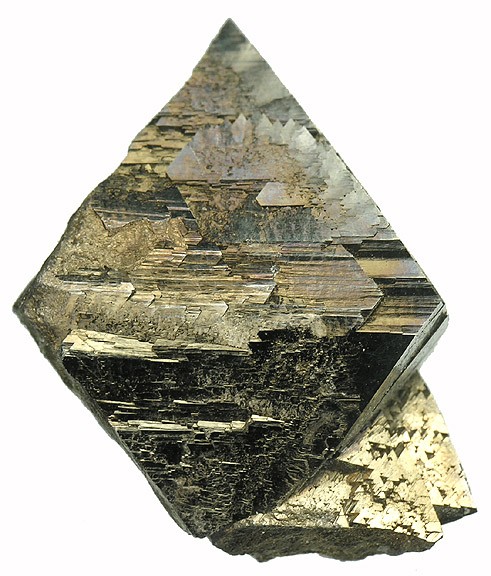
Arsenopyrite from Yaogangxian Mine, Yizhang County, Chenzhou Prefecture, Hunan Province, China – photograph from Rob Lavinsky, iRocks.com.
Arsenopyrite (FeAsS), like pyrite, receives its terror because of its arsenic content.
This time, there is most certainly arsenic in the chemical composition, but like pyrite, arsenopyrite is not soluble in fluids related to the human body and is not dangerous.
However, we’ve included this higher on the list because here is another factor to be very cautious with. There are rumors of arsenopyrite with a white coating that turned out to be a soluble arsenate, which would be very toxic! Minerals can react with other factors in the environment before and after they come into your possession – if your mineral has a crust, coating, powder, or other substance associated with it, that may be an indication that some chemical reaction has occurred. If you find an unknown substance, do not put it into your body!
1. Chalcanthite

Chalcanthite from Planet Mine, Planet Mine group, Planet, Santa Maria District, Buckskin Mts, La Paz Co., Arizona, USA – photograph from Parent Géry.
Chalcanthite (CuSO4 · 5H2O – a hydrated copper sulfate) is one of the few minerals that appears on these lists that is definitely worth some concern – this one could actually kill you.
This mineral is very soluble in both water and hydrochloric acid, which readily releases copper that can then be absorbed by the body and, in large enough quantities, could cause copper poisoning. The good news is that one of symptoms of ingesting chalcanthite is vomiting – one of the first things your body does with chalcanthite is try to spit it right back out. The bad news is that the LD50 for chalcanthite is 30 mg/kg in rats, so roughly 3 grams or 0.1 ounces) in a 220 pound human. It is recommended that you seek medical attention if you ingest chalcanthite, but the easiest method to avoid copper poisioning from chalcanthite? Do not let it get into your body!
We hope this has cleared up some of the common misconceptions about mineral toxicity – the important take away is that the toxicity of a mineral has everything to do with how it’s handled. You do not need to fear minerals. If you practice common sense and take proper precautions, every mineral is absolutely safe! Stay smart, stay educated, and live on to enjoy the beauty of these natural works of art.
(This is technically the end of this article, but for any of you with a burning curiosity to learn more, we’ve included some special mentions below!)
Special Mentions: Inhalation!
A number of minerals have been listed as toxic for risks associated with inhalation of fine particles. The following minerals carry a risk that is quite a bit different from solubility, as the concern is not one of chemical reactions, but of physical damage created by fine particles.
It is important to realize that inhalation of any particulates is not healthy (smoke, air pollution, etc.), and this is no reflection on the danger of a single mineral in particular. If you are handling minerals in a situation where you are creating mineral dusts (lapidary work, for example), it is recommended that you wear a dust mask, or use a liquid component such as water or oil to keep the dust created by grinding from spreading in the air. These precautions are a good practice regardless of what material is being worked. Dust can also be a concern for those who work in mining or collect minerals themselves in the field – again, if you are working in a dusty environment, protect yourself and your lungs by using a dust mask or respirator.
Asbestos
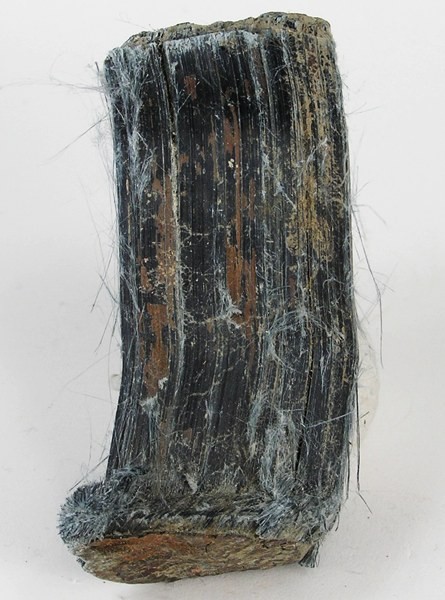
Riebeckite from Prieska, Pixley ka Seme District, Northern Cape, South Africa – photograph from Rob Lavinsky, iRocks.com.
Asbestos itself is not a single mineral, but a name used to describe a number of minerals when they occur in a fine, fibrous form (crocidolite, chrysotile, tremolite, riebeckite, and actinolite are just a few examples).
The danger of asbestiform minerals comes only when particles of them are inhaled – don’t inhale these specimens and you are at no risk.
Erionite
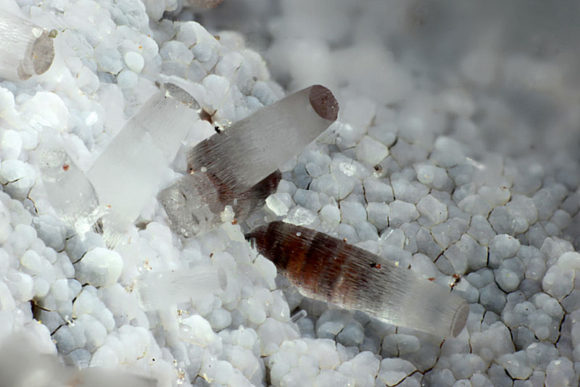
Erionite from Phelps Dodge Corporation Well No. 1, Little Ajo Mountains, Ajo District, Pima County, Arizona, USA – photograph from Matteo Chinellato.
Erionite, another “mineral” that is actually a group of minerals, appears on lists because of its fibrous nature, which reportedly can result in mesothelioma.
Like any other mineral, don’t inhale it! Further, erionite is an uncommon mineral that most people are unlikely to ever encounter.
Quartz
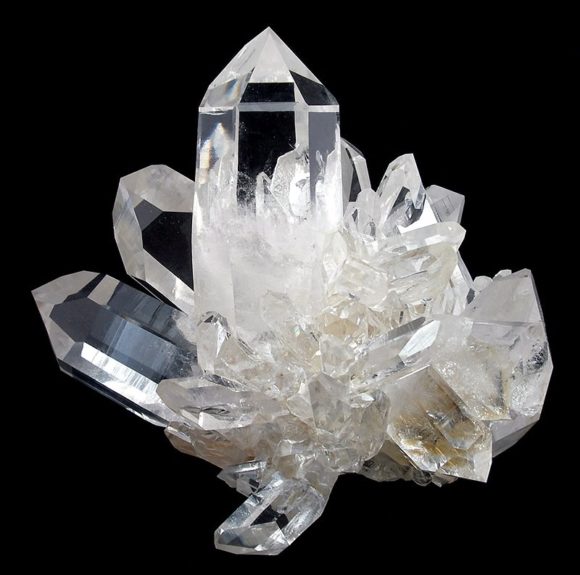
Quartz from East Coleman Mine (Ron Coleman Mine; Old Coleman Mine; West Chance; Dierks No. 4; Blocker Lead; Geomex), Jessieville, Garland County, Arkansas, USA – photograph from Rob Lavinsky, iRocks.com.
Quartz (SiO2 – silicon dioxide), like asbestos, shows up on a few lists due to risks related to inhalation.
Inhalation of quartz dust can cause a disease caused silicosis – however, quartz itself is remarkably durable (unlike asbestiform minerals) and most people are not likely find themselves in a situation where quartz dust is any risk. Handling a quartz crystal itself will not cause any damage (unless perhaps someone chooses to hit you with it), but use caution when cutting and polishing quartz, or when collecting minerals in a dust-heavy environment.
Phenakite
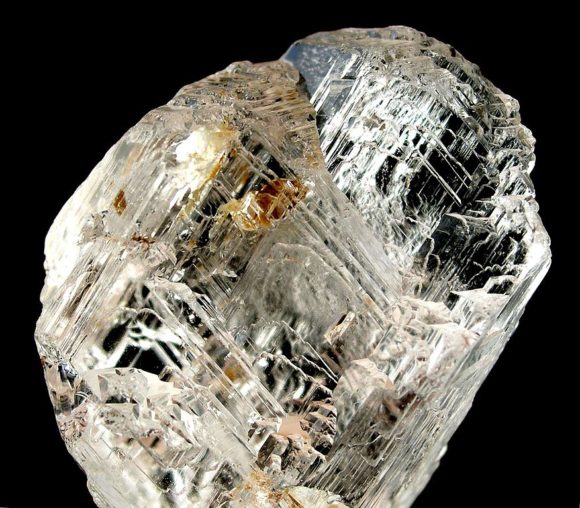
Phenakite from Jos Plateau, Plateau State, Nigeria – photograph from Rob Lavinsky, iRocks.com.
Phenakite (Be2SiO4 – a beryllium silicate) is mentioned on lists for its toxic beryllium content.
Silicates are notoriously insoluble, and phenakite is no exception. However, many beryllium minerals are often cut and polished into jewelry, and those engaging in lapidary work should be cautious of inhaling the dust from these minerals.
Special Mentions: Radioactive Minerals!
Torbernite
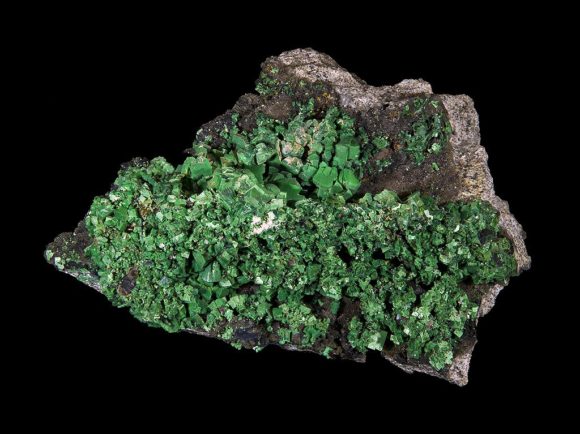
Torbernite from Margabal Mine, Entraygues-sur-Truyère, Aveyron, Midi-Pyrénées, France – photograph from Didier Descouens.
Torbernite (Cu(UO2)2(PO4)2 · 12H2O) makes the list for its uranium content.
Radioactivity is a very complex subject we really don’t have time to delve into here, but if you’re interested in that topic, send us a message to let us know and we’ll look at addressing it in another article! For now, we’ll issue the standard caution: don’t eat them, wash your hand after handling them, and store them in an area with good ventilation and away from your regular daily activities.
K-Feldspar
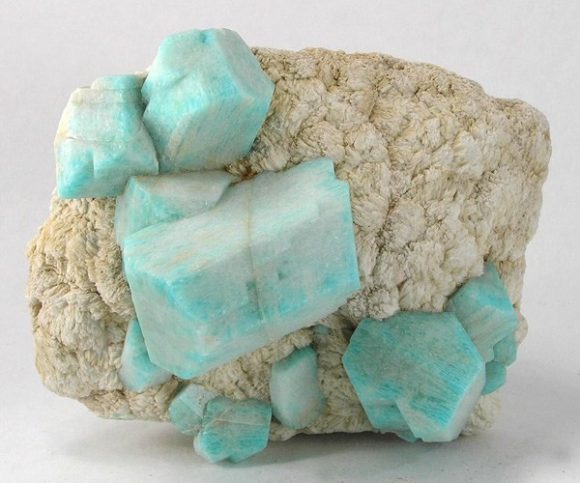
Microcline (var. Amazonite) from Konso, Sidamo-Borana Province, Ethiopia – photograph from Rob Lavinsky, iRocks.com.
Potassium feldspar, or K-feldspar, is a term that refers to potassium dominant feldspars, and are included on lists because they are radioactive.
We still aren’t going to get into radioactivity in this article, but we will mention a few fun facts here:
First: potassium is well known for its radioactive isotope often referred to as K40. However, potassium feldspars are no more radioactive than a banana, which also contains potassium!
Second: potassium feldspars are one of the most abundant groups of minerals on earth.
Third: here’s a mind-blowing spoiler to leave you with: the EARTH is radioactive! That radioactivity is one of the key sources of heat on our planet and part of the reason our planet is habitable.
Recommended for Further Reading:
Clyde Spencer – Mineral Toxicity
John Betts – Water Soluble Minerals
marulla.com – Mineral Solubility
A special thanks to Yoshihiro Kobayashi for his insights into many aspects of chemistry.
Related posts:
The post The Top 11 Toxic Minerals – Lies the Internet Told You appeared first on Where to Find Rocks.
]]>The post Rocks and Minerals Very First Issue! – Free PDF of this Mineral Magazine appeared first on Where to Find Rocks.
]]>This magazine is now and has been for decades, a bold, colorful magazine, since 1979 under the direction of Marie Hunzing.
Back in the 1960’s it was a digest sized black and white magazine with short articles and monthly articles devoted to sand and fossils.
Here is the very first issue, purchased from Alfredo Petrov, who got it from Tony Nickischer, who got it from Peter Zodac’s house.
Rocks_and_Minerals-1926-September
It is a curious document, showing that the first issue was heavy on personal advertising, more of a catalog than a magazine.
Related posts:
The post Rocks and Minerals Very First Issue! – Free PDF of this Mineral Magazine appeared first on Where to Find Rocks.
]]>
